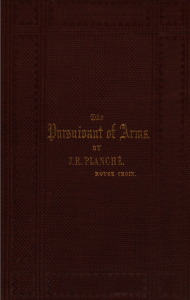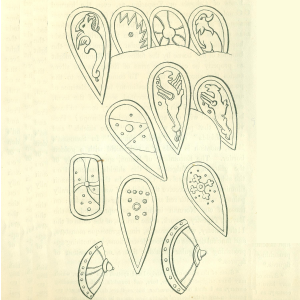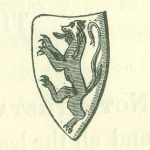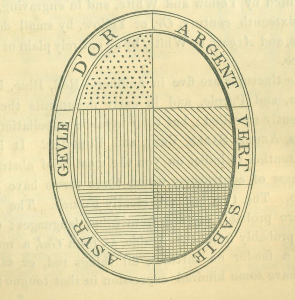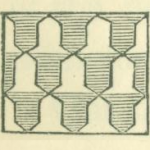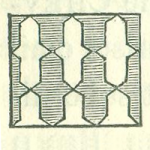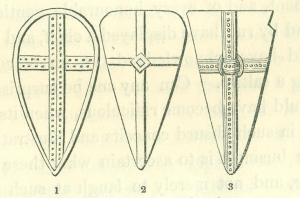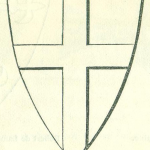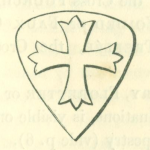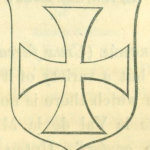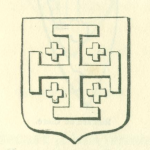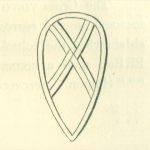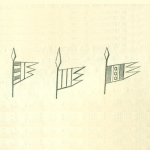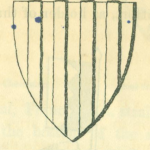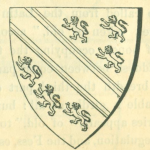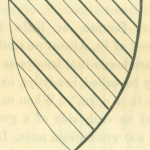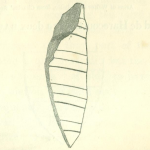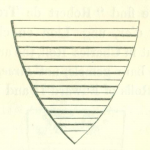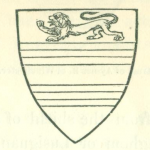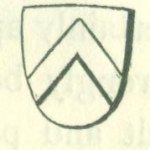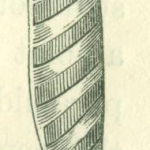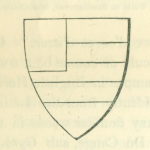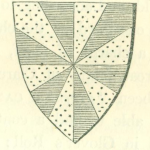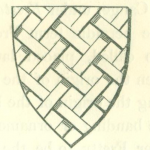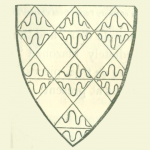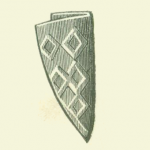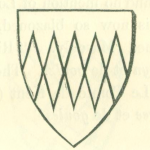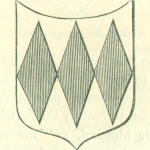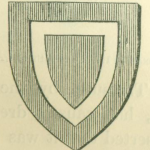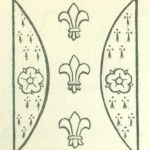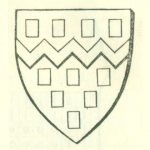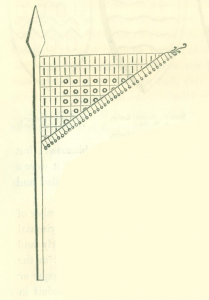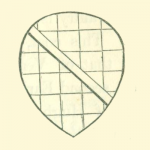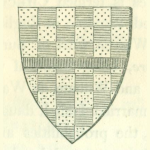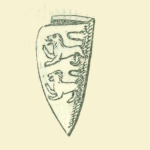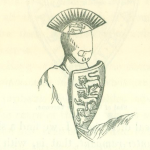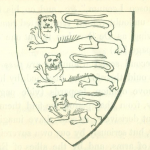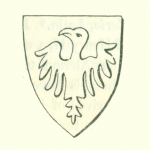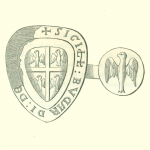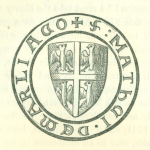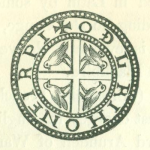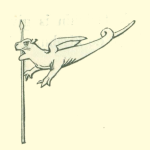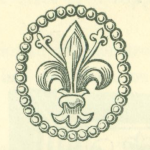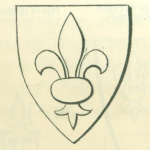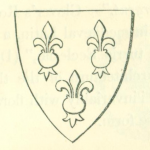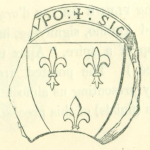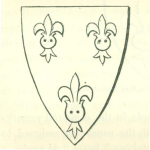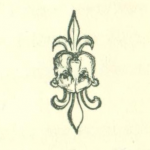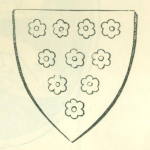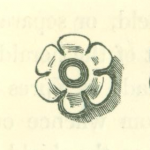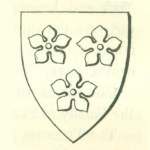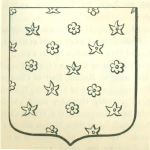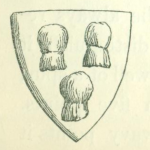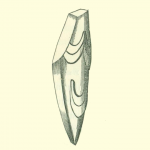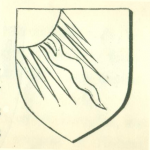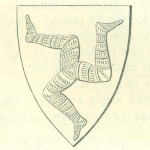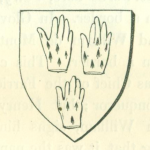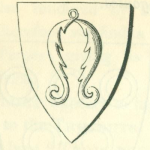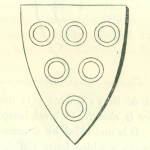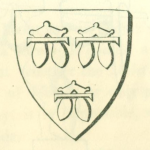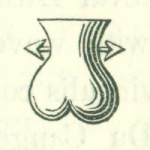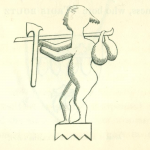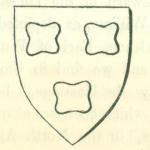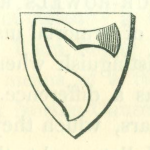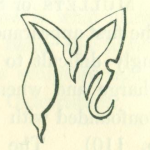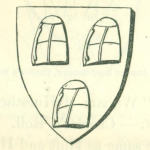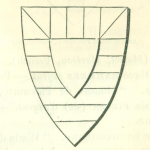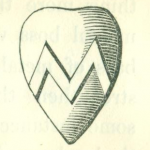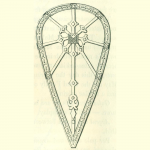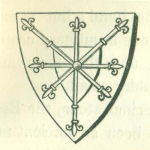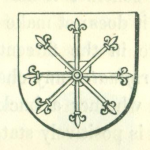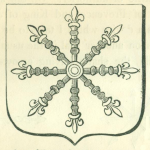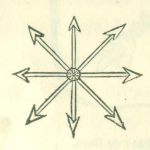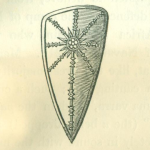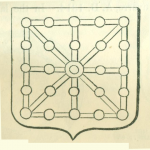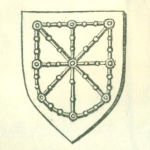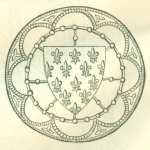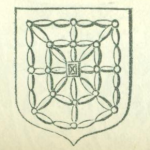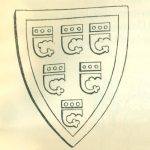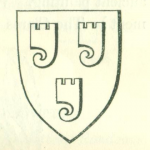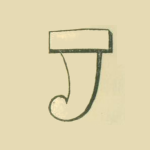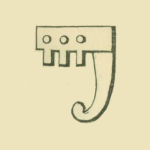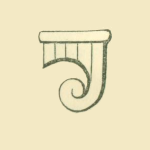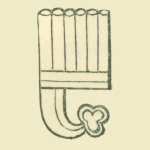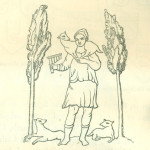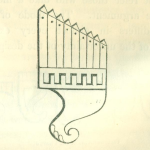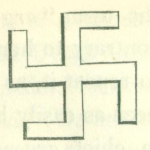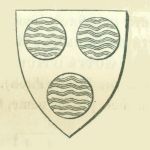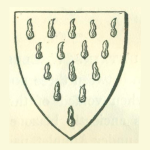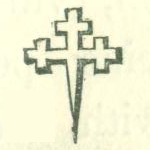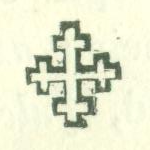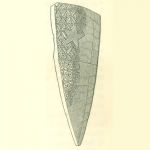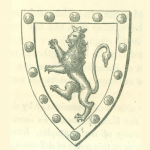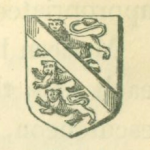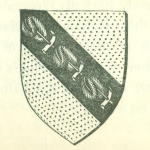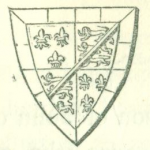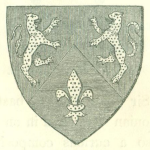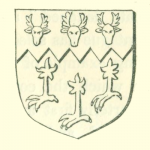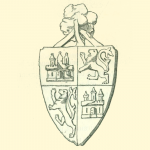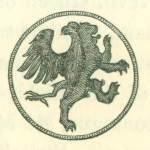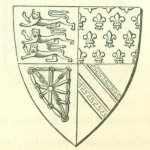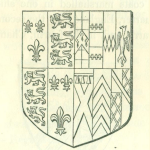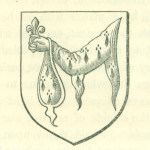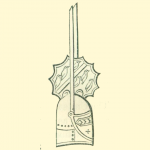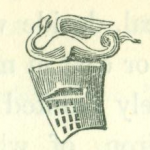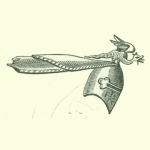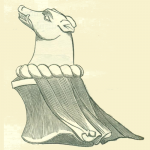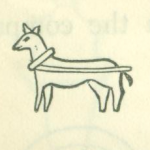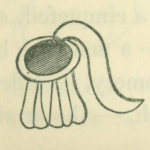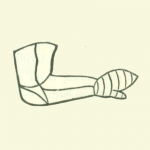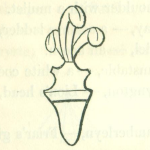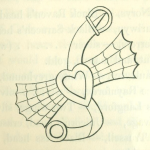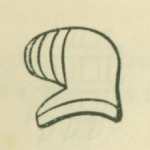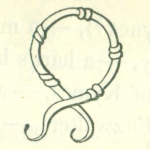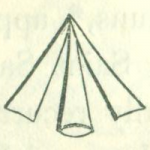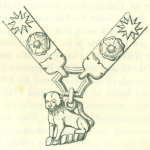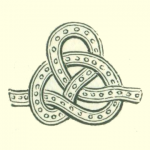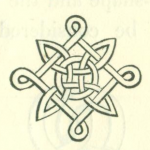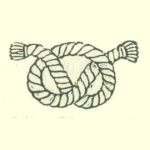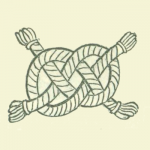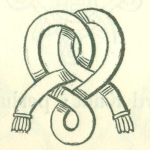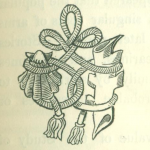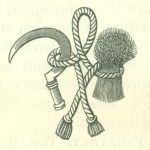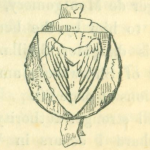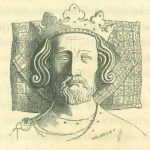Dies ist eine überarbeitete Abschrift des 1859 (ursprünglich 1852) erschienen Buches, “PURSUIVANT OF ARMS” von James Robinson Planché (siehe https://en.wikipedia.org/wiki/James_Planch%C3%A9#Heraldic_career und https://de.wikipedia.org/wiki/James_Planché).
- Prefaces and summaries
- PRELIMINARY OBSERVATIONS.
- THE ORIGIN OF HERALDRY.
- THE SHIELD,
- METALS, TINCTURES, AND FURS.
- THE HONOURABLE ORDINARIES,
- NATURAL AND ARTIFICIAL OBJECTS
- MARKS OF CADENCY,
- BLAZON
- MARSHALLING.
- ABATEMENTS AND AUGMENTATIONS.
- CRESTS AND SUPPORTERS.
- SUPPORTERS
- BADGES.
- CONCLUSION.
- INDEX TO HERALDIC TERMS AND FIGURES.
- INDEX TO NAMES OF PERSONS &c. WHOSE ARMORIAL BEARINGS ARE ENGRAVED OR DESCRIBED.
- APPENDIX.
- Footnotes
- All the pictures in a gallery
THE PURSUIVANT OF ARMS.
THE
PURSUIVANT OF ARMS;
OR,
HERALDRY FOUNDED UPON FACTS.
BY
J.R. PLANCHÉ, ROUGE CROIX.
“My attempt is not of presumption to teach (I myself having most need to be taught), but only to the intent that gentlemen who seek to know all good things and would have an entry into this, may not find here a thing expedient, but rather, a poor help thereto.” – Leigh’s accedence of armorie.
NEW EDITION.
WITH ADDITIONS AND CORRECTIONS.
LONDON: ROBERT HARDWICKE, 192, PICADILLY.
AND ALL BOOKSELLERS.
1859
Prefaces and summaries
To
SIR CHARLES GEORGE YOUNG, KNT.,
GARTER KING OF Arms,
&c. &c. &c.
DEAR SIR CHARLES,
I have much pleasure in inscribing this little volume to you.
A personal acquaintance of nearly five and twenty years might, of itself; have entitled me to the privilege of thus expressing my respect for an able antiquary, and esteem for a worrying man, but as Garter King of Arms, you have a double claim to this trifling tribute, independently of that of private friendship: Firstly, as the principal officer of a Corporation to which my best thanks are due for the courtesy of all, and the assistance of many of its members. Secondly, as one of that body, most competent to judge of the difficulties which beset the study of Heraldic Antiquities, and the real value of the results of such labour. For the latter reason also, I have less hesitation in dedicating to you a necessarily imperfect performance, as your experience will dispose you to excuse, at the same time that it may enable you to correct me.
You are aware I have a theory, and I believe are not quite as satisfied as I am of the soundness of its foundation; but I know that we are equally anxious for the establishment of any facts which may tend to elevate the Science of Armory, and render its study as useful as its devices are acknowledged ornamental.
I trust you will feel in the perusal of these pages, that, however naturally desirous to prove the truth of my position, I have not wilfully strained a point to bolster up an opinion; and that in any strictures upon those writers who have contributed to the mystification and degradation of Arms, I have only been actuated by a sincere desire to uphold the true dignity of the office of Herald, and vindicate a science which I believe has been undervalued because it has not been understood.
Believe me,
DEAR SIR CHARLES,
Your very sincere and obliged
J. R. PLANCHÉ.
Brompton.
PREFACE TO NEW EDITION.
“WHEN I said I would die a bachelor, I did not think I should live tilt I were married,” exclaims Benedict; and most assuredly, when I styled myself a Pursuivant of Arms by my own creation, I had little idea that I should so soon have the honour to become one, “de jure et de facto.”
The copyright of this book having passed into other hands, and a fresh issue being determined on, I have gladly seized the opportunity of correcting some inadvertencies and typographical errors, supplying omissions, and adding such information as I have gathered during the six years which have elapsed since its first publication. The favour with which it was then received by the Press has rendered this revision a grateful task; and my acknowledgments are especially due to the writer of the notice which appeared in the Journal of the Archaeological Institute for March, 1852, for the kind spirit in which he called my attention to the deficiencies, as well as for the very high encomium he bestowed upon the general character of the work. In the notes and illustrations now appended to The Pursuivant, I have gladly availed myself of his suggestions, and endeavoured to answer some of his inquiries, earnestly desiring, for the sake of literature, that every author could meet with so competent as well as so courteous a critic.
J.R. PLANCHÉ, Rouge Croix.
College of Arms.
PREFACE TO THE FIRST EDITION.
READER, commonly called courteous or gentle Reader. I am a Pursuivant of Arms, – extraordinary, being of my own creation, – not vain enough to fancy myself a Herald, nor visionary enough to hope I shall one day become a King. The doors of the College open to me as a harmless enthusiast, not as a worshipful member. I have no tabard to my back, no crown to my brows, no authority, no office: I am guiltless of grants and unacquainted with fees; but I am devoted to the study of Heraldry, and may truly call myself “a pursuivant of Arms,” as I have long and diligently pursued the subject by a path, untrodden I believe by others, though several have crossed the track. Are you inclined to keep me company and see whither it will lead us? For the end, I tell you fairly, is yet to seek. If so, have with you. I will guide you as well as I can, and as far as I know. No great distance, perchance; but I will rather declare my ignorance than wilfully misdirect your steps, for I look upon our journey as one in quest of Truth; and he would ill deserve to find her, who should lie by the way.
LIST OF WOOD-CUTS.
FRONTISPIECE, TO FACE TITLE.
THE Garter Plate of John Beaufort, Earl of Somerset, afterwards Dupe of Somerset and Earl of Kendal. Elected 20th of Henry VI. This is the earliest Garter Plate with supporters, and has been selected as affording a fine example of a complete achievement in the first half of the fifteenth century.
ARMS Quarterly, France and England, a border, gobony or compony, argent and azure.
Cam. A lion, statant regardant, and ducally crowned, or, gorged with a collar, compony, same as the border of the arms.
SUPPORTERS. Dexter, an eagle ducally crowned, or. Sinister, an ibex or antelope, argent. Bezanté, attired, hoofed, maned and tusked, or.
TEE HELM. Or, with MANTLING of crimson velvet, on which may be distinguished two sprigs of trefoil. On either aide, in pale, a large ostrich feather, argent, quilled, compony as the border of the arms.
The whole upon a field, bendy, or, gules, and vert, and bordered with foliage.
PRELIMINARY OBSERVATIONS.
HERALDRY has been contemptuously termed “the science of fools with long memories.” There is more wit than wisdom in the remark, and with the many, a smart saying has unfortunately a great advantage over a just one. The absurd fancies of writers, who have furnished even Adam with a coat of arms, and would give as many quarterings to Noah as might satisfy a Count of the Holy Roman Empire, are fit subjects for ridicule; but the abuse of an art can never, amongst thinking men, lessen the use of it; and until all respect for high and noble deeds shall be destroyed on earth, an art which assists to perpetuate the remembrance of their enactors can never truly be called “the science of fools.” Heraldry is the short-hand of History. In its figures, properly interpreted, we read the chronicle of centuries. If a knowledge of History be a desideratum in the education of youth, surely nothing that tends to facilitate its acquirement and increase its impression can be considered vain or worthless. In place of branding Heraldry as the science of fools, ought we not rather to consider it as one which, properly directed, may render even fools wise? Would not a general knowledge of the arms of our principal ancient English families form a sort of artificial memory for the young student of English History, and give additional interest to the details of the deeds of those who bore them: of events in which the founders of those families were actors? The funeral escutcheon, the passing equipage, the monumental tablet, would they not in return daily, almost hourly, recall to his mind the history of those who first assumed or acquired the devices thereon depicted? Such an opinion is, I rejoice to say, gradually becoming general. Indeed, it was the frequent inquiry of parents “Can you recommend me a work on Heraldry ?” which induced me to imagine, that one founded on facts alone, might find favour in the eyes of those who desire truth above all things, and who, to speak the truth, are the only persons I ever had much care to please. Disclaiming, therefore, all intentional offence to previous writers on these much-vexed questions, I start with the declaration that as I have implicitly believed nobody, I desire not that any one should blindly credit me; but form his own conclusion from the evidence I may succeed in producing; rating mere speculations (for he will find some of my own) at their lowest value. And now, having made my profession of, anything but, faith, let us begin at the beginning by ascertaining if possible where that beginning may begin. Certainly not quite so early as the ingenious Sylvanus Morgan would have us believe, in his anxiety to prove Adam a gentleman, nor with the reign of Alexander the Great, notwithstanding Sir John Ferne quotes Aristotle in support of his assertion, nor in the times of Caligula or Vespasian as, even the learned Camden says, may perhaps be inferred from the expressions of Suetonius. There can be no doubt that nations as well as individuals have from the earliest periods been distinguished by particular ensigns: but the bundles of hay borne by the followers of Romulus might as properly be called the arms of Rome, as the silver eagles that succeeded them. To come at once to the point. Have we any direct testimony to the existence of armorial bearings in the accepted sense of the terra, earlier than the 12th century, when they seem to have been adopted with one accord throughout Europe? Previous to that period we read of “white shields” and “red shields “and “gilded shields.” In Saemund’s Edda, mention is made of a red shield with a golden border. The Encomiast of Emma, speaks merely of the glittering effulgence of the shields suspended on the Bide of the vessels of Canute. In the Anglo-Saxon illuminations we perceive the shields of warriors generally painted white, with red and blue borders and circles: on those of our Norman invaders, as represented in the Bayeux Tapestry, a work, at the earliest, of the close of the 1 lth century, we find crosses, rings, grotesque monsters, and fanciful devices of various descriptions, but nothing approaching a regular heraldic figure, or disposition of figures.1
Anna Comnena, in the life of her father Alexius, thus minutely describes the shield of the French knights at this period. “For defence they have an impenetrable shield, not of a round but of an oblong shape, broad at the upper part and terminating in a point, the surface is not flat but convex, so as to embrace the person of the wearer and the exterior face is of metal so highly polished by frequent rubbings, with an umbo (boss) of shining brass in the middle, as to dazzle the eyes of the beholders.” Here is the strongest possible contemporary evidence that at this period (1081 – 1118) the shields of the mort chivalric nation of Europe presented a face simply of polished metal. Robert of Aix, who was also present at the first crusade (1096 – 1101) though he speaks of the shields being resplendent with gold and gems, and painted of various colours, makes no mention of Heraldic devices.
The curious Spanish MS., recently acquired by the British Museum, executed in the monastery of Selos, diocese of Burgos, and completed in the year 1109, presents us with round shields, plain and ornamented, but nothing approaching to armorial bearings.
The shields of the leaders of the second crusade represented in the famous painted windows of the Abbot Suger, formerly in the Abbey of St. Denis near Paris, and executed of course after 1147, were also, if we may trust the engravings of them in Montfaucon, for the originals have, alas, disappeared, devoid of Heraldic insignia. The third crusade began in 1189, when Heraldic devices had already made their appearance. The seal of Philip I, Count of Flanders, of the date of 1164 is the earliest unquestionable example, in the collection of Vredius, on which the lion appears as an heraldic bearing. His cylindrical helmet is also emblazoned with a demi-lion rampant, whilst the seal of the same Count, to a document of the date 1157, as if on purpose to mark the circumstance more strongly, is without any device. Of this same period, the latter half of the 12th century, are the Heraldic Fleur-de-lys of France, and the Lions or Leopards of England.
Yet in the face of these facts, some of the most learned and laborious of our heraldic writers, have gravely furnished us with the arms not only of the Anglo-Saxon monarchs, but of a long line of British Kings, as visionary as those in Banquo’s glass, up to Brute or Brutus, the fabled grandson of Aeneas, who wandering in Bretagne in France, fell asleep, and on waking found an ermine upon his shield, whence we are requested to believe the Dukes of Britanny derived their arms: and not contented with giving this story as a legend, Sir George Mackenzie states it as an historical fact, and says “from that time Brutus wore a shield ermine.” What credit then can we give to a writer who invents or propagates so gross a falsehood? How can we believe upon his unsupported authority, statements which have not even possibility in their favour? The most extravagant of these fancies have been exposed, or passed over in silence, by later writers: but to a more early existence of Heraldry than I have yet found authority for, some even in the present day cling with great pertinacity.
THE ORIGIN OF HERALDRY.
Notwithstanding all the ink that has been shed, and all the learning that has been displayed in the controversy, the origin of Heraldry is still but conjectural, its first resolution into a science without an authenticated date. It has been attributed with the almost general consent of every rational writer on the subject, to the necessity for distinguishing the principal leaders during the crusades, and the conjecture is natural enough, when we consider the confusion likely to have occurred through the junction of so many powers on the plains of Palestine – the commingling of all the streams of chivalry, that flowed by every channel from every part of Europe into Asia during the holy wars. Still it is but a conjecture, and if a correct one, it may first be asked, how is it that so important and remarkable a circumstance should be unrecorded by the minute chroniclers and veracious painters of the times, to whom from their peculiar tastes and habits, it must have been as interesting as it was novel ? But there is a still greater obstacle to the reception of that hypothesis in the fact, that the evidence of the best authorities of that period, which have survived to us, both writers and painters, goes directly in disproof of any such science or practice existing at least during the two first crusades, and the third did not commence till the year 1189, before which period, as I have stated, heraldic devices had already made their appearance. At the same time, be it fully understood that, although not a believer to the same extent as many, in the round assertion, unsupported by any contemporary authority as yet discovered, that Heraldry owes its origin to the crusades, I by no means dispute the influence of those expeditions upon the dawn of it; as it would be impossible to look upon the bearings of our ancient nobility, or upon any treatise upon armory, without being struck by the emblems of holy warfare and pilgrimage, the traces of Oriental language and the representation of natural and artificial objects of Asiatic production. I simply confine myself to the fact, that an authenticated date for the origin of Heraldry, or, to speak more strictly, armorial bearings, has yet to be discovered.
Let us first examine what are the materials we possess for its History and illustration. Our earliest heraldic information is derived, at present, from a copy made in 1586 by Glover, Somerset Herald, of a roll of arms of the reign of Henry III,2 that is to say a list or catalogue of the arms borne by the Sovereign, the Princes of the blood, and the principal Barons and Knights of England, between the years 1216 and 1272, the original having unfortunately disappeared. The arms are not drawn; but only blazoned, the term used by Heralds for verbally describing the figures and colours in a shield, (see under BLAZON). This roll, therefore, for the authenticity of the copy was not doubted by Sir Harris Nicolas, who considered the original compilation to have been made between 1240 and 1245, furnishes us with a multitude of examples of the earliest regular armorial bearings of our Anglo-Norman nobility, blazoned correctly, and comprising nearly el the principal terms in use at the present day. Heraldry had become a science and arms hereditary. For brevity as well as distinction, I shah call this document “Glover’s Roll.”
In a volume of MSS. in the Harleian collection, British Museum, numbered 6589, is the copy of another roll of the same period, i.e. the middle of the 13th century, in which the arms are drawn in pen and ink (tricked as it is called), by Nicholas Charles, Lancaster Herald in 1607, from the original, which he states in a note, was lent him in that year “by Mr. Norry” (Norroy King of Arms). It contains nearly seven hundred coats, and is exceedingly valuable for the ancient forms of some of the charges delineated. This document I shall distinguish as “Charles’s Roll.”
The Roll of Kaerlaveroc is an Heraldic Poem in old Norman French, recounting the names and arms of the Knights at the siege of Kaerlaveroc Castle, with Edward I, A.D. 1300. From the incidental observations of the writers we gather a fund of information respecting the ancient usage of bearing arms, which in some important points differed exceedingly from the modern. This Roll has been published with valuable remarks by the late Sir Harris Nicolas.
Copies of Rolls are to be found in the College of Arms, and at the British Museum of “the Knights with Edward I, at the Battle of Falkirk;” (that one in the Harleian Collection, 6589, having been taken out of the Treasury Chamber in Paris, where the records were kept in the year 1576,) and of those who were at the Tournaments at Dunstable, 2nd of Edward II, 1309. An original roll of arms of the reign of Edward II, nearly of the same date as the last (1306 – 1314) is preserved in the Cottonian Library, British Museum, marked Caligula A. XVIII, and, one of the names and arms of those slain at Boroughbridge, 15th of Edward II, (1 321) in the Ashmolean MSS. Oxford, No. 731.
Copies of Rolls of the time of Edward III, and of Richard II, have been published by Sir H. Nicolas and Mr. Willement; and the arms of the Knights who were with Edward III, at the siege of Calais by Mr. R. Mores.
But up to this period, the close of the fourteenth century, we are without any work explanatory of the science, except a short treatise in Latin, entitled “Tractatus de Insigniis et Armis,”written by Doctor Bartolus de Saxoferratus,” (Sassoferrata) about the year 1353, and published by Sir Edward Bysshe in 1654.
A work in Latin by a writer styling himself Johannes de Bado, or de Vado Aureo, presumed to be one John of Guildford, and who acknowledges himself indebted to his master Franciscus de Foveis, or François des Fossés, is the earliest systematic treatise I have seen. It appears by the preface to have been written during the reign of Richard II, as he states it to have been compiled expressly for the late Queen Anne, Richard’s first wife, who died A. D. 1394. The arms of France, being blazoned with only three fleurs de lys, shows the work to have been completed after the reduction of the flowers to that number by Charles VI, father of Richard’s second Queen, Isabella. It was published by Sir Edward Bysshe in 1654, in conjunction with the more elaborate and better known treatise, also in Latin, by Nicolas Upton, a Canon of Salisbury and Wells, who wrote about 1441; and a translation, or rather paraphrase of a portion of Upton’s work called The Book of St. Albans, printed in 1486, completes the slender list of what may be called contemporary authorities; for with the decline of chivalry commenced the corruption of heraldry, and its officers first incorporated by Richard III, in 1483, in little more than a century, saw their science ridiculed and their authority defied. Its downfall was accelerated by the pedantic nonsense of Leigh, Morgan, Ferne, and other such writers. Camden, truly called the learned, being left almost “alone in his glory” by the herd of affected and bombastic armorists, for whom no tale was too idle, no fable too preposterous.
Had half the ingenuity and industry been exerted to discover the real origin of Armorial Insignia, which has been wasted upon inventing stories to account for them, what service might have been rendered to history, what light thrown upon genealogy and biography 1 How many a document has disappeared, or utterly perished, which was accessible to the authors of the 16th and 17th centuries, who have used their pens but to mystify or disgust their readers. Their absurdities are tempting game, but they have been recently run down by Mr. Lower, of Lewes, in his amusing work “The Curiosities of Heraldry,” and I must limit my notice of them to a brief exposure of the most mischievous, as they arise before us.
I have shown you that we have no systematic treatise to guide us of an earlier date than the close of the fourteenth century – Two hundred years after the general adoption of armorial ensigns throughout Europe! In that treatise no authorities are quoted – all is assertion unsupported by a shadow of evidence, and consequently only valuable to us as an illustration of the belief then prevalent, and of the practice of bearing arms at that period. We must, therefore, found our observations on facts discoverable amongst much earlier documents. – The armorial bearings themselves, handed down to us impressed on the seals of the Anglo-Norman nobility, (of which a valuable collection exists, appended to the duplicate of the letter of the Barons of England to Pope Boniface VIII, in the reign of Edward I, A.D. 1301) – the pictorial and sculptured decorations they bequeathed, and time has spared to us, and the incidental allusions contained in the general literature of the twelfth and thirteenth centuries.
The word Heraldry is on my title page, and I shall continue to use it in compliance with modern custom, but as I have before remarked, it is not strictly the proper name for the subject we are discussing. ARMORY, is the word used by many of our early English writers and with much more propriety. The regulation of Armorial bearings (Armoiries, French,) being only a portion of the office of the Herald, the science of Heraldry including the knowledge of every duty devolving on such an officer – namely, the marshalling of processions and conducting, the ceremonies of coronations, installations, creations of peers, funerals, marriages and the proclamation of war or peace – and during the middle ages, the bearing of letters and messages between royal and knightly personages, whether of courtesy or defiance. The superintendance and registration of trials by battle, tournaments, joustings and all chivalric encounters. The computation of the dead after conflict, and the recording of the valiant achievements of the fallen or the surviving combatants. The origin even of the name of Herald is hotly disputed. Its most probable derivation appears to be from the Greek ?? (the Fecialis of the Romans) whose functions were in many respects identical with the Herault or Heraut of the French. But the word heraldus, as applied to an officer of arms, has not yet been discovered in an earlier document than the Imperial Constitutions of Frederick Barbarossa, A.D. 1132, nearly coeval with the first indications of Armorial devices.3
The most laborious research – the most patient investigation has failed as yet in producing an authority for a truly called armorial bearing in England previous to the second crusade, A.D. 1147. But devices of rude execution and capricious assumption were undoubtedly in use amongst the Normans, as we find not only by their shields in the Bayeux Tapestry; but by the Anglo-Norman poet, Wace, who intimates that the fashion was peculiar to them. “They had shields,” he says, “on their necks and lances in their hands, and all had made (or adopted) cognizances,4 that one Norman might know another by, and that none others bore; so that no Norman might perish by the hand of another, nor one Frenchman kill another.” And this important assertion is supported by the fact, that in the Bayeux Tapestry before mentioned, the shields of the invaders alone display the figures of animals, those of the Saxons being simply ornamented with borders or crosses. I must also call your attention to the circumstance that Wace wrote this poem in the time of Henry II, whose reign commenced in 1154, and had regular armorial bearings been at that period in existence, he could scarcely have refrained from alluding to their derivation from the barbarous devices of the Norman invaders. In the eleventh and twelfth centuries we find, therefore, mention only of “devises” or “cognoissances;” but such ensigns having been adopted by warriors, and to decorate the shields and banners they bore in battle, we soon find the term “arms” applied to them, and the expression “il porte,” “he bears” such or such arms. The fashion of embroidering them on the surcoat of silk or other rich material worn over the hauberk or coat of mail, which became general during the thirteenth century, introduced the well known terms, “a coat of arms” and “coat armour,” the other familiar word, “escutcheon,” being derived from the French écusson, a shield of arms, in distinction to écu, which simply signifies a shield, whether plain, sans devise, or chargé, charged, with one or more figures or devices. Let us begin therefore with
THE SHIELD,
and ascertain its form about the period when it was first decorated with armorial devices. The shields of the Normans have been compared to a boy’s kit,e, and are supposed to have been assumed by them in imitation of the Sicilians, as fifty years before the conquest of England, Melo, the chief of Barri, furnished them with weapons and twelve years afterwards they conquered Apulia. A comparison of the shields in the Bayeux Tapestry, and on the early seals of the Anglo – Norman barons, with those of some Sicilian bronzes in the collection of the late Sir S. Meyrick, leaves little doubt of the fact: but before it became adorned with regular armorial bearings it had been considerably shortened, and instead of being flat was more or less bent round, till in some instances it was nearly semi-cylindrical, so that, if properly drawn or engraved, not above hall* the ornaments upon it would at times be visible. I would have you bear this fact in mind, as it is important to future illustrations. But the heraldic shield when engraved for impression, on the secretum or counter seal of the owner, was of course represented flat, that the entire arms should be seen; and as early as the reign of Henry III, it assumed the triangular or heater shape, which greatly influenced the disposition of the figures.
Our second inquiry must be concerning the colours of the Ground or Field of the shield, le Champ, which more early divided into three classes; namely,
METALS, TINCTURES, AND FURS.
The metals are Gold, termed OR, and Silver, ARGENT, from their common names in French; -in painting represented by Yellow and White, and in engraving, since the sixteenth century, Or, or Yellow, by small dots or points, and Argent, or White, by an entirely plain or blank surface.
The tinctures are five in number-Red, Blue, Black, Green, and Purple, and in early documents they are frequently so called; but their heraldic appellations are
GULES, AZURE, SABLE, VERT, and PURPURE. It is not my intention to inflict on you the most brief abstract of the mass of controversy which these terms have given rise to. The two last are clearly French. The three first are probably derived from other languages; Gules most probably from the Arabic, as from Gul, a rose, to Ghia, a feeder on carcases, all things red, or sanguinary, have some kindred expression in that tongue; but I have no fact to offer in evidence, and will not waste your time in discussing the mere speculations of others. Gules, or Red, is expressed in engraving by perpendicular lines; Azure, or Blue, by horizontal lines; Sable, or Black, by perpendicular and horizontal lines, crossing each other; Vert, or Green, by diagonal lines from right to left; and Purpure, or Purple, by similar Lines from left to right. This useful mode of indicating colour is said to have been the invention of an Italian, Father Silvestre de Petra Sancta; and the earliest instance of its application in England, the engraving of the death-warrant of Charles I, to which the seals of the subscribing parties are represented attached. The annexed arrangement of. examples (Purpure omitted) is engraved from Sir Edward Bysshe’s edition of Upton, before quoted, date 1654.
FURS.
The Furs appear anciently to have been but two, ERMINE and VAIR.5
Ermine is well known, and is tolerably represented in heraldry by black spots on a white ground. Here are two examples, No. 1 being the most ancient and most natural.
Vair was a fur much used for lining the mantles of noblemen and official personages of high rank in the middle ages, and is said to have been taken from a species of squirrel, which was blueish grey on the back, and white on the belly, and called in latin varus on that account.
In heraldry it is now represented by shield, bell, or cup-shaped figures, blue and white alternately, ranged in horizontal rows, so that the base of the white one rests on the base of the blue. If the Vair was of any other colour and metal it was specified; as, for instance, the arms of the Earl Ferrers are blazoned in Glover’s roll, “VERRÉE de or et de goules,” and those of his brother Hugh (who according to the same authority bore vair also) are, to ensure correctness, blazoned “VAIRÉE de argent et d’azur,” which would not be necessary under other circumstances. The original form of the vair was less precise both in the outline and arrangement. Here is an example from the copy of a roll of Edward the First’s time of the arms of the Earl Ferrers above mentioned. See also the cross pattée vair of the Earl of Albemarle, p. 28.
In the course of time the necessity for distinguishing the continually encreasing number of coats introduced six or seven other varieties of Furs, viz. ERMINES, or as the French more correctly term it, contre-ermine, the field being sable and the spots argent; ERMINOIS, the field or and the spots sable; ERMINITES, the same as ermine, but with a red hair on each side of the black spots; PEAN, the field sable and the spots or; VAIR EN POINT, when the point of one vair is opposite to the base of another; COUNTER-VAIR, when those of the same tincture are placed base against base, and point against point; and POTENT COUNTER-POTENT, in which the field is filled with crutch-shaped figures, counter placed like those of vair;
Potent, being an obsolete word for crutch. All these varieties of vair are understood to be composed of argent and azure if not specially blazoned otherwise.
- Counter Vair.
- Potent Counter Potent.
One of the most important rules in heraldry, and which has evidently existed from its commencement, is the interdiction against putting colour upon colour, or metal upon metal. The reason is obvious; distinctness was the grand and primary object of armorial bearings, which were intended to announce the owners as far as the eye could reach. The egregious absurdity of considering that certain tinctures typified the virtues or dispositions of the bearer, requires no other refutation than the contradictory assertions of the pedantic essayists themselves.
Our next step I think should be to ascertain as far as possible the derivations of the earliest armorial bearings, which became hereditary, and have descended to the present day, under certain heraldic appellations.
Putting aside, therefore, for the present, the figures of animals and well known natural objects, respecting which there can be no dispute, I will at once proceed to those which have received from later heralds the affected appellation of
THE HONOURABLE ORDINARIES,
so called, it would appear, from such bearings being the most ancient, as well as the most common, amongst the various cognoissances, which ultimately became hereditary. They are nine in number, the CROSS, the SALTIRE, the CHIEF, the PALE, the BEND, the FESS, the CHEVRON, the PILE and the QUARTER. Some armorists omit the pile and the quarter, classing them amongst subordinate ordinaries, and place in their stead the BEND SINISTER and the BAR; but as the two latter are merely varieties of the bend and the fess, I prefer the enumeration above-mentioned. Of these, all but the pile, we can find traces in the shields of the eleventh and twelfth centuries, on which they appear, not as armorial ensigns, but as the necessary wooden or metal strengthenings of the shields themselves, in some instances more ornamental than in others, and no doubt gilt, silvered, or painted in the gayest colours, according to the fancy of the bearer.
This, however, was much too simple a fact for the writers on heraldry, or perhaps the heralds themselves, and the most absurd as well as contradictory meanings have been attached to each of these figures, some fanciful authors asserting that they represented the various habiliments of a knight, as for instance, the chief, his helmet; the saltire, his sword; the pale, his spear; the bend, his scarf; the fess, his girdle, and the chevron, his spur! Others that they were symbols of the crucifixion, including the lance, which pierced the side of the Saviour, the nail which fastened his feet, &c., whilst others again contend that they typified certain ranks or qualifications. The chief, says Leigh, signified “a senator or honourable man,” and, following Upton, he tells you that the saltire was an engin to take wild beasts, and therefore given to rich or coveteous people, such as would not easily depart from their substance.” I need scarcely point out that had such been the facts, the shield of every baron summoned to parliament, and of every honourable gentleman, must of right and by rule have displayed a chief, and that few, if any, would have acknowledged the sin of covetousness by bearing a saltire. Can any one be surprised that heraldry should have become ridiculous, when its professors luxuriated in such absurd conceits and illustrations.
But our business is to ascertain what these ordinaries really were, and not merely to laugh at such phantasies. To begin then with
The CROSS: admitting that nothing was more common in the early days of Christianity than to paint crosses of different forms upon the shield, or embroider them on the standard, and that numerous instances may be produced from illuminated manuscripts previous to the Conquest, the Bayeux Tapestry, and other authorities, of such a practice being continued to the period when heraldry burst upon the chivalric world in its full glory; most of the peculiar crosses which form regular heraldic figures are to be traced to the metal clamps or braces required to strengthen and protect the long kite-shaped shield of the eleventh and twelfth centuries. Leaving however the varieties to be illustrated under their proper heads, I will merely point out to you some early examples of the PLAIN, or ST. GEORGE’S CROSS as this ordinary is always understood to be. They occur on the shields of a set of chessmen of the twelfth century, discovered in the Isle of Lewis, and engraved in vol. xxiv of the Archaeologia, with a most learned and elaborate description by Sir Frederick Madden.
No. 1 presents us with a plain cross composed of four narrow pieces of wood or iron, two being perpendicularly and two horizontally nailed or rivetted close to each other, (the heads of the nails or rivets plainly appearing) the outer edge of the shield being defended by a border, no doubt of metal.
No. 2 exhibits a plain cross, apparently of metal, fastened in the centre by a nut or plate pierced in the centre, and forming what heralds call a mascle.
No. 3 displays a richly ornamented cross, the transverse pieces being interlaced and surrounded by a ring, in heraldry termed an annulet. It is surely impossible to examine these shields and not to admit that the holy symbol of redemption was peculiarly adapted by its form to give strength to them, and to rivet or clamp together the double layers of boards, of which, according to existing evidence they were composed.
As an heraldic example here is the coat of John de Boun (Bohun), from the Roll, temp. Ed. I.
The earliest varieties of this ordinary are the
- Cross FLEURY, FLORETTÉE or FLURTY,
- the Cross PATONCÉE,
- the Cross PATÉE,
- the Cross FOURCHÉE,
- the Cross MOLINE,
- the Cross VOIDED or FAUX CROIX,
- the Cross BOTTONNÉE or TREFLÉE,
- the Cross POMETTÉE or BOURDONÉE.
The Cross FLEURY, FLORETTEE or FLURTY, so called from its floral terminations, is visible on one of the shields in the Bayeux Tapestry (vide p. 6). That such crosses were ornamental clamps is evident from the shield of Helie, Comte de Maine, engraved in Montfaucon’s Monarchie Française. In Glover’s roll we find “John Lamplowe, Argent ung crois sable FLORETTE,” the ex-ample is here given from the coat of Robert de Lamplowe, temp. Edward I.
The Cross PATONCÉE is sometimes called PATEE, and occasionally confounded with FLEURY.
“William de Vesci, goules a ung croix PATONCEE d’argent.” Glover’s Roll. The example is here given from the seal of William de Vesci, A.D. 1220.
The Cross PATTÉE. “Le Comte d’Aumerle de goules ung croix PÂTE de verre.” – Glover’s Roll. Here is an instance that the cross patoncée was called pattée in the thirteenth century, as the arms of William de Fortibus Earl of Albemarle, temp. Henry III, are still extant, both in the embroidery and sculpture of the period, and the cross in every instance of the shape termed patoncée. Query, who is in error, the scribe or the artist ?
The term patté is derived from the Latin pateo, to be spread, and is applied to a cross, the limbs of which are broadest at their extremities. This sort of cross is discernible on the standard of King Stephen. The indenting of its terminations may have originated in a caprice, and been subsequently designated by a term derived from the same root.
The Cross MOLINE, MILL-RIND, or FER DE MOULIN, is a term given to a cross with bi-parted and convoluted terminations, like the cruciform pieces of iron upon a millstone. “Azure, a cross MOLINE or,” are the armes parlantes of the noble family of DE MOLINES or MOLYNEUX, Earl of Sefton; and in the Roll of Edward the First’s time we have the subjoined example of the coat of GUY FERRE, “Gules, a FER DE MOULIN, argent, over all a bendlet, azure.” The modes of representing the cross moline, or mill-rind, are endless.
The Cross FOURCHÉE (Cruz furcata, John of Guildford) seems to me but a variety of it. The term occurs in Glover’s Roll, in which there is no mention of a cross moline, “Gilbert de la Val de la Marche, d’argent, ung croix FOURCHE, de goules.” Upton differs from John of Guildford in his notion of the figures.
The Cross BOTTONÉE, (Cruz nodulata, John of Guildford), sometimes called TREFLÉE, from its trefoil terminations is another fanciful variety of the cross fleury, and appears on the shield of Richard de Clare Earl of Hertford 1259-1262. Vide drawing of his seal, Cotton. MS. Julius C. 7.
The Cross POMEL, POMETÉE or BOURDONÉE, terminating in single knobs or pomels, like the Bourdon, or Pilgrim’s staff. The example here given is from an early one of the arms of Jerusalem as a Christian kingdom.
To these varieties I may add
The Cross POTENT, so called because it is crutchshaped at each extremity, as in later examples of the arms of the kingdom of Jerusalem, Argent, a cross POTENT between four crosslets Or, (a departure from the rule prohibiting metal being placed on metal.)
The Cross CROSSLET or crossed, is another variety sometimes borne singly as a charge, but more generally in numbers. See more of the Cross Crosslet under DIFFERENCES.
The Cross VOIDED, sometimes called CLECHÉE, from some fancied resemblance to a key, is simply outlined, showing the colour or metal of the field. In Glover’s Roll such a cross is called FAUX CROI S or false Cross. “Hamon Crevecoeur d’Or ung FAULX CROIS de goules.
The list of comparatively modern varieties of this ordinary is almost interminable, and the confusion created by difference of opinion amongst heraldic writers as to their proper appellation, would encrease the tediousness of their enumeration. Edmondson, under Cross, has no less than 107 articles. Even old Leigh exclaims in his proper person to his imaginary instructor; “You bring in so many crosses, and of so sundry fashions, that you make me in a maner werye of them.” Before you are weary of them, Reader, if you be not so already, I will proceed to the second ordinary.
THE SALTIRE or ST. ANDREW’S CROSS.
A specimen of this ordinary is also to be found on the shield of one of the chess-men before mentioned. It is composed of four pieces of metal banded together and interlacing each other in the centre. The word SALTIRE is derived from the French Sautoir, in the old Norman orthography, Saultoir. The explanation of Upton, that it was an engine to take wild beasts, is only so far justified that a gate of that form was used to prevent the egress of deer or cattle.6
This gate is apparent in the badge of Richard II, of the hart lodged in a park, in the sepulchral slab of Thomas de Mowbray Duke of Norfolk, discovered at Venice, 1839, and engraved in the Archteologia, vol. 29. “In fact,” says Menestrier, “a wood and a park were formerly called des Saults, and in latin Saltus.” In an ancient MS., temp. Edward I, respecting tournaments, a squire is forbidden to have a “sautour” to his saddle. (Harleian, No. 6149). Menestrier quotes the same passage from a French copy of “Ordonnances, MS. des Anciens Tournois,” and adds an extract from the accounts of Etienne de la Fontaine, argentier du Roi, 1352, to prove that sautoirs, made of silk cords, were appended to the saddles of the knights, “qui leur servoit à sauter sur leurs chevaux.” In a note on this subject in my paper on Armorial Bearings, (Transact. of British Archaeological Association, 2nd Annual Congress, Winchester, August, 1845), I have added, “It is singular that we should meet with no pictorial example of this custom.” Can we have met with one in the seal of Patrick Dunbar, Earl of March, engraved in Mr. Laing’s beautiful and valuable volume of Scottish Seals, Edinb. 1850, Plate 13 ?
The noble family of Nevil, Earls of Westmoreland and Warwick, bore gules a SALTIRE argent from the commencement of the thirteenth century. Geoffrey, son and heir of Robert Fitz-Maldred by Isabel de Nevil, in consequence of the great possessions of his mother, assumed the name of her family, but retained the arms of his own, derived, according to tradition, from his great-grandfather, Cospatrick, Earl of Northumberland. It has been suggested that the Nevils assumed the Saltire on being appointed Wardens of the King’s Forests throughout England. But the rolls of Henry III’s time do not support this otherwise probable derivation. For Hugh de Nevil, who was made warder by king John in the third year of his reign, was called Grossus and the Forester, and died in the sixth year of the reign of Henry III, was succeeded by his son John, also Warden, and in Glover’s roll we find him as “John de Nevill le Forrestier,” bearing “d’or ung bende de goules croissettes noir.” Another “John de Neville,” termed “cowerde,” bearing the old Nevil coat of mascule “d’or et de goules,” with “ung quartier de hermyne,” and “Robert de Nevill,” son and heir of the aforesaid Geoffrey, the arms in question “de goules ou ung SALTIER d’argent.” This Robert de Nevil was however warden of the king’s forests north of Trent, and died in 1281, vitâ patris.
Tradition may, notwithstanding, be correct in this instance, for although Cospatrick died in 1070, a century before the general usage of coat-armour, crosses so disposed, but of irregular forms, are seen on many of the shields in the Bayeux Tapestry, and a saltire has always been appropriated to St. Patrick as well as to St. Andrew. It may consequently have been retained by his descendants as their cognoissance, or assumed by them at a later period in commemoration of him. The discovery of some earlier authority than Glover’s roll can alone settle this point. Our example is taken from the roll, temp. Edward I, and I beg you to observe the narrowness of the bars.
THE CHIEF is the upper portion of the shield, by modern heralds limited to exactly a third part of it. Its name is derived from the French chef, signifying simply the head or uppermost portion of the shield. Imagine pages written to account for this extraordinary appellation! “William de Fortz (Fortibus) de Vivonia d’argent a CHEF de goules.”- Glover’s Roll. A chief charged with a saltire is to be seen upon a shield of the Lewis Chess-men, and an early seal of one of the Clinton family supplies us with an example previously to the chief being charged with stars or fleurs de lis: a fleur de lis being, in the present instance, placed above the whole shield, as a badge or ornament.
THE PALE (Pal, French) is a straight band or stripe, from the top to the bottom of the shield, occupying, according to modern rule, one third of the middle portion, but much narrower in ancient specimens, as indeed are all the ordinaries, except when they are charged. The term is familiar to us in the pales or paling of a garden or park.
The shield of the equestrian figure on the seal of “Rogerus de Fraxineto (Roger de Ashe) Regis Constabularius “displays a PALE, though the curve of the shield prevents our seeing the entire width of it, and the arms of Hugh de Grentmesnil, Lord of Hinckley, Lord High Steward of England, temp. Henry I, are said to have been “gules a PALE or,” the red shield having been strengthened most likely by a perpendicular bar of metal, gilt for ornament. The arms of the honour of Hinckley are well known to have been “party per PALE indented argent and gules:” witness the banner carried by Simon de Montfort, as holder of that honour.
Modern Heraldry has introduced the PALLET and the ENDORSE, as diminutives of the PALE. When the shield is divided into several equal portions, perpendicularly, it is said to be PALY of so many pieces, as “PALY of six, or and gules,” for Eleanor of Provence, queen of Henry III, vide example of that period from Westminster Abbey.
The BEND (Bande, French) is a similar band crossing the shield diagonally from the right to the left. When it is drawn in the opposite direction, from left to right, it is now called in England “a BEND SINISTER,” but in the fourteenth century it was called a FISSURE. Menestrier calls it a BAR, and a diminution of it is in this country commonly called “the Bastard’s Bar.” (See MARKS OF ILLEGITIMACY.)
Richard Foliott is said, in Glover’s roll, to have borne “de goulz ung BENDE d’argent.” The seal of Peter de Mauley (” Petrus de Malolacu “) affixed to the Barons’ letter gives us an example of the bend, in this instance slightly embowed to mark the curve of the shield; the field is diapered with scroll-work. The bends figured in Charles’s Roll, temp. Henry III, (Harleian MS. 6,589) are in a great many instances curved like the one before us. The bend was anciently used as a difference as well as an original bearing. See under MARKS OF CADENCY.7
The BENDLET, BENDIL, or little bend, describes itself. In the book of St. Albans we read, “on the same manner of wise are borne litel bendys as here it shall be shewyt, and they be called bendyllys, to the differens of great bendys, as it is opyn.” When one of these little bends was placed on each side of a great bend, it was called a COST or a COTTICE (from costa, Latin, a rib, côte, French) as in the well-known arms of the De Bohuns, Earls of Hereford. “Le Comte de Hereford, azure six Lioncels d’or ov ung BENDE d’argent a deux COTISES d’or”.-Glover’s Roll.
A field divided into a number of parts, bendwise, is called BENDY, as “Piers de Montford, BENDÉ d’or et d’azure.” – Glover’s Roll.
The same division made the contrary way is called “BENDY SINISTER.”
The FESS, so called from the Latin fascia, French face, “hath been taken of old,” according to Leigh, “for a girdle of honor, occupying the third part of the field, in the middest, between equal parts.” Now if it did contain in breadth the third part of the shield, it could not resemble a girdle at all: but the breadth of all these ordinaries appears, “of old,” to have been perfectly without regulation, and the Fess, especially in early specimens, is frequently drawn so narrow that modern heralds would call it a Bar, or even a Barrulet, the diminutive of a Bar. For which reason, perhaps, some French writers make no difference between the Fess and the Bar, whilst others, Menestrier for instance, as I have just told you, apply the term Bar to the Bend Sinister. In England, the BAR is considered by some writers as a separate ordinary, and, according to modern regulations, should not exceed the fifth part of the shield: but I am inclined to believe it but a diminutive of the Fess, if indeed it be not identical with it; made wider only when it was charged with one or more figures. It is worthy of remark that neither John of Guildford nor Upton mention the term FESS, but it occurs continually in Glover’s Roll, as well as that of BAR, “Walter de Colville, d’or ung FECE de goulz.”
“Richard de Harecourt, d’or a deux BARRES de goules.”
THE BAR never occurring singly however, strengthens my opinion that it was a diminutive of the FESS, as
The BARRULET is of the BAR. It appears to me, that when a Fess or Bar was accompanied by narrower bars, the latter were naturally so distinguished in blazon; as thus, in Upton, “Portat unum BARRUM et duas BARRULAS de Niger in campo argento. Il porte d’argent ung BARRE et deux BARRULETTES de sable,” and in the book of St. Albans we find actually, “he beareth asure oon BAR and ij LITILL BARRIS floresht of silver.” It is sometimes called a BRACELET, and a still narrower bar a CLOSET.
A field divided horizontally into a certain number of equal parts is called BARRY, as “BARRY d’argent et d’azure,” for Richard de Grey. – Glover’s Roll. Here is an example from the effigy of Brian, Lord Fitzalan of Bedale, who died in 1302. The bars are not flat but ridged down the centre, a fashion which was revived in the sixteenth century.
BURELY or BARRULY, signifying a similar division, but in a greater number of pieces.
Our example is from the shield of arms of Aymer, or Ethelmar de Lezinghem or Lusignan, Bishop of Winchester, on his monument in Winchester Cathedral. He was the brother of William de Lezinghem, Earl of Pembroke, who assumed the name of Valence and differenced his arms with an orle of martlets. “William de Valens BURELÉE d’argent et d’azure ung urle dez merolts de goules.”- Glover’s Roll. (Vide under ORLE.)
BARRY BENDY is the division of a field, both by horizontal and diagonal lines, or bar-wise and bend-wise, the tinctures being alternated or counter-changed as it is called. This term of BARRY BENDY is given also by Upton to BARRY PILY, that is to say, where the diagonal lime does not cross, but only meets the horizontal one at the edge of the shield, thereby forming figures something resembling the PILE placed bar-wise; but when PILES are actually so placed, the proper term is PILY -BARRY.
BARS-GEMELS, is a term given to very narrow bars (BARRULETS or CLOSETS) placed in couples, whence their name, from the Latin, gemellus double. In Glover’s Roll we find “Robert de Tregoz de goules a trois GEMELES d’or, ung Lion en chief, passant, de goules,” (? or) but in Charles’ Roll, the arms of Tregoz are drawn with two bars gemels, not three, and they are so blazoned in the Rolls of Edward II and III.
“The CHEVRON, says Leigh, “is the seventh honorable ordinary,” and he quotes Upton, who says that “a chevron is made of Carpenters, and is the highest part of the house, for the house is not finished until the chevron be set up,” and then Leigh adds, that “Carpenters call it at this day, the barge-couples,” and that “in the old time it was a certain attire for the heads of women priests!” Now the only sensible part of this story is that which Leigh has extracted from Upton, and which proves nothing more than that the term CHEVRON was applied, in the fifteenth century, to what are called barge-couples to this day, and are familiar to all persons who take delight in our fine old gable-ended houses. That the heraldic figure known as a CHEVRON, received its name from its similarity to that portion of a building is very probable. It was borne by the family of Tyeys or Teye, as “armes parlantes.”
To the Barons’ letter to the Pope, A.D. 1301, are affixed two seals; the first, of Henry Tyeys, displaying a chevron, and the second of Walter de Teye, a Fess charged with three mullets between two chevrons. A chevron is also borne by the German family of Sparre, such being its name in German, and in the Roll of Edward II’s time, (Cotton, Caligula A. XVIII,) we find “Sir Richard de Charoune de goules a une CHEVEROUN e iij eskallops de argent;” the jingle between Charoune and Cheveroune being quite sufficient to authorize the grant or assumption. But what was the origin of the figure itself? Fortunately the seal of a Clare,- the family to which most of our English nobility and gentry are indebted for their chevrons, – enables us to answer the question: it is that of Gilbert de Clare, Earl of Pembroke, in the reign of King Stephen, and therefore of the period which immediately preceded the bearing of hereditary coat-armour.
Instead of the three chevrons, so well known as the coat of Clare, we find the long kiteshaped shield of the Earl divided into thirteen equal stipes or bands, which running upwards parallel to the line formed by the angular top of the shield, (a very marked peculiarity in the shield of that period) on the dexter, or right-hand side, presented to us, descended, I naturally infer, with the slope of the shield, on the sinister or left hand side, and that such was the opinion of Bysshe is evident, as he blazons the arms, in Latin, thus “scutum capreolis plenum habuit,” considering them what is termed chevronny, that is, composed of as many chevrons as could be put, of that breadth, into the field. Now it certainly appears to me evident that this shield was only strongly banded according to its form, the bands being gilt and pointed alternately, and that their reduction to the number of three, in conformity with a prevailing fashion, produced the coat of arms which we see on the seals of the later Clares, viz. “Or, three CHEVRONS gules.” “Le Comte de Gloster, d’or a trois CHEVERONS de goulz,”-Glover’s Roll. “Moris de Barkele, goules ung CHEVRON d’argent.”- Ibid.
THE PILE is said by some writers to derive its name from the Latin, Pilum, a javelin or dart, by others, from the pointed piece of timber, called a pile, employed in the construction of bridges, &c. The French however call it simply, a point reversed, une pointe renversée, their Pointe being a pyramidical figure, which we might truly call a pile, in that sense of the word, which implies a conical heap, but which is by English Heralds sometimes called a pile transposed. It was borne singly by the family of the celebrated Sir John Chandos, “De argent a ung PEEL de goules e un label de azure,”- Roll of Edward II’s time, and a curious example of a difference of this coat appears in Charles’ Roll, temp. Henry III, where we find a Robert de Chandos bearing or a piles gules charged with three estoiles of the first (i. e. or) between six of the second (i. e. gules).
David, Earl of Huntingdon, and his son, John le Scot, Earl of Chester, bore or three piles meeting in base, gules. The example here given is from the seal of the latter. His sister, Devorgilia de Baliol, exhibits on her seal a shield with only two piles.
The QUARTER describes itself, being the upper right hand quarter or fourth part of the shield. “Bertram de Crioll d’or a deux cheverons et ung QUARTIER de goules.”- Glover’s Roll.
In Charles’s Roll a similar coat is given to “Robert d’ Waspail,” but it is remarkable that all the other coats blazoned with quarters in Glover’s Roll are, both in Charles’s Roll and in their seals, represented with what we should rather call a large CANTON, or diminutive of the Quarter; vide under CANTON, page 51.
All the above ordinaries, say the Heralds, may be charged, that is, may have armorial figures depicted on them; but their diminutives are not to be so honoured. They do not add the very excellent reason, that it would be exceedingly difficult, if not impossible, to charge some of them, as a glance at the endorse, cottice, closet, couple, close, &c. in any modem manual of heraldry will convince you. These said denominations, by the way, with the exception of the cottice (vide Arms of de Bohun, page 41) are of comparatively recent invention, the consequence of the vast increase of coats during the thirteenth and fourteenth centuries.
We now corne to the
SUBORDINATE ORDINARIES,
amongst which the quarter and the pile, before mentioned, are placed by some writers. They consist, according to others of the CANTON, or diminutive of the Quarter (if a diminutive, why is it so generally charged ?); the GYRON; the FRET; the ORLE; the TRESSURE; the FLANCHES, FLASQUES or VOIDERS, and according to some, the LOZENGE; the FUSIL,; the MASCLE, and the RUSTRE.
For all this classification, I can only repeat we possess no authority which can be considered decisive, and the want of concord amongst the Heralds themselves, must be my excuse for want of faith in any.
The CANTON occupies the dexter or right hand corner of the shield, and according to strict modern rule, should be about one-third of the chief. In the coat of Sutton, it forms a charge of itself, and the arms of a branch of the great family of Clare are said by some writers to have been “argent a CANTON gules,” but I have never been able to find a contemporary example.
The term occurs in Glover’s Roll: “Ernaud de Boys argent deux barres et ung CANTON goules.” In the well known coat of Woodville, the Canton is blended with the fess, argent a FESS and CANTON gules; and Leigh asserts, in blazoning these arms, as if from authority, that the Fess was first, and the Canton given in reward, adding that, being of one colour, they are not “purfelde,” i.e. not divided by any line or space; purfle signifying a hem, edge or border.
The GYRON is said to have been probably of Spanish origin, the word signifying a gusset or gore in that language. The division of the shield into irregular triangles, is called in English armory GYRONNY or GIRONNÉE, and an instance occurs in Glover’s Roll, “Warin de Bassingborne GERONY d’or et d’azur.”
One of these irregular triangles would of course be a GYRON, but I have not found an example in English Heraldry. The term has its origin evidently from the Latin gyrus, a circle, the root of so many familiar words in modern European languages, (vide Du Cange, sub Gyro.) The divisions formed in the figure of a wheel by the spokes are girons. The Italians have gherone, and Jerome de Bara says it was anciently called (in French) guyron, as though the g were harsh before the vowel, but John of Guildford calls this figure JERCONIS, in French, “Il porte d’argent et goul JERCONIS,” and places it under the head of “Armis inangulatis,” whilst Upton designates it “Arma Contra Conata,” but also uses the word GIRONE in another instance. The Spanish Family of GIRON bears GIRONNY or and gules.
The FRET is a very ancient ornament; and garments, standards and horse furniture, previous to the appearance of Heraldic insignia, are often represented with that species of lattice work decoration, which was ultimately called FRETTY or FRETTÉE. “Item una tunica de samitto rubeo Frestata de auro cum rosulis aureis ad perlos.” See Du Cange, under Frestatus, and also under Frectee, where the heraldic term Fret is derived from Fretes, arrows, so called, placed lattice-wise. Whatever may have been the origin of the word, there can be no doubt respecting the origin of the bearing, which was evidently from the banding or ornamenting of the shield. I therefore consider Fretty to be the earliest form of the charge.
The shield of a chess-man, engraved by Mr. Shaw in his “Dress and Decorations of the Middle Ages,” from the original in the Cabinet of Antiquities in the Bibliothèque Nationale, Paris, presents us with a very early example of this style of ornament; it is said to be of the time of Charlemagne, but I should scarcely give it so early a date. It appears to me to be of the end of the eleventh or beginning of the twelfth century: early enough for our purpose.
In Glover’s Roll there are ten examples, all Fretée. The Harrington family, deriving their name from the sea ports of Harrington or Herrington in Cumberland, bear sable a fret argent, and from this example (perhaps one of the earliest) the charge is sometimes called a Harrington Knot. If however the coat of Harrington is an allusive one, as it has been stated, and intended to represent a fishing-net, it is most probable that originally it was Fretty like those of Verdon, Mal-travers, &c. and subsequently reduced to the single Fret.
The same observation will apply to the LOZENGE, the MASCLE and the RUSTRE. The instances of such charges being borne singly are all of comparatively modern date. The original coats are LOZENGY or MASCULY. The RUSTRE is merely a lozenge or mascle “pierced of the field,” as it is called, that is to say, having a circular hole in the centre, through which the colour or metal of the field is seen. A shield divided by single diagonal lines, crossing each other at regulated distances, forming a diamond pattern, is called Lo – ZENGY; when the compartments are alternately filled with metal and colours, one of these diamonds or lozenges “voided of the field,” that is, having the centre cut out to within a certain ‘distance of the edges, becomes a mascle, from macula, the mesh of a net, and the joining of these by the angles, produce the charge called MASCULY, which, if carried completely to the outer edge of the shield, could scarcely be distinguished from Fretty; the difference consisting in the latter being composed of interlaced bands, and the former of flat plates: but in Glover’s Roll we find no mention of Lozenges or Lozengy. The coat which is now so blazoned, of Fitzwilliam, is with others termed Masculy. “Richard de Rokele, MASCULEY d’ermyn et de goulz. Thomas le Fitzwilliam port mesme.” “Le Comte de Kent (Hubert de Burgh) MASCULÉE de veree et de goules.”
“Le Conte de Winchester,” is, in the same document, said to bear “de goules a six MASCLES d’or voydes du champ,” proving thereby that in the thirteenth century the mascle and the lozenge were identical, as “the voiding of the field “constitutes now-a-days the only difference between them.
The FUSIL is an elongated lozenge, so called from its resemblance to a spindle (fuseau, French), but it does not appear in Glover’s Roll. The arms of Perey, well known in after times as “azure five FUSILS in FESS or” is there given as a fess engrailed.
“Henry de Percy d’azure a la fesse engrele d’or,” and the arms of Montague follow almost immediately blazoned “d’argent avec ung fesse engrele de goules de trois pieces,” instead of “argent three FUSILS gules,” as at present.
The elongation of the points of the engrailed fess, until they became three Fusils, may have been a caprice in the latter instance, suggested by the name Mont-aigu or Monte-acuto; but in the case of Percy, we have the curious fact, that in the third year of Edward II, A.D. 1310, the Percys became Lords of Spindleton near Bambourough, by purchase from the Vescys, from whom also they had the Barony of Alnwicke. Vide Wallis’s Antiq. of Northumberland, vol. II. Testa de Neville, &c.
Three fusils in fesse are the arms of Trefusis.
The fusil is sometimes called a mill-pike or pick.
John of Guildford and Upton name all three charges, and the latter distinguishes them by stating the fusil as longer and narrower than the mascle, and that, whilst the mascle can be placed in bend or otherwise, the lozenge must always be perpendicular.
The ORLE, so named from the French, ourler to hem, is a species of border detached from the edge of the shield; but in early rolls it is called a false escutcheon, faux escochon, or in other terms, an escucheon voided of the field, i.e. the centre portion cut out, as in the case of the mascle before mentioned. “John de Balliol, de goules oue ung faux escochon d’argent.”-Glover’s Roll.
Birds and other charges are sometimes arranged in Orle, as the Martlets in the arms of De Valence.
Modern armorists confine the number of things so placed to eight, unless specially enumerated.
The TRESSURE has been regarded as a diminutive of the Orle, and is a similar border, only narrower, and borne double, sometimes triple, and generally what is termed flory-counter-flory, as in the arms of Scotland.
The origin of the Tressure, by the way, in the said Royal Achievement, has caused dreadful inkshed. It has been gravely asserted that it was granted by Charlemagne to the Scottish king in token of ancient alliance. If so, his successors were sadly ungrateful to the Emperor, for the Tressure is not to be found enclosing the lion rampant before the reign of Alexander III. Vide seal in Laing’s Descript. Cat. Plate I, Fig. 1. Jerome de Bara calls the double tressure “deux filects.”- Blazon des Armoiries, p. 49.
The FLANCHES, FLASQUES and VOIDERS may be quickly dismissed: they are of no great antiquity, and signify a larger or smaller proportion of the sides of the shield when it is divided saltier-wise: the flanks, in plain English. The figures are formed however by curvilinear lines, and may have been suggested by a peculiar garment in fashion during the fourteenth and fifteenth centuries, the name of which has not yet been ascertained. These charges are always borne in pairs, and voiders form part of the augmentation granted by Henry VIII to Queen Katharine Howard.
To return to the principal ordinaries: – six of these give their names to the various single lines used in dividing the field of the escutcheon, when more than one metal or colour is displayed, such escutcheon being described as parted, or party per pale, when divided perpendicularly; per fess, when horizontally; per cross, when in four squares; per saltire, when in four angles; per bend, dexter or sinister, when diagonally, from the right or from the left; and per chevron, when in the shape of that figure. The chief being itself formed by a single line, they do not say party per chief; but when the partition line is not strait or even, its peculiarity must be specified, as must also the outline of any ordinary under the same circumstances. There are but three irregular lines mentioned in Glover’s Roll, viz:
- Undée (ondée) or wavy,
- Engrailed, and
- Indented or Dancettée.
Later heralds have added three more: Invecked (the exact converse of Engrailed), Nebulée, and Embattled.
| 1 | Indented. | |
| 2 | Engrailed. | |
| 3 | Undée (two modes). | |
| 4 | Nebulée. | |
| 5 | Embattled. | |
| 6 | Invecked. |
The arms of Robert de Ufford, from a roll temp. Edward I, exhibits a cross ENGRAILED.
A seal appended to the Barons’ letter, A. D. 1301, exhibits three bars UNDÉE.
The banner carried by Simon de Montfort, (page 39 ante,) is an early specimen of indenting.
“John D’Eyncourt azure ung DANSE et billety d’or,”
i.e. a fess DANCETTE, as it would now be blazoned; but in early heraldry a Danse is often blazoned as if it were a distinct ordinary, and the terms, indented, engrailed and fusilly are most capriciously confounded.
The division of the shield into an unlimited number of small squares by transverse perpendicular and horizontal even lines is termed CHECQUY, and the most early and celebrated example in English Heraldry is found in the coat of Warren, Earl of Surrey. This coat, checquy or and azure, being identical with that of Vermandois in France; and William de Warren, second Earl of Surrey, having married Isabel, daughter of Hugh, Earl of Vermandois, the probabilities are certainly in favour of its having been assumed by the Warrens in consequence of that alliance. Checquering, however, is a decoration of so simple and obvious a character that it is found in all countries and at all periods, and the armorial bearing may after all be no more than the perpetuation of a merely fanciful ornament. Vide Standard checked and spotted, from a Spanish MS. A. D. 1109.
The coat of Clifford is also checquy or and azure, but differenced with a bend or a fess, according to the Branch.
Both bend and fess are so narrow in the ancient examples that they are, by some modern writers, called a bendlet and a barrulet. The widening of them was evidently occasioned by the necessity of placing charges upon them; in the instance of the bend, three lions or, and in that of the fess, three leopards’ heads or, or three roses argent.
Having spoken of the principal figures which may be called purely heraldic, we will proceed to those charges which represent
NATURAL AND ARTIFICIAL OBJECTS
Amongst the earliest of these, the Lion, the Fleur-de-lys and the Eagle are the most numerous, being the symbols assumed by the sovereigns of England, France and Germany, for reasons which will be hereafter examined, and consequently borne with some alteration of colour or position, by all who could claim kindred or connection, however distant, with royalty. To these were added Griffins, Swallows, Martlets, Wheatsheaves, Crescents, Stars, Roundlets, Annulets, and a variety of objects familiar to the Pilgrim and the Crusader, such as Water-budgets, Cockle-shells, Bezants, Palmers’-staves, Helmets, Swords, Battle-axes, Arrow-heads, &c., as well as hundreds of others, the names of which bore affinity more or less in sound to those of the Titles, Domains or Families of the bearers. These were again granted to, or imitated by, the holders of property under their original assumers, until it became a work of considerable ingenuity to compose a coat of arms which should escape challenge by a previous possessor. At first these various objects were borne singly, or they were repeated ad libitum, and in any position, according to the fancy of the owner, or in compliance with the shape of the shield; but it soon became necessary to determine strictly their number, and to consider one more or one less a distinct coat – nay to account the slightest difference of attitude in an animate, or of position in an inanimate, object, a sufficient alteration. From the regulations arising out of this obvious and imperative necessity sprung the system of heraldry, which we get the first glimpse of in the rolls of the thirteenth and fourteenth centuries; and from the establishment of certain officers to frame and enforce them, we may date the commencement of those fanciful theories, and perhaps intentional mystification, which, promulgated with a view to exalt the science, have contributed mainly to its degradation. Learned men, the early Heralds most probably were, I may say, unfortunately, for the learning of that day was so adulterated by superstition, that the grosser the legend, the more greedily it was swallowed. The self-deluded alchemist and astrologer, the credulous chronicler and naturalist, contributed their wildest dreams and most absurd deductions to the general stock of error,- more fatal from the classical foundation that invested it with a semblance of authority, and every fabulous property that has been attributed to animal, vegetable or mineral, every imaginary influence of the elements and the heavenly bodies, were pressed into the service of armorists to give a mystical or allegorical signification to the simplest and plainest of Charges. In the curious works Written in the twelfth century, by Theobald, Philippe du Than and Marbodius, Bishop of Rennes, on the natures of animals and the properties of precious stones, &c. are to be found “Fancies, which,” Mr. Sharon Turner remarks, “could have only pleased our ancestors, because, in the total vacuity of unlettered ignorance, any ideas, any reading, must be preferable to none.”8 “It seems to us,” says the same author, speaking of Du Than, “absurd for him to have hunted for allegorical meanings and religions applications which have really no greater connection with the animals he describes, than with a monkey or a potatoe.” Equally absurd was the practice of the Herald, but he had the same excuse Mr. Turner allows to the poet, who “wrote to please, and would not have so written, if it had not gratified the royal patroness (Alice, Queen of Henry I,) to whom he addressed it.”
Another great resource for the Herald was the continual importation of exaggerated stories of the marvels witnessed and the achievements performed in the plains of Palestine. Not content with the natural motive for displaying some symbol of faith or sign of pilgrimage, some extravagant legend, some miraculous appearance, was promulgated as the cause of the assumption. Hence the lamentable deficiency of credible authority for our present purpose; hence the difficulty of tracing to their true origin so many singular and interesting charges. We must reserve for special chapters the examination of the most important, and proceed to the classification of arms.
CLASSES OF ARMS.
The modern Heralds enumerate eleven classes of Arms namely of Dominion, Pretension, Community, Assumption, Patronage, Succession, Alliance, Adoption, Concession, Paternal or Hereditary, and Canting or Allusive Arms; but anciently they could be divided simply into two: -Arms of Assumption, and Arms of Concession.
ASSUMPTIVE ARMS
are now described to be such as a man assumes of his proper right, without the approbation of his sovereign and of the King of Arms; but in the dawn of heraldry all arms were assumptive. Every leader, whether king or knight, assumed a device according to his fancy, or by which he might be most readily distinguished in the field. Such in the course of time became arms of Dominion, Pretension, Community, Patronage, Succession and Alliance.
ARMS OF CONCESSION
are now explained, augmentations granted by the Sovereign of part of his ensigns or regalia to such persons as he pleaseth to honour therewith. But anciently not only sovereigns, but every feudal chief granted or conceded a portion of their own armorial bearings to favoured followers in battle, or holders of land under them.
Both these classes naturally became Hereditary or Paternal arms, and as to Canting or Allusive coats, nothing but the utter ignorance of later writers of the first principles of the science they professed to illustrate, could have given rise to the invidious distinction. It is scarcely possible to find an ancient coat that was not originally canting or allusive (that is to say, alluding to the name, estate or profession of the bearer), excepting, of course, those displaying simply the honourable ordinaries, which, as I have already stated, took their rise from the ornamental strengthenings of the shield, and even these were occasionally so. As I shall have numberless opportunities of proving this fact, I will only quote at present the words of the learned and reverend Father Marc Gilbert de Varrenes, who, in the section of his work devoted to “Armes Parlantes,” observes, “If according to the maxims and practice of all sages, which ordain that we should, in the first place, ascertain the means by which we are most likely to arrive at our end, we take into consideration the mark at which aims the entire usage of shields of arms, I hold myself assured that in a few hours we shall change our minds, and instead of the contempt usually bestowed upon Canting arms, we shall acknowledge they deserve to be greatly esteemed for their simplicity. For as all armories were invented only to make distinctions between persons, and enabling us to discern one from another, serve as a particular mark of everything belonging to us, certainly nothing can be more conducive to this effect, than to cause ourselves to be known by the animal or the article which has the same name that we have.” Le Roy d’Armes, Paris, 1540.
And at page 469, he says, “This opinion derives its probability from the fact that our ancestors, less curious and more simple than we are at present, usually took care in the composition of their arms that there should be a correspondence between their names and the figures with which they emblazoned their shields: which they did, namely to this end, that all sorts of persons, intelligent or ignorant, citizens or countrymen, should recognize easily and without further inquiry, to whom the lands or the houses belonged wherever they found them as soon as they had cast their eyes upon the escutcheons.”
Some authors who have had glimpses of the truth, have unfortunately perverted it by suggesting that the names took their rise from the arms, instead of the arms from the names, and their theory would at first sight appear to be supported by the early romances which speak of the Knight of the Lion and of the Swan; but these have reference to Knights- errant or Knights of a company, who assumed devices by which they chose to be known for a certain period or purpose, in preference to their real appellations or armorial bearings; a practice common to the times of Elizabeth, in tournaments, pageants and chivalric sports of every description. Of course I do not mean to contend that no instance can be found of a surname so arising; but such discovery has yet to be made, and will then prove but an exception to the rule, which the least consideration must satisfy you was of general adoption: examples multiplying incredibly as we examine the earliest coats, the allusion to the name of the bearer having frequently escaped suspicion, from our ignorance of the name of the object in some particular language, or even provincial dialects, which, without some due to it being given, would never have been searched for an explanation.
BEASTS.
The number of Beasts borne in ancient English coats is not great. In Glover’s Roll (temp. Henry III) you will find named but three, the Lion, the Leopard and the Boar. The two first being one and the same animal, as I shall presently prove to you, and the third contributing but his head to the catalogue of charges. Stags, Bulls, Calves, Bears, Dogs and Hedgehogs, are amongst the earliest we afterwards meet with; but the list is, at no time previous to the sixteenth century, a long one. To begin, as in duty bound, with the Lion: to those who are acquainted with heraldry only by the casual inspection of a modern peerage, and who therein observe the likeness of almost every animal that ever existed, and of many that never existed, save in the fancy of man, it may be a matter of some surprise to learn that in the twelfth century but one beast is to be seen on the shields of any of the great Anglo-Norman nobility; that one being a Lion. The Earls of Arundel, Lincoln, Leicester, Pembroke, Salisbury and Hereford, all bear lions. On some seals of the Earls of Devon a Griffin is displayed, either alone, or surmounting a hound or wolf, out of whose mouth issue flames; but on the heraldic shield of one of those very Earls we find a lion rampant, and Brooke says “this (Richard de Redvers) is the first man of this family that bare this armes that ever I could finde, and for the griffyn, which kath been usually set doune for their armes, it is but a device, and no armes.” As this Richard de Redvers died the thirtieth year of king Henry II, 1184, it is most probable he was the first bearer of a regular heraldic coat in his family, and I shall give you presently a reason for it. Though other arms have been assigned by modern heralds to the old Earls of Gloucester, the seal of William, who died in 1182, and who was therefore probably the first Earl of Gloucester who bore armorial ensigns, displays a lion statant guardant.
In all the above instances, with the exceptions of the Earls of Salisbury and Hereford, the lion is borne singly, and with the solitary exception of that of William Earl of Gloucester, the attitude of the royal beast is rampant; the only one according to some heralds in which the lion can properly be represented, and which opinion, as I shall presently show, gave rise to the controversy respecting the arms of England, the animals in which have been as frequently called Leopards as Lions. The earliest intimation we receive of anything like an heraldic decoration in England, is in the often quoted passage from John the Monk of Marmoustier, who, in his history of Geoffrey le Bel, Count of Anjou, tells us that when knighted by Henry I, king of England, in 1127, that monarch placed round the neck of the Count a shield emblazoned with little golden lions, (“Leunculos aureos”) and that Geoffrey’s shoes were also embroidered with lions. Again, in speaking of a combat in which the Count was engaged, the same author alludes to the lions on his shield, “pictos Leones preferens in clypeo, &c.” These lions are considered by Camden and Menestrier to have been the armorial bearings of our first Henry, Geoffrey’s father-in-law, and some writers have gone so far as to assert that the royal arms of England were two lions passant guardant from the time of the Conquest till the marriage of Henry II with Eleanor of Aquitaine, when the addition of the lion of that province completed the number still seen in the Royal Achievement. That this is but sur-mise unsupported by any contemporary evidence at present known to exist, I should scarcely have recalled to you, were it not that writers of great acumen and veracity on other subjects, persist in repeating incidentally this mere tradition as a positive matter of fact. The Norman monarch of England, the kings of Scotland, Norway and Denmark, the native Princes of Wales, the Dukes of Normandy, the Counts of Flanders, Holland, Hainault, &c. all about the same period, i.e. sooner or later during the twelfth century, appear as with one accord to have displayed the lion as a device if not as a positive heraldic bearing: and that the lions of England may owe their origin to the assumption of one as a badge or cognoissance by Henry I, previous to 1127, is exceedingly probable, for the following reasons: John of Salisbury tells us that Henry (in whose reign, as we have seen the earliest known mention is made of a shield emblazoned with little golden lions) was surnamed the Lion of Justice; and Mr. Sharon Turner, in his History of England, remarks that this epithet was taken from the pretended prophecies of Merlin, which were then in great fashion and circulation, “After two Dragons,” said Merlin, “the Lion of Justice shall corne, at whose roaring the Gallic Towers and Island Serpents shall tremble.” Such a surname would be sufficient to induce him to assume a lion for his badge, independent of any other motive. It may be also worth noticing that Henry’s favourite residence in Normandy, and the place where he died was in the Forest of Lions, near a little town of that name frequently confounded with the great southern city of Lyon, and that his second wife Adeliza, whom he married in 1121, was daughter of Godfrey, first Duke of Louvaine, of which duchy the allusive arms were eventually also a lion. (” Leuwon: Leeuwen: Leones: “Oliv. Vred. Vol. I, p. xxxvi.) Now, supposing Henry already to have assumed or decided on the device of a lion, this union would as certainly authorize him to add a second lion, as the marriage of Henry II with Eleanor of Aquitaine could authorize the addition of a third: but there is no proof that any particular number of animals was borne by either Henry I or II; nor is their attitude or the colour of the field indicated, and one of the principal facts which I trust to establish in this work is, that all original coats consisted of simple charges or single figures, whether of animate or inanimate objects, which were repeated and displayed according to the caprice of the assumer or designer, or the peculiar form of the shield, the triangular or heatershape which obtained, in the thirteenth century rendering two and one, or three, two and one, the most general disposition of the charge when of any magnitude. Of this practice I shall produce many proofs; but to return to the lion of Henry I, which in like manner I believe to have been repeated at pleasure.
Henry left no legitimate male issue: but to Geoffrey of Anjou who married his daughter, the Empress Maud, we have seen it asserted that he gave a shield with little golden lions on it. To Robert, Earl of Gloucester, Henry’s eldest illegitimate son, who died in 1146, the heralds of the sixteenth century have appropriated a coat of arms said to have been painted on the tomb of Gilbert de Clare at Tewksbury, who was Robert’s great grandson, gules, three CLARIONS or RESTS or. For these arms there is no contemporary authority, and their number and disposition point to a much later origin, as I shall show in another section. The seal of William, Earl of Gloucester, son of the aforesaid Robert, presents us, as you have just seen, with a single lion, and there can be little doubt that if his father, Robert, bore arms, they would exhibit some similar derivation from those of his putative father, Henry I. It is probable indeed that the lion rampant attributed to Fitzhamon, Lord of Glamorgan, whose daughter and heiress, Mabel, this Robert married, was in point of fact the arms of her husband, instead of those of her father. The second illegitimate son of Henry I, Reginald, made by him Earl of Cornwall, had a daughter who married Richard de Redvers, or Rivers, third Earl of Devon, and, as I have already shewn you, he substituted for the device of a griffin the regular heraldic bearing of a lion rampant.
William de Albini married the widow of Henry I, and his son and heir, who died in 1176, displays on his seal the lion, which descended from him to the Fitz-Alans. Ranulph, Earl of Chester, who married the youngest daughter of Robert, Earl of Gloucester and died in 1155, on his seal of green wax, has impressed a lion rampant. Thus we see all the descendants of Henry I, had eventually a lion for their arms, varying only the colour or metal for difference.
Of Stephen, King of England, the successor of Henry, we have no memorial to indicate what arms he displayed, although it is probable that Heraldry advanced considerably during the reign of that chivalrous sovereign. The armed figure on his seal exhibits the exterior of a long kite-shaped shield, but it is perfectly plain, and on the gonfannon or streamer of the lance, is a simple cross pattée. (Vide also under MONSTERS.)
The great seal of Henry II gives us no further information, the inside of the shield being alone visible; and the story of his having added a second lion to his arms on his marriage with Eleanor of Aquitaine, rests, as I have before remarked, on no contemporary evidence. The earliest undoubted representation of a royal
English achievement occurs on the seal of his son John, afterwards King of England, who, during the life of his father, used one, on which he is represented bearing a shield charged with two lions passant, the same number being borne shield of by his natural son, Richard de Varenne passant regardant.
On the first seal of Richard I, we find a shield charged with a lion counter-rampant, that is, with his face turned to the sinister or left side of the escutcheon, and as the convex form of the shield enables us to see but half of it, Sir Henry Spelman, in his “ASPILOGIA,” conjectures there would be -another lion on the sinister side, forming a coat that would be blazoned, “two lions combatant,” and that Richard, during the life of his Father, bore, as his brother John did, more than one lion on his shield, we have evidence in the verses of a contemporary Poet, who makes William de Barr say he knew Richard “by the lions grinning in his shield,” “rictus agnosco leonum illius in clypeo; “establishing the plurality as strongly as John of Marmoustier has those of Henry I, or of Geoffrey of Anjou.
On the second Great Seal of Richard, used after his return from Jerusalem and his captivity in Germany, A. D. 1194, we have the first representation of the three Lions or Leopards, which have from that time descended to us as the royal arms of England.
This latter seal also gives us the very interesting peculiarity of a crest, the helmet heing surmounted by a semicircle of rays, like a demi-soleil, in the centre of which appears a single lion or leopard. An enamelled plate at Mans which has been (erroneously, in my opinion)9 described as bearing the effigies of the aforesaid Geoffrey of Anjou, exhibits four animals, rampant, on the shield, and one, passant, on the cap.
On the seal of William Longuépée, Earl of Salisbury, while the seal is charged with six lions, the housings of the horse exhibit but one in each compartment; and even as late as the reign of Edward II, there are instances of a variation in the number of charges in the same coat, proving that it originally consisted of one figure repeated at the pleasure of the bearer.
Edward himself, in a seal of the Carmelites or White Friars, at Oxford, is represented in a surcoat charged with four lions in pale passant regardant. The seal is engraved in Vol. XVIII of the Archaeologia, but no remark appears to have been elicited by this perhaps unique example.
Having now arrived at the period when the arms of England became settled and hereditary, I will endeavour to show the reason why the animals in the regal escutcheon have been sometimes called Lions, and at others Leopards, giving rise to one of those provoking controversies in which infinite learning and valuable time are most deplorably wasted, for want of the simple due which would in a moment solve the mystery.
Upton remarks that some armorists objected to the representation of a lion guardant or regardant, that is, with his face fully turned towards the spectator, and declared that this posture alone was sufficient to decide whether the animal should be blazoned a Lion or a Leopard. This opinion he combats lustily, and states, with truth that they are naturally two distinct animals, one maned and of a whole or plain colour, with a tuft of hair at the end of its tail, and the other spotted, and “nowhere shaggy,” as Gwillim translates him. But the early heralds, laudably anxious to express as much as possible in the fewest words, had evidently thrown Zoology over, and when they spoke of a lion they had no occasion for the word rampant, as that attitude was conveyed at the same time; nor had they to talk of a lion passant or regardant, because in such an attitude the animal was designated a Leopard. The necessity of varying the attitude as the number of bearers increased, brought with it a corresponding quantity of terms, such as salient, statant, affronté or combatant, passant-regardant, rampant-regardant, &c. &c. and therefore, to split the difference in this quarrel, some of the stricter writers invented the terms of “LION-LEOPARDÉ, “or “LION-LEOPARD; “for a lion when in any other position than rampant, and in profile; and of “Leopard-Lionné,” or “LEOPARD-LION,” when passant or rampant-regardant, that is, full-faced. Jerome de Bara, a French heraldic author of considerable repute, in his “Blason des Armoiries,” published in 1628, describes very clearly this difference, established by no doubt the very earliest heralds, between the Lion and the Leopard. The Lion, he says, is always rampant or ravaging, and shews but one eye and one ear. The Leopard is always passant or allant, and shews both eyes and both ears. And when one sees in a shield a lion passant, that is, if he show but one eye and one car, you must say, in blazoning him, “LION-LEOPARD; “on the contrary, when you find the leopard otherwise than passant (of which you see the two eyes and the two ears as afore-said) you must say “LEOPARD-LION,” or “LEOPARD-LIONNÉ,” in order to make the difference according to the language of blazon. For the former need no specification, but you say in one word, such a nobleman bears “azure, a LION argent,” or “purpure, a LEOPARD, or.”
Now, a glance at the armorial bearings of our early Norman sovereigns, herewith engraved, will show you, I think, in a moment, the reason for their being so differently blazoned, not only by French, but by English heralds at different periods.
Richard Coeur de Lion is spoken of as bearing lions in his shield hy the contemporary poet already quoted, “rictus agnosco Leonum,” &c., and on his first seal we perceive an undoubted lion, represented rampant and in profile, shewing, as De Bara has it, but one eye and one ear. (Vide page 75.)
On his second seal the animals are passant and fullfaced, and would therefore be blazoned, hy heralds holding the above opinion, leopards (vide page 76) and, consequently, from that period we find them continually so called, not derisively, as some have imagined, by the French only, but seriously by our own sovereigns, princes and officers of arms, and by the allies of England. In the Roll of Henry III’s time, so often quoted, the first entry is “Le Roy d’Angleterre porte goules trois LvPARDs d’or,” and as early as 1235, the Emperor Frederick sent three leopards to that same Roy d’Angleterre, Henry III, in token of his armorial bearings. One of the robes ordered to be made for the same monarch, on the marriage of his daughter, Princess Margaret, to Alexander III of Scotland, is commanded to be of the best purple coloured sarsnet embroidered with three little leopards in front, and three behind, and a queyntis (cointise) for the Queen is to be of the best violet coloured brocade that can be procured, with three small leopards in the front and three others behind.-(Close Roll, A. D. 1252 and Introduction by Hardy, p. 41.)
It is therefore clear that the heralds thus early at least Edward III, Edward the Black Prince, and Richard II, distinctly speak of their crest of the leopard, although it is precisely the same animal that has to this day held its position on the hehnet of our royal achievement. Chandos Herald, about the same time, speaks of “les lupars,” and Nicholas Serby was “Leopard Herald “in the reign of Henry V; in short, there is plenty of evidence to show that they were called Lions originally, that by change of position they became, heraldically speaking, Leopards, at least as early as the reign of Richard I, and that by the will, either of the King, who is the fountain of honour, or of the officers of arms, who, in that day possessed the power to make the laws by which arms should be governed, the royal animal regained his name towards the close of the fifteenth century, and the arms of England have ever since been blazoned “gules, three LIONS passant-regardant or.”
LIONCELS, LIONCEAUX, is the appellation given by heralds to any number of lions in a shield above three; some indeed say if there be more than one lion, they must be so blazoned. The term simply means, little lions.
LEOPARDS. John of Guildford, and Upton, who follows him, in the assertion that the Lion and Leopard are distinct heraldic bearings, and that the animals in the English Arms are Lions, quote the description of the Leopard by Isidorus, who says that the beast is the issue of the Pard and the Lioness; and they give a curious reason for appropriating it, on that account, to the armorial ensigns of abbots and abbesses. Upton says that the Leopard should always be depicted in his natural colours, and consequently there is no occasion to particularize it in the blazon, and gives two instances of its being so borne: Guido de Rupeforti (Rochfort) gules a LEOPARD, salient, and Arnoldum de Marchia (Marche) or, two LEOPARDS passant. No such charge is however to be found amongst the early rolls of arms, in all of which the animals are called Leopards or Lions, either from their position or indifferently, and whatever the metal or tincture.
BOAR. The only other beast mentioned in Glover’s Roll is, as I have before stated, the Wild Boar. “Adam de SWYNEBURNE, de goules, a trois testes de SENGLIER d’argent,” unmistakeably alluding to the name of Swineburne.
STAG or HART. A Hart’s head caboshed, that is, full-faced and cut off close behind the ears, appears about the same period as the arms of Trie. Amongst the Easter fines of the fourth year of Edward II, we read, ce Johannes Trie fil” et heres Alicie qui fuit uxor Adam de Hertly,” – (Lansdowne MS. 863, fol. 25,) indicating, I think, the origin of the coat.
HEDGEHOG. We afterwards find Hedgehogs borne by the knightly family of Heriz (Harris) of Gauolston, Nottinghamshire; Temp. Edward I, Harris, being the name given to that animal, from Herrison (French), Ericius (Latin).
CALF. Peter de VELE, bears three CALVES on a bend, 35 Edw. III.
GOAT. A GOAT by William de CAPRAVILLE, Caper,Capra, (Latin).
LAMB. LAMBS are borne by LAMBERT and LAMBTON; Holy LAMBS by LAMBERTON.
BEAR. By Fitz-URSE; or, a BEAR, passant, sable; and by Mc MAHON in Ireland, Mahon signifying a BEAR in Irish.
CAMEL. For the name of CAMEL; Azure a CAMEL, or.
GREYHOUND. GREYHOUNDS for the family of MAULEVRIER, Levrier, French.
RAM. RAMS by RAMME and RAMSEY.
OTTER. OTTERS by LUTTREL, Loutre, French.
It is unnecessary to extend this list; I have given examples enough to shew the origin of the more ancient coats, and the commonest works on heraldry will furnish you with those of later grant or assumption, and therefore unimportant in the present inquiry.
BIRDS.
As the Lion by common consent is styled King of the Beasts, so has the Eagle been honoured by the sovereignty of the Birds, and as the symbol of Imperial Jove was obviously chosen by the earthly potentates who worshipped him. About the same period in which we first perceive the Lion, almost with one accord, adopted as the cognizance of the Norman Kings of England, the Kings of Scotland, Norway and Denmark, the native Princes of Wales, the Dukes or Normandy, the Counts of Flanders, Holland, &c., the expanded wings of the Eagle are found overshadowing as many escutcheons in the southern and eastern portions of Europe. The German Emperors, succeeding immediately to the Caesars of Rome, assumed, or, an EAGLE, sable, sometimes with one, but more generally, as of present, with two heads, typifying the Eastern and Western Empires. Respecting the double-headed Eagle, I shall have a few words to say to you under the head of “MARSHALING.” The earliest instance extant that I know of in English coat-armour of an Eagle, occurs on the seal of Edmund, Earl of Cornwall, son of Richard, King of the Romans; but the Eagle is thereon only represented as bearing in its beak the shield of arms, and forms no portion of the coat itself. In the Latin epitaph on his father, Richard, it is said that he, as King of the Romans, bore an Eagle in his shield; but it does not appear on his seals. The Eagle is however found in company with the other coat of this Richard on many encaustic tiles, and also on some steelyard weights, one of which was found near the battle-field of Lewes, and there is no reason to doubt that he displayed it on a separate shield or banner.
An Eagle was borne by the Norman family of DE AQUILA, Lords of the Honor of Pevensey, called from that circumstance, “the Honor of the Eagle.”
In Glover’s Roll we find but two examples of the Bogie:
“Dru de Barantine, Noir a trois EGLES d’or.”
“John de Beauchamp, Noir ung EGLE d’argent, beke et les pees (piés) d’or.”10
In Charles’s Roll they are more numerous; as an example from it, I give you the coat of William d’ERNE-FORD; Erne signifying an Eagle, and for that reason being borne by ERNE of Lancashire, and others, whose names contain that syllable. William d’Ernfeld, in the same roll, bears what is called in Heraldry a Vol, i. e. two Eagle’s wings, conjoined thus: –
In the reigns of Edward I and II, we find the bearers of Eagles greatly encreased, and amongst them the notorious Gaveston (vide p. 91,) and Ralph de Monthermer, Earl of Gloucester, second husband of Joan, surnamed of Acre, daughter of Edward I, and widow of Gilbert the Red, Earl of Gloucester.
The ALERION, Alario, Latin.11 John of Salisbury, who wrote, in the reign of Henry II, a work called “De Nugis Curialis,” describes an Alerion to be a larger sort of Eagle, but modern heralds have chosen to debase the bird into an Eaglet deprived of its claws and beak, white some confound it with the martlet, stating that the Alerion is the same bird with its wings extended or displayed. I think we had better take the opinion of John of Salisbury. Alerions are first found, perhaps, in the arms of the Duchy of Lorraine, which are blazoned Or on a BEND gules, three ALERIONS argent, and even Camden has condescended to repeat the fable, that they were assumed in commemoration of an extraordinary shot made by Godfrey de Boulogne, “who at one draught of his bow, shooting against David’s Tower in Jerusalem, broched three feetless birds, called Alerions, upon his arrow, and thereupon assumed in his shield, or, three ALERIONS argent on a BEND gules, which the House of Lorraine, descending from his race, continued to this day.” (Remaines, p. 214). It is impossible now to ascertain who broched this wonderful story, but it is perfectly evident that the narrator was the party who drew the long bow, and not the noble Godfrey. The Bend may have been charged with Eagles on the marriage of Matthew, Duke of Lorraine, with the sister of the Emperor Frederick Barbarossa, or by their son, Simon II, in token of his descent from a member of the Imperial Family. A similarity in sound between Alerion and Lorraine may also have, as some have conjectured, influenced the assumer to blazon them Alerions in lieu of Eagles: but there is one little fact to which I will call your attention, namely, that the letters composing the word Alerion are LORAINE. A more perfect Anagram does not exist in the whole chapter dedicated to these heraldic curiosities by the erudite Camden.
1, 2 and 3, Arms of Bouchard and Matthew de Marle, Cadets of the house of Montmorenci, from their Seals and the Windows of Notre Dame de Chartres.
The second most celebrated example of the Alerion is in the coat of the illustrious family of Montmorency, in which however it is sometimes called an Eagle or Eaglet,12 as by Sandford for instance, who, in his Genealogical History, says, “the arms of the House of Montmorency (as Marc de Vulson hath it) were Or, a cross gules inter sixteen EAGLETS displayed azure: the original of which arms is considerable, for Bouchard, first of the name, Lord of Montmorency, added four Eagles to the ancient cross of his House as a remark of four Imperial Ensigns taken by him in battle against the Emperor Otho II, when his army was defeated by the French upon the banks of the river Aisne, An. 976, which number of four was afterwards augmented to sixteen, by Mathew de Montmorency, second of the name, in memory of twelve other Ensigns or Imperial Banners forced from the soldiers of Otho IV, at the Battle of Bouvines, in the year 1214.” This story you perceive is told on the authority of Marc Wulson or Vulson, author of “La Science Héroique,” and it is to be found also in nearly every French heraldic writer; but whilst I do not for an instant doubt the gallant deeds performed by the preux Chevaliers de Montmorency, whose proud war cry was “Dieu ayde au Premier Chrestien!” I must take the liberty first to point out that the date 976 is rather early for a coat of arms, and secondly to call your attention to the fact that Mathew de Montmorency, the first of that name, who died in 1162, married Alice or Adelais de Savoie, daughter of Humbert II, Comte de Savoie, and widow of Louis le Gros, King of France, and that the arms of Savoy, which are first seen upon a seal of Count Thomas to a charter, dated 1206, are an Eagle. Peter de Savoie, Earl of Richmond, 1241, son of that Thomas, bore or, an eagle displayed sable, over all an escutcheon of Saxony.-Vide Histoire de la Maison de Savoie, and Olivarius Vredius.
I confess I think it more probable that the Eagles in the arms of Montmorency were added by the first Mathew or his son, Bouchard IV, in token of this alliance, than as commemorative of the defeat of Otho in 976, and as to the increase of the number by Mathew II, there are so many instances on record of such a practice existing at the period under consideration, that even the more probable tradition connected with the Battle of Bouvines is unnecessary to account for it, and cannot be received as evidence without the support of official cotemporary documents. In the Roll of Henry III’s time we have seen that Sir Dru de Barantine is stated to have borne sable, THREE EAGLES or. In one of the time of Edward II, his descendant, Sir Dru de Barantine, is entered as bearing sable, six EAGLES argent. The arms of Piers de Gaveston, Earl of Cornwall, in the latter roll, are blazoned “or, six EAGLES vert;” but on his seal he is represented bearing only three Eagles, both on his shield and on the housings of his horse, the number being at this period unlimited by any official regulation.
I think I have advanced facts enough to prove that the Eagle and the Alerion were originally one and the same charge. As to Eaglets, they are simply little Eagles, as Lioncels were little Lions, and became so, not because they were distinct charges, as some have insisted, but because their numbers or position rendered it necessary to reduce them in size.
The MARTLET (Merlette or Merlot, French, Merula, Latin) is perhaps the next we should consider after the Eagle and the Alerion. Like the latter, with which some heralds have insisted on confounding it, it is said to be feetless. It is always represented with its wings close and in profile. The origin of this bearing is doubtful. We find it, in Glover’s Roll, borne by Roger de Merley, clearly as “armes parlantes, “although in a border: “Roger de Merley, BARÉE d’argent et de goulz, a la bordure d’azure, et MERLOTS d’or en le bordure; “shewing it was some difference of a family coat.13
Ernaud de Mounteney, in the same roll, bears, “d’ azur, ung BEND entre six MERLOTS d’ or,” and Thomas Furnival, “d’argent, ung BEND entre six MER-LOTS de goules,” Gerrard Furnival bearing the same coat with an alteration of the field to or.
The three other examples of Martlets in the same valuable document occur in the arms of Frank de Boun, Walter de Faucombe and William de Valence, and are in each instance borne in Orle, evidently as a difference. The well-known coat of Valence, BURRELY argent, and azure an ORLE of MARTLETS gules, being the arms of the Seigneurs de Lezinghem, with the difference assumed by Guillaume de Lezinghem, surnamed de Valence, who became Earl of Pembroke by marnage with Jeanne de Montchensey, daughter of one of the heiresses of Anselm le Maréchal, Earl of Pembroke, (vide p. 58.)
Of the Martlet as a difference, however, we must speak anon under that head; we have here to deal with it only as a charge. The bird so called is the Martin or Swift, a species of Swallow. Martel is in the ancient Frank language the abbreviation of Martellus, Martin; and Monsieur Collin de Plancy in his “Legendes de l’histoire de France,” has given us his reasons for believing that the celebrated Charles Martel received his second name from his patron, Saint Martin, and not from his prowess as a hammerer. When the Anglo-Norman heralds invented a coat of arms for Saint Edward the Confessor, they were probably guided in their choice by a coin of that monarch, on the reverse of which appears a plain cross with four birds, one in each angle or canton, and which I take to be meant for doves.
The arms as now blazoned are azure, a CROSS fleury between five MARTLETS or, and formed one of the standards usually displayed by the English monarchs down to the fifteenth century.
In the example here given from the copy of a roll of Edward I’s time, the birds are represented with beaks and legs, as in the coin; and on the wall of the south aisle of Westminster Abbey this coat was formerly to be seen painted, the birds having therein also, beaks, legs and long tails.
The bird is called in Latin by some heralds Merula: but Merula, according to Du Cange, is a white bird,14 and Merle, which is evidently derived from Merula, in England signifies a Blackbird.
The SWALLOW (Hirondelle, French, Hirundo, Latin,) is one of the earliest charges in English heraldry. The ancestor of the Lord Arundell of Wardour is mentioned by a contemporary writer as bearing Swallows in the reign of Henry II.
“Vidit hirunclele velocior alite quae dat
Hoc agnomen ei, fert cujus in aegide signum.”
GUIL. BRITO. PHILIPPIDOS, lib. 3.
The RAVEN (Raeefan, Danish,) was the celebrated standard of the Danes, and soon appears in the catalogue of heraldic coats. In the Bayeux Tapestry a bird is seen upon a standard, which has been conjectured to represent the famous Raefan of the Northmen.
In Glover’s Roll we find “Thomas Corbett” bearing “d’or, deux CORBEAUX noir.”
The HERON. “Odinel Heron, d’azur a trois HERONS d’argent.” – Ibid.
The COCK. Cocks were borne by Cockayne, and William de Estoteville de la Marche, as a difference in his family arms, which are “BURULY argent and gules,” bears over them, “three COCKS sable.”- Ibid.
POPINJAYS or PARROTS. gg Marmaduke de Twenge, d’argent a trois PAPEGAYES de vert, ung FECE de goules.”- Ibid. These arms were painted on the wall of the south aisle in Westminster Abbey.
In the Roll of Edward II’s time we meet with some more examples.
The CHAFFINCH (Pinson, French) is borne in the coat of Sire Mounpynzon, of Norfolk.
The FALCON. “Sire Johan de FAUCONER, de argent, a trois FAUCOUNS de goules.”
The Roll of Edward III’s time affords no additional charges of the feathered tribe; but the family of Pelham bore PELICANS, and that of PAWNE, three PEACOCKS in their pride; Paon, French.
FISH.
That patient, industrious and intelligent antiquary, Mr. Moule, to whom we are indebted for a most useful work, the “Bibliotheca Heraldica,” has published a very interesting and beautifully illustrated volume on the Heraldry of Fish, in which he has collected all the bearings at present known of the finny race. Only two charges of fish appear in Giover’s Roll; being
The LUCE or PIKE, for Lucy. “Geffrey de Lucy, de goules, a trois LUCIES d’or,” and
The ESCALLOP, borne by two of the name of Chamberlain as a coat, and by three other gentlemen as a difference. Of this charge I shall say more under that head; as a coat however it appears in Charles’s Roll, and in the Roll of Edward II% time as borne by “Sire Robert de Eschalles, de goules, a vj ESCHALOPS de argent.” The latter document also furnishes us with
The HERRING, borne by “Sire Johan de Heringaud, de azure, crussielé de or a vj HARENGS de or.”
The ROACH. Peter de Roche, Bishop of Winchester, says Dame Juliana Berners, “baar iij Rochys after his awne naam.” Thomas de Roche’s seal to the Barons’ letter gives us an early example.
The DOLPHIN and the BARBEL, the former borne by the Dauphins of France, and the latter by the powerful bouse of Bar, although foreign examples, are so intimately connected with English Heraldry by various alliances, that they have a right to be named in this catalogue, especially as they appear exceedingly early in conjunction with English armorial bearings. John, eighth and fast Earl of Warren and Surrey, having married, temp. Edward II, Joan, daughter of Henry, Earl of Barre, and of Elinor his wife, who was the daughter of King Edward I.
A Dolphin is given in Charles’s Roll as the coat of “Gile de Fiseburne,” (Fishbourne).
REPTILES AND INSECTS.
The SERPENT, the most terrible of all reptiles, is of rare occurrence in English Heraldry. Under its Italian name of BISSE it occurs in the Roll of Edward III’s time, “Monsire William Malbis d’argent, a une Chevron de gules, a trois TESTES DE BYS rases gules,” Anglice, argent, a Chevron between three SERPENTS’ HEADS erased gules.
SNAILS are borne by the family of Shelley, and BÉES by that of Beeston.
But the early rolls furnish us with no examples of such bearings.
MONSTERS.
This list is also a short one, when we are compelled to produce vouchers.
The DRAGON was the customary standard of the Kings of England, from the time of the Conquest; it is figured in the Bayeux Tapestry, and there are the directions extant for the making of one in the reign of Henry III,15 but it never formed a portion of their armorial bearings. It is frequently met with as a supporter or crest, under which heads we shall anon discourse of it, but rarely found as a coat.
The WYVERN, a similar monster, but having only two legs.
The COCKATRICE, a creature with the head of a Cock and the body of a Wyvern. It is the coat of Langley, Cheshire.
The BASILISK, or Amphisien Cockatrice, a variety of the above, is borne by the Langleys of Yorkshire.
The GRIFFIN is more common: it appears as a badge or cognizance on the seals of the De Redvers, Earls of Devonshire, before they display the armorial ensign of a Lion, and in the arms of Simon de Montacute, temp. Henry III and Edward I.
The Griffin in the example above is statant, but it is more frequently represented in the attitude of the Lion rampant, when it is blazoned by Heralds as segreant.
Four examples occur in the Roll of Edward III’s time:
- ” Monsire de Swillington, gules, a une GRIFFIN d’ argent.”
- ” Monsire de Grien, sable, a une GRIFFIN d’argent, beke et pieds d’or.”
- ” Monsire John de Meux port d’azure, a vi. GRIFFINS d’or.”
- ” Monsier Oliver de With port d’azure, a trois GRIFFINS d’or.”
The SAGITTARY is said to have been a coat assumed by King Stephen, in consequence of his having commenced his reign under the sign Sagittarius; others say, because he gained a battle by the aid of his archers. There is no authority for either of these derivations, or for the charge itself. A Sagittary is seen on the seal of William de Mandevil, temp. Henry III, but not as an armorial bearing. The King’s shield is plain on his seal, and on his pennon there is only a cross pattée. It is most probable he did bear arms as Count de Boulogne, but what they were we have yet to discover. In Olivarius Vredius we find on the seal of his sister, as Countess of Boulogne, three Roundels or Balls (Boules, French), and such we may fairly suppose were Stephen’s also, if he bore any.
The UNICORN was one of the most favourite fabulous animals of the middle ages, but is rarely met with as a coat of arms. As a crest or a supporter it is of more frequent occurrence.
The absurd catalogue of monstrosities furnished by Sylvanus Morgan has no claim on our consideration here.
FLOWERS, PLANTS, TREES, &c.
The vegetable kingdom has furnished its full quota to the storehouse of heraldry. First in the field we may fairly say stands the FLEUR DE LYS. Next to the origin of heraldry itself, perhaps nothing connected with it has given rise to such controversy, as the origin of this celebrated charge. It has been gravely asserted that it was brought down from Heaven by an angel, and presented to Clovis, King of the Franks. Upton calls it “flos gladioli,” and his translator, Dame Juliana Barnes, tells us that the arms of the King of France “were certainli sende by an Aungell from Heaven, that is to say, iij. flouris in manner of swordis in a field of azure, the which certain armys were giuen to the aforesaid Kyng of Fraunce in sygne of euerlasting trowbull, and that he and his successors always with battle and swords should be punished.” It has been also called a toad, and the head of a spear, and Dallaway and Lower incline to the latter belief.
I am not going to record all the arguments which have been from time to time brought forward in support of this or that theory. My province is to state facts and leave you to draw your own deductions.
As an ornament, the Fleur de lys is seen on Roman monuments, and as the top of a sceptre or sword-hilt from the earliest periods of the French monarchy.
As a badge or cognizance it first appears on the seals of Louis VII of France, called Le Jeune, and also surnamed FLEURY, from the Abbey of that name, the favourite retreat of the French kings, and where Philip I was buried.
By Philip II, surnamed Augustus, the contemporary of our Richard I and John, it was borne both singly and repeated “sans nombre;” and analogy supports the conclusion which one of the most intelligent of French writers on this subject came to long ago,-that the Fleur de Lys, or Flower de Luce, was merely a rebus, signifying Fleur de Louis or Flower of Lewis.16
Whatever may have been its derivation, its appearance in English coat-armour is early and frequent, as may be expected when we remember the land from whence issued so many followers of the Norman William. Like the Lion of the North, and the Eagle of the South of Europe, the Flower adopted by the mighty sovereigns of France as their family ensign, cognizance or device, became, differently tinctured, the armorial coat of numbers, who could claim connexion with, or owed fealty to them. An example of it as “armes parlantes” occurs in the rolls of Henry III’s time: “Robert d’Agulon, de goules oue ung FLEUR DE LIS d’argent.”-Glover’s Roll: Agulon and Agulho, signifying, in mediaeval Latin, a point, or the top of a spire, “Apex turris Ecclesiae,” (Du Cange in voce.) The pointed architecture of the thirteenth century presenting us almost invariably with floral terminations (finials) of this precise form.
But there is another example in the same roll remarkable for its disagreement with the usual coat assigned to the name; “William de Cantelowe,” bears “de goules a trois FLEURS DE LICES d’or,” not a word you perceive of “the leopard’s heads jessant de lis,” which we afterwards find in the coat of CanteLUPE, which is the same name spelt indifferently in those days Cantelowe, Cantelo, Cantelup or Cantilupe, and whilst in the Cottonian MS. B. M. marked Julius C. 7, and in Charles’s Roll, we find the original form of the charge without the Leopards’ heads (“testes de LUPARS”), a painting of the arms of the time of Edward I, indicates, I think, how they were introduced into the globular portion of the ancient figure, leaving why still to be discovered.
If not an amalgamation of separate coats, in token of alliance or sub-infeodation, it was probably an heraldic difference assumed by a junior branch. The arms of the See of Hereford, adopted from those of Thomas de Cantelupe, forty-fourth Bishop, A. D. 1275, son of William, Lord Cantelupe and Eva de Braose, presents us still with the Leopards’ heads reversed jessant de lis, another difference of this coat, quartered also by the Wests, Earls of Delawar and Viscounts Cantelupe.
The fleur de lis was soon selected as a general mark of cadency, and also used as an ornament for the diapering of shields, that is, covering the whole field, or separate portions of it, with a pattern independent of the heraldic bearings, in imitation of the fine cloths made at Ypres in Flanders, and therefore called d’Ypre, from whence our modern diaper; see a supposed specimen on the shield of Robert de Vere, Earl of Oxford, under MARKS OF CADENCY, which has been curiously misinterpreted by some writers.
The ROSE, is an early charge, and so is
The CINQUEFOIL or QUINTEFOIL, and the SIX-POIL, if indeed they were not all three originally the same bearing. In Glover’s Roll, but one example occurs of the ROSE, “Philip d’Arcy, d’argent a trois ROSES de goules.”
In a Roll of nearly the same period, the arms of Philip d’Arcy are drawn as SIXFOILS; while in Charles’s Roll they are drawn as cinquefoils, those of Jean Rossels being also depicted argent with ten six-leaved flowers, meant for roses, gules. But the rose is more frequently drawn with five leaves, than with four or six; and the many instances in which we find the ancient coats of families blazoned indifferently with cinquefoils or roses, as in the case of d’Arcy just cited, seems to favour the speculation.
On the seal of Robert de Bellomont, called Fitz Pernel, Earl of Leicester, A. D. 1191-1206, is seen the rude impression of a Cinquefoil ermine; and in Glover’s Roll, Robert de Quincy, son of Saer de Quincy, Earl of Winchester, by Margaret, sister and one of the co-heiresses of that Robert Fitz Pernel, is said to bear “De goules, ung QUINTEFOIL de hermyn;” but here, as illustrative of this uncertainty, I give you a copy of the badge on the seal of Robeit de Quincy’s second brother, Roger, Earl of Winchester, copied from the careful and beautiful engraving of it in Laing’s Scottish Seals, whereby you will perceive that, instead of a cinquefoil, the flower he bears has six leaves, and is like the Roses in the arms of Rossel.
Again, in Glover’s Roll, we find the arms of “Simon de Veer, de goules a trois six-feuilles d’ ermyne;” while in Charles’s Roll they are drawn as CINQUEfoils.
Jerome de Bara calls six-leaved flowers, Angennes17 blazoning the annexed shield, “d’argent semé d’ANGENNES et quintefeuilles de gueules et d’azur, l’une opposée a l’autre.”
– Blazon des Armoiries, p. 92. Said Angennes being drawn like said Roses in the coat of Rossel, and the quintefeuilles more like stars than flowers, as customary in French heraldic painting. The distinction between Roses and Cinquefoils is sufficiently marked now-a-days: the former becoming widely disseminated as the badge of the contending Houses of York and Lancaster, and the latter freely adopted, as early as the thirteenth century, amongst Leicestershire families, as that of the De Bellomonts, their feudal Lords or Ancestors. See also under BADGES.
CHAPLETS OR GARLANDS OF ROSES were borne by the Family of PLAICE.
The TREFOIL and the QUATREFOIL are seen in later coats, but they are usually represented with Stalks, and are then said to be slipped.
LEAVES are borne by LEVESON and by Foulas, (Feuilles.)
HAZEL-LEAVES by HAZLERIGG and STRAWBERRYLEAVES (Fraises) by FRAZER; WALNUT-LEAVES by WALLER, and OAK-branches by OAKES.
WHEATSHEAVES or GARBS (Gerbe, French) are first seen on the seals of Ranulf, Earl of Chester, surnamed Blundeville from the place of his birth, Whitchurch, near Oswestry, or probably Oswestry itself, which the Normans might have designated the White City, or Blonde Ville, Whitchurch being their Blanch Minster or Album-Monasterium. The origin of the Garbs is at present involved in obscurity, but wheat is derived from white,18 and “BLANCHE,” says Randal Holmes, himself a Cheshire-man, “is a kind of wheat that is hard and thick, it will not be driven from its husk except it be fired or parched. B, (blue) 3 such O, (or), was the coat armour of Randle Bohune, the third Earl of Chester of that name, called Randle Blundeville, the son of Hugh Bohune, otherwise called Kivelock, the fifth Earl of Chester after the Conquest and the second of that name, who did bear for his coat B. 6 Garbs.” – Book II, Chap. III, p. 56.
There is no proof extant that Hugh Keveliock bore Garbs; but, as I have before stated, Ranulf de Blondeville is the first on whose seals the Garbs appear; and Holmes, who has described the sort of wheat called Blanche, did not perceive the inference it led to. The Garbs from the time of Ranulf III, became the arms of Chester, and are borne by the Earls of Chester and Princes of Wales, to this day, whilst one or more Garbs are seen in the majority of coats belonging to the nobility and gentry of the County Palatine of Cheshire.
Their appearance in the arms of SHEFFIELD (Sheaffield) requires no comment.
COMYN, Earl of Badenoch, bore garbs or sheaves of Cumm IN. – Charles’s Roll.
RYE-stalks are borne for the name of RYE.
FARS OF BARLEY, by GRANDORGE (“Grain d’orge”).
BEAN-PODS, by HARDBEAN, &c. &c. &c.
THE HEAVENLY BODIES
are not without their representatives in Armoury. STARS, CRESCENTS, and the SUN in his splendor, or a portion of his beams, are met with early as charges, but the two first more frequently as differences or badges.
“Gilbert Hansard de goules a trois ESTOILES d’argent.”- Glover’s Roll.
The Etoile, or Star, should be always represented with six points, to distinguish it from the Mullet, which is the rowell of a spur, and is drawn by heralds with five points. When the Star is drawn with wavy points it is termed a Blazing Star.
William de Ryther’s effigy presents us with a shield charged with three Crescents.
“Franc le Boun,” in Charles’s Roll, “Sable three CRESCENTS or.” I mention this because, in Glover’s Roll, the coat of “Franc de Boun “is blazoned “de goules ung CROISSANT de hermyn, ung URLE des MERLOTTS d’ermyn,” a curious difference which may help to decide the priority in date of these two nearly contemporary rolls. Vide under DIFFERENCES.
“Jean de la Hay,” Charles’s Roll, “Argent the SUN in his splendor, gules.” The Sun is always blazoned “in his splendor” or “glory.”
In Glover’s Roll, “Rauf de la Hay” bears only a ray of the Sun, “blank ung REY DE SOLEIL de goules.”
A ray of the Sun is thus represented in the coat of Aldham, by Gwillim, but in another part of his work he seems to imply that it was anciently depicted simply as a pile wavy issuing from the dexter corner of the chief, thus: –
THE HUMAN BODY.
After Heavenly Bodies we will speak of human bodies, parts of which form charges in armory.
To begin with the most remarkable; you are aware that the arms of Man are legs, or in less equivocal language, the ancient kingdom of Man was, and the island itself is still, represented in heraldry by three Legs in armour, conjoined at the thighs.
Our example of this heraldic curiosity is particularly interesting, because the armour in which the legs are encased is the banded mail of the thirteenth century, and therefore presents us with the earliest appearance of the armorial coat of that Island and Sovereignty, after it had ceased to be Norwegian, A. D. 1264.
The origin of the bearing has yet to be discovered. The classical symbol of the Island of Sicily (Trinacria) was formed of three naked legs similarly conjoined, and the triple mountained Isle of Man might have awakened in its Norman sovereigns some recollections of their Mediterranean conquests.
Three ARMS, so united, with the hands clenched, are borne by the family of TREMAIN as “armes parlantes.”
Azure three BANDS ermine, were the ancient coat of MALMAINES.
Moors’ and Saracens’ heads are found in later rolls, but heads, arms, hands and legs are more frequently found amongst the crests, than upon the shields of our ancient nobility.
A man’s Heart was added to the coat of Douglas, we are told, in commemoration of the request of Robert Bruce that Sir James Douglas would bear his heart to the Holy Land. The Crown placed over it in the present coats of Douglas is comparatively of very recent date. Of
ARTIFICIAL OBJECTS
the principal met with in the thirteenth century are Horse-shoes, Breys, (i. e. Barnacles or Hemp-breaks,) Billets, Annulets, Water-Budgets, Pillows or Cushions, Mullets or Spur-Rowels, Maunches or Sleeves, Helmets, Spear-heads, Swords, Buckles, Chess-Rooks, Stirrups, Shields, Pickaxes, Trumpets and Pilgrim’s Staves, or Bourdons.
HORSE-SHOES. Three or six HORSE-SHOES are said to have formed the early coat of the FERRERS, Earls of Derby, who afterwards bore, Vairy, or and gules, and the horse-shoes in a border. In Glover’s Roll, Gilbert de Umfraville and William de Montgomery bear also the horse-shoes in a border. This coat is asserted to have been borne as Chief of the Farriers, or Mareschal, to William the Conqueror; but Henry, who came over with the Norman William, signs himself Henricus de Ferrierres, showing that it was the name of a place, and not of an occupation or office. I have not been able to find any authority for the horse-shoes in the coat of Ferrers previous to the marriage of William, third Earl of that christian name, with Sibilla Marshal, whose brother Walter, certainly bore one Horse-shoe as a badge.
BREYS. “Barnacles for a horse’s nose.” – Cotgrave. This charge occurs in the arms of De Geneville or De Joinville; and we find in Glover’s Roll, “Simon de Genevile, noir a trois BREYS d’ or au chief d’argent ung demi Lion de goules.”
“Geffrey de Genevile,” the same arms, but the field azure and the chief ermine; the charge of the Breys they bore from being Seigneurs de BROYES.
A HEMP-BREAK was borne as a badge by Sir Reginald, de Bray; (to bray, to break, bruise or pound; broyer le chanvre, to break hemp).
BILLETS. It is undecided by armorists whether this charge represents a folded letter (billet, French) or a billet or log of wood, (vide Arms of D’Eyncourt, p. 61). As I have never seen it borne singly, its derivation is to me exceedingly uncertain, and but for the arms of “Peres de Couderai,” or ten BILLETS gules, which occurs in Charles’s Roll, temp. Henry III, I should imagine it had only been borne semée as a difference; but in this instance the field has no other charge. Other examples given in the early rolls are clearly coats differenced with billets.-Vide under DIFFERENCES.
ANNULET. Rings are amongst the very earliest ornaments seen upon the kite-shaped shields of the Norman invaders (vide p. 6). They are borne as coatarmour by two families well known amongst the noble houses of England, but in the Roll of Henry III’s time they are blazoned, not as Annulets, but as false or voided Roundels.
“John de Vipount, de goules a six faux RONDLETS d’or.” “Sire John de Plessis, d’argent ove six faux RONDELETTES de goules.”
The VIPONTS, (Vieux pont, Veteriponte,) may have either preserved the ancient Ornaments of some ancestor’s shield, or assumed the six round spots in conformity with one of the fashions of this period, symbolizing their name by VI pointes. “Monsire de Vipointe porte d’or, a vj ANNULETTES gules.”- Roll of Edward III’s time. Such concetti are by no means uncommon in foreign heraldry.
The Annulets of de Plessis have a different origin. They are blazoned by Upton as six “anuletz ou Vergez,” Verge being old French for a plain ring, “Anneau sans chaton.” Now Verge, as you probably know, is also French for a Rod, Wand, &c. both words being derived from the Latin Virga, (vide Du Cange in voce), while Plessis in French, or Plessa in mediaeval Latin, signifies a Park or Enclosure fenced round with woven rods or stakes; “Parcus seu locus palis vel virgulis conclusus; “and Plessitio is also rendered by Du Cange Virgula, Virgultum; here therefore we find a De Plessis or De Plessitis bearing Verges; giving us a choice between a ring and a ring-fence.
The WATER-BUDGET appears to have owed its origin in English armory to the TRUSBUTS, barons of WATRE in Holderness, who bore “TROIS BOUTZ D’EAU, three BOUTS or Bougets of Water, thereby symbolizing both their family name and their baronial estate. On the marriage of a De Ros with the great heiress of the Trusbuts, the husband, as usual under such circumstances, took the arms of his bride’s family, and they are more popularly known as the Coat of De Ros.
Mr. Lower has collected nearly all the forms in which this charge is depicted, tnd remarks, “Water bowgets or budgets date from the crusades, when water had often to be conveyed across sandy deserts to a great distance. They are represented in various grotesque forms, as
so that it is a matter of curiosity to know in what manner they were carried.” I am happy in being able to point out the manner, by means of a rude sculpture upon a Norman font in Hook Norton Church, Oxfordshire.
PILLOWS or CUSHIONS (Oreillers, French). Charges of this description were borne by “Maheu de REDMAIN, de goules a trois HOREILERS d’or” – Glover’s Roll. And “Nicol de Wunhale,” argent three PILLOWS gules. – Charles’s Roll.
MULLETS or SPUR-ROWELS are very frequent from the first appearance of armorial insignia, but it is exceedingly difficult to distinguish when they are borne as a charge and when as a difference. They are also often confounded with Stars, which they are drawn like (vide p. 110). The Mullet ought therefore always to be pierced and never have more than five points to distinguish it.
” Nicholas de MOELES,” in Glover’s Roll, is said to bear “d’argent a deux barres de goules, a trois MOLETS en le chef goules;” but whether the Molets were the original armes parlantes of Moeles, or only placed in chief as a mark of cadency, it is impossible, without genealogical évidence to decide.
MAUNCHES or SLEEVES (Manche mal taillé, French.)
This charge, which however extravagantly drawn by Heralds, cannot exceed the absurdity of the fashion it commemorates, is a celebrated one in the Heraldic History of England. I believe I was the first to point out the fidelity of the copy to the original sleeve worn by ladies in the reign of Henry I, to whom William de Hastings was Steward of the Household.19 The arms attributed to this William, as depicted on the monument of Aymer de Valence, Earl of Pembroke, are Or a MAUNCH gules; and we find in Glover’s Roll, his descendant, “Henry de Hastings,” bearing “D’or ung MANCHE goulez,” which coat was also painted for “Henricus de Hastinges,” in the North Aisle of Westminster Abbey.
In the same roll we find also “Reginald de Moun (Mohun), de goules ou ung MANCHE d’argent.”
“Rauf de Toney, d’argent ung MAUNCH de goules.”
“Piers de Maulie, de veirre (vair) a la MANCHE de goules.”
HELMETS (Heaumes, French). The tilting helmet, introduced about the time of Henry III, is seen in the copy made by Nicholas Charles, of a Roll of that period, in 1607, and I am therefore induced to believe that the original document has been faithfully rendered, for Charles certainly would have drawn a helmet of much later form had he not had a figure before him. Look for instance at the helmets in any modem engraving or painting of the arms of Cholmondeley or Compton, and you will find them close helmets of the sixteenth or seventeenth century, being generally copied from heraldic MSS. of that date; but in the shield of arms appropriated by Charles to the name of “Joan (John) Daubeny,” sable three HELMETS argent, we have the exact form of the heaume of the thirteenth century.
BUCKLES (Fermailles, Fermaux, French). “Thomas Rocelane “(Rocelyn), gules three BUCKLES argent, and “Robert Waller, “argent three BUCKLES sable. – Charles’s Roll.
BOLTS, a sort of arrow so called, used with the crossbow. “Rauf Bouzon, “argent three BOLTS gules. -Charles’s Roll.
HATCHETS. “William d’ Hursthelve,” azure three HATCHETS argent. – Charles’s Roll. Hurst is a wood, A.S. Helve is the same as Haft and Heft, the handle of a hatchet. “To throw the helve after the hatchet,” to be in despair.
TRUMPETS. “Roger de TRUMPINGTON,” azure, crussilly two TRUMPETS or. – Charles’s Roll. The well-known brass of one of this family, temp. Edward II, furnishes a splendid illustration of this coat.
PILGRIM’S-STAFF ( BOURDON, French ). “John BOURDON,” argent three PALMERS’ STAVES, gules. – Charles’s Roll.
CHESS ROOKS. “Simon le Fitz-Simon,” gules three CHESS-ROOKS ermine. – Ibid.
HAMMER (Martel, Marteau, French). “John MARTELL,” sable three HAMMERS argent. – Ibid.
PICK – AXE. “Monsire de Pickworth, gules a une BEND entre SIX PIECES (sic) d’argent.” -Roll of Edward III’s time.
SHIELDS or ESCUTCHEONS. “Warin de Monchesny, d’or ove trois ESCHOCEONS barrees de verre et de goules.” – Glover’s Roll. An instance of three shields being borne as a coat occurs in Charles’s Roll, wherein it is set down as that of “John Fitz-Simon, qules three ESCUTCHEONS argent.” The well-known arms of De Haye or Hay, of which family are the Marquis of Tweedale and the Earls of Errol and Kinnoul, are argent three SHIELDS gules. The legend, which has been handed down as the origin of this bearing, has reference to an action which occurred A. D. 980. When we can ascertain whose daughter was Eva, the wife of William de Haya, living in 1174, we may be able, perhaps, to account for the adoption of these arms without going back to the time of the Danish invasion of Scotland in 980. When only one escutcheon is borne as a charge, it is now generally termed an inescutcheon, but in the early rolls there is no such distinction. The well-known arms of Mortimer are thus blazoned in Glover’s Roll, “Roger de Mortimer, barre a chief palee a corners gerone d’or et d’azur a ung ESCUCHON d’argent.”
It would be easy to encrease this list to an extent that would of itself compose a respectably sized volume, but I have no object in so doing. I have selected such charges as are illustrative of my view of the subject, or which appeared to me to require explanation
The hundreds of others the forms of which are familiar to you and naturally represented in heraldry, would, if catalogued and engraved, simply add to the expense of the volume without affording you any fresh information.
LETTERS OF THE ALPHABET
are found as charges in a few coats.
The most ancient example perhaps, and certainly the most interesting and instructive, is the old coat of Vavassour. The seal of Malgerus or Mauger le Vavassour presents us with an M, the initial of its owner’s name, which in the course of time became extended into a dance or fesse dancette, to this day the bearing of the family. May not the Bend Fussily of Marshal have had a similar origin?
Gules three S’s or are borne by the family of Kekitmore. – Guillim’s Display.
Argent a chevron between three Ts sable by Tofte. -Ibid.
Per pale sable and argent three Roman B’s counterchanged, are the arms of Bridlington Priory, Yorkshire.
DOUBTFUL CHARGES.
Under this head I shall speak of certain figures we find in heraldry without knowing what they are intended to represent. The ESCARBUNCLE, the CLARION Or REST, and the FYLFOT.
The ESCARBUNCLE (Escarboucle, French) is sometimes blazoned as “an Escarbuncle with eight staves,” or “with eight sceptres pometty fleury,” and is supposed to represent the precious stone called a carbuncle, but wherefore, it would be difficult to say.
The examination of the early kite – shaped shields of the eleventh and twelfth centuries proves beyond a doubt, that the figure so called was originally nothing more than an ornamental boss with radiating bars of metal, intended to strengthen the shield, in some instances reaching to the border, as in the annexed beautiful example from a piece of sculpture of the twelfth century at Nôtre Dame de Chartres, and also in the shield of the effigy of William, Count of Flanders, and in others terminating in the fleur-de-lys, as in that of one of the Mandevilles in the Temple Church, (vide cut p. 129), in the escutcheon of Cleves, and sometimes in that of Navarre.
The occasional introduction of a carbuncle, or other precious stone, in the centre of the boss may have given rise to its later appellation. Chaucer speaks of a shield “all of gold so red,” wherein 66 was a bore’s head, a charboncle beside.”
The Escarboucle has also been said to have represented “the buckle used for the fastening of a military scarf to the shoulders of the wearer.” This military scarf is a great favourite with heraldic writers, some of whom consider it the origin of the Bend; but unfortunately it does not make its appearance in military costume till late in the fifteenth century, and, therefore, cannot have originated any charge in heraldry at all.
But whether a buckle or a precious stone, the Escarboucle is positively stated to have been an ancient mark of the house of Anjou; and the arms of Anjou are represented on the monument of Queen Elizabeth as gules a CHIEF argent, over all an ESCARBOUCLE or. Now, for either the assertion or the representation I could never find a tittle of authority.
On the seal of René of Anjou, Count of Provence and King of Jerusalem and Sicily, there is a device which I take to be a thunderbolt, (as it appears on another seal in the usual form of that classical missile) the shafts having arrow-headed terminations; and this I presume has been the origin of the badge or coat appropriated to the house of Anjou, as the faint indications of the Escarboucle on a small Flemish coin of the thirteenth century gave rise to the story of the “shield gironnée “of the “Forestiers, ” Counts of Flanders.20 In like manner the arms of Geoffrey de Mandeville, Earl of Essex, are said to have been “quarterly or and gules, over all an ESCARBOUCLE sable;” but a comparison of the shield of the beforementioned effigy in the Temple Church, with that of«William, Count of Flanders, and others of the same period, will convince you that the Escarboucle did not become an heraldic charge till its use as a clamp became unnecessary from the alteration of the shape of the shield.
In some examples, given by De Bara and Scohier, (L’Estat et Comportement des Armes, Paris, 1630,) the ‘Escarboucle appears to be only a variety or capricious alteration of the older and better known coat, of Navarre, “gules a cross and saltier of chains affixed to an annulet in the fess point, and to an orle (and sometimes a double orle) or,” derived, as you are requested to believe, from the iron chain that formed the defence of the camp of Mohammed Miramomelin of Africa and Spain, who was defeated by Sancho, King of Navarre in 1212.
Menestrier, however, has shown that, like the great majority of ancient coats, it is simply a canting one; such a chain being called in Navarre, “una varra,” and in the patois of that country, “na varra,” (the u being dropped) and therefore assimilating completely in sound with the name of the kingdom. (Origine des Armoiries et du Blazon, p. 151).
Here are two of the earliest forms of it, as it occurs on a shield, A. D. 1283, and on the seal of Louis X, King of France and Navarre, A. D. 1314.
In the latter instance it is surcharged with the shield of France, and in the following example you perceive the mode in which it has been generally represented (with the double orle) since the sixteenth century.
As a crest, the Escarboucle appears on the helmet and on the head of the horse of John Plantagenet, Earl of Warren and Surrey.21 (Vide under CREST.)
The CLARION. This charge is sometimes called a Rest, and occasionally a Sufflue, also a Claricord or Clavicord. If a Rest, it is certainly not a rest for a lance, as some writers describe it, because it appears as a charge long before the invention of the lance-rest, and John Gibbon, who has written most learnedly upon it, advises you to call it an organ rest or bracket. But Guillim tells us that in old rolls they are called Clarions, and as we have no authentic representation of that ancient war-trump, which we read of so often, I cannot help thinking the compilers of those old rolls must have had good reason for their so calling them. The charge has been appropriated by heraldic authors to the two first Earls of Gloucester, one of whom is represented bearing them on his surcoat, in a window at Tewkesbury, painted in the fourteenth century; but as Robert died in 1146, it is questionable if he ever bore arms, and on the seal of his son William we have a Lion passant, (vide p. 70).
These Clarions, or whatever they may be, have been, from the thirteenth century at least, the arms of the family of Granville or De Granavilla; and the earliest examples of them are to be found in the encaustic tiles of Neath Abbey, and the common seal of that Foundation, the patronage of which was in the great family of the Clares, Earls of Gloucester and Lords of Glamorgan. The Granvilles were Lords of Neath, and must have held under the Clares, to whom besides they were distantly connected through Mabel Fitzhammon.
My opinion is, therefore, that these figures are heraldic representations of the Clarion, and were originally a badge or coat of the Clares, being in French, Clairon, “du Latin clams, clair, parceque le son du Clairon est fort clair.” (Landais, Dictionnaire Général). I have discussed this subject freely in the fourth volume of the Journal of the British Archaeological Association, to which I must refer those who take a more particular interest in the argument. The mode of representing this charge differs in almost every example, – the greatest proof of the uncertainty of the designers.
Some greatly resemble the Pan’s Pipe or Mouth Organ, particularly as the latter is represented in the subjoined ancient painting. Was the Clarion that classical instrument? The Clares were Lords of Glamorgan.
Sir Christopher Barker, in his “Heraldic Collections,” makes an undoubted organ of it.
The FYLFOT is a mystic figure, called in the Greek Church, Gammadion. It is very early seen in heraldry, and appeared in the paintings formerly in the Old Palace of Westminster. Its signification is at present unknown.
ROUNDELS, GORGES AND GUTTÉ.
ROUNDELS or ROUNDLETS (Rondelettes, Rondeaus, French), is the general name for circular plates or bosses of various metals or colours, which, from being at first merely decorations or necessary portions of the knightly shield, became gradually incorporated in the catalogue of armorial charges. The modern classification is as follows: Those which are gold or or are called BEZANTS; argent, PLATES; azure, HURTS; gules, TORTEAUX; purpure, GOLFES; sable, OGRESSES, PELLETS or GUNSTONES; vert, POMEYS; sanguine, GUZES; and tenné or tawney, ORANGES. But here we have a repetition of the vice of modern heralds, -the fantastical nomenclature which burthens and confuses the memory, – the more provoking from its being so perfectly unnecessary. In the early rolls all Roundels or Roundlets, except gold ones, are called Torteaux, a practice continued by the French to this day. William de Evereux, in Glover’s Roll, bears “de goules ove ung fesse d’argent et trois TORTEAUX d’argent en le chief.”
Roger de Huntingfield, “d’or a la fesse de goules et trois TORTEUX d’argent en la fesse.”
We shall be told that it was to avoid the repetition of the term “argent,” which occurs in the first example, contrary to heraldic regulation; but it was not necessary to repeat it, as the arms of William Evereux could have been as easily blazoned, “gules, a fess and three roundels in chief, argent,” or “gules a fess argent, in chief, three roundels of the second.” This coat would now be blazoned, “gules a fess argent, in chief, three PLATES:” which said plates you have to remember are silver roundels, so called from the Spanish Plata, silver.
But to begin with the Golden Roundel, which is called a BEZANT, from a coin of Byzantium or Constantinople, whence the popular conclusion that this charge was introduced into Armory during the Crusades, although its being called after something it resembled, does not quite prove the source of its adoption, as it was sometimes called a TALENT, from the coin of that name. Upton blazons the arms of the Duke of Cornwall with a “bordure de sable TALENTÉE.” The border Bezantée or Talentée of Richard King of the Romans also is no representation of coins, but of PEAS (Poix) being the arms of Poitiers or Poictou, (Menestrier, Orig. p. 147.) of which he was Earl, and not of his other Earldom of Cornwall, as imagined by Sandford and others. The adoption of the Bezants as the arms of Cornwall, and by so many Cornish families on that account, are all subsequent assumptions, derived from the arms of Earl Richard aforesaid, the Peas having been promoted into Bezants by being gilt, and become identified with the Cornish Escutcheon, as the Garbs of Blundeville are with that of Chester, or the coat of Cantelupe with that of the See of Hereford.
Some French heralds acknowledge Bezants of silver as well as of gold; but John of Guildford and Upton call the silver Roundel a torteau, and a ball or pellet, “Arma rotunda ad modum pele sed sunt de Argento,” (De armis pilatis ad ludendum.) “Il porte de gewlez trois PELLETZ d’argent. Il porte de fioul trois TORTEUS d’argent.”
The arms of Ralph Musard, in Charles’s Roll, are drawn as gules, three PLATES.
The Red Roundel is called a “torteau de gules “in Glover’s Roll, and by Upton, but John of Guildford calls it a SERUSE (Ceruse, Cerise, French). “Il porte de or cum troys SERUSES, alias, tribus SERUSES.” Or, three TORTEAUX, is the well-known coat of Courtenay.
The Blue Roundel, in the Roll of Edward III’s time, is simply called a pellet azure, indeed, throughout this roll Roundels of all colours are called Roundles and Pellettes or Pellotts indifferently. Even the Bezant is called a Roundel and Pelott d’or. “Monsire Olyver de Dynham gules a trois PELOTTS d’or labell d’azure.” “Monsire de St. Amond, port d’or frette de sable une chief de sable trois RONDEUS d’or.”
The Black Roundel is blazoned by John of Guildford as a bail or pellet sable. “Portat tres pilas de nigro in campo aureo, &c. Gallice sic, il port de ore trois plis de sabile.”
Let us now turn to the worthy Dame Juliana Barnes, who divides Roundels into Balls and Tortels (Torteaux) or little cakes. I will spare you the spelling. After judiciously warning you against mistaking the Latin term pila, a wedge of timber, for pila,” a certain round instrument to play with,” she says, “wherefore shortly it is to be known that such balls may have all colours but the colour of gold, for and they be of golden colours, they should be called talents or bezants, the which be ever of golden colours.” She however excepts the tortells or little cakes, which she says should be larger than balls, and be blazoned thus: – in Latin, “Portat tres tortellas rubias in campo aureo; “in French, “Il porte d’or et trois TORTEAULX de gowles;” and in English “He beareth golde and three CAKES of gowles.” The arms of the See of Worcester are argent ten TORTEAUX, and are said, but not by me, mark you, to typify the holy Eucharist or consecrated wafer.
How much better it would be to cast away all the hurts, pommes, guzes, ogresses, gunstones and oranges, even the plates and the bezants, and call them all roundels of such a colour or metal.
Roundels are sometimes composed of the furs, vair or ermine, in which case they are allowed to retain their names; why not in the others? They are also called Roundels if charged with an ordinary or other bearing, but when blazoned or represented barry-wavy, argent and azure, they are termed SYKES, WELLS, or FOUNTAINS, and as such appear in the arms of families so named. “Il porte d’or et trois FONTEYNES,”- Upton, sub. “De Armis fontalibus.”
Argent three FOUNTAINS, WELLES.
Argent a chevron between three FOUNTAINS, SYKES.
The Roundel when voided of the field becomes an Annulet, which was anciently blazoned, a false roundel, faux Rondlet; (see under Annulet, page 116).
Although not a roundel, I may as well introduce here a round figure called a GORGE or GURGE, which is presumed to indicate a whirlpool, and may therefore not so improperly follow Fountains and Wells. It is an exceedingly old bearing, and still borne by the family of Gorges of Langford, Wilts.
Water Boudgets are sometimes called Gurges, but I think improperly.
GUTTÉ or GUTTY, is a term applied to one or more drops (Gouttes, French) of metal or tincture. The French Heralds very properly say “Gutté d’argent,” or “Gutté de gules,” but the English have chosen to give a particular name to each coloured drop, as in the case of Roundels, taxing the memory most unnecessarily. White or Silver drops are therefore blazoned GUTTÉ D’EAU; Blue drops, GUTTÉ DE LARMES; Red drops, GUTTÉ DE SANG; Green drops, GUTTÉ D’HUILE Or D’OLIVE, and, Black drops, GUTTÉ DE POIX (Pitch). Gold drops are permitted to retain their proper name, GUTTÉ D’OR.
Azure GUTTÉ d’Eau is given as the coat of Winterbottom, Lord Mayor of London, 1752, and goutes or gutté are borne by a family named DROP, but judging from the examples in the ancient rolls, gutté appears to have been used for differencing coats, more than as an original charge. See under DIFFERENCES.
MARKS OF CADENCY,
OTHERWISE DIFFERENCES OR BRIZURES,
are additions to or variations from the original arms of a family, distinguishing the order of birth of the several children, or the particular branches of the ancestral tree. And first of the FILE or LABEL.
Considerable obscurity hangs over this portion of our subject. As early as the reign of Edward I we are told, in the Roll of Kaerlaveroc, that a blue label was borne by Maurice de Berkeley, because his father was alive. The words are “parcequ’ ces peres vivoit.” Query ? should we not read it, “because his fathers were alive.” If thus understood in the plural, it would be more reconcilable with the practice which some writers of authority insist, existed at this period, of the grandson bearing it during the life of his grandfather.
John of Guildford or his master, François des Fosses, distinctly tells us, as late as the fourteenth century, that the first son and heir, during the lifetime of his father, bore the paternal arms with some crosslet or other little difference.22
That the second son bore the paternal arms with a label of three pendants; and he tells us the reason is this: that the first pendant signifies the father, the second, the firstborn and heir, and the third, the first after or next to the heir, who is the second brother. If the label have four pendants, it shows the bearer to be the third son; if five, the fourth son, and so on; but, in these days, he adds, the Kings of Arms give different bearings, ad libitum. Upton repeats this information, giving a crescent to the eldest son, and goes on to say, that in case the second brother, who bears a label of three points, should have two sons, the eldest being his heir, should bear his father’s arms, with the same label and some little difference in addition, like the crescent above mentioned, whilst the second son should bear the arms and label of his father within a border. If there were a third son, he should bear the arms in a border of a different colour; and all further differences should be made, not in the arms, but in the border. The Book of St. Alban’s follows Upton almost literally. Leigh gives the label of three points to the eldest son, on the authority of a writer he calls Honorius, and says that one point betokens the father, another the mother, and the centre one the son and heir himself. The label of five points he gives to the grandson whilst the grandfather lives; but neither Leigh nor his predecessors notice the practice that must have been prevalent from the reign of Edward III, since which time the eldest son of the King of England has invariably differenced his arms with a label of three points argent. That the rule commenced with Edward the Black Prince, is evident from the fact that the counter-seal of his father, when Prince of Wales, displays, on the shield of the equestrian figure, and on the trappings of the horse, a label of three points, while the large triangular shield of arms, on the other seal, is differenced by one of five points. The same discrepancy is observable on the seals of his father, Edward II, while Prince of Wales; but on those of Edward I, during the lifetime of his father, Henry III, the label has five points in both instances, previous to which period we find no trace of a label on any seal.
Edward II, it is true, was the fourth son of Edward I, and might therefore have borne a label of five points, according to the rule laid down by Upton, and Edward III, as the son of that fourth son, might have retained the difference; but Edward I was the eldest son of Henry III, and yet he bore the five-pointed label, and not argent but azure.23 One of the earliest, if not the earliest instance of the label, is seen on the seal of Seal de Quincy, Earl of Winchester, where it appears with seven and eight points; but whether as a mark of cadency or not, is yet to be discovered.
Since the reign of Edward III however, as we have before stated, the eldest son of the King of England has borne a label of three points argent, the younger sons bearing labels of other colours or more points charged with fleurs-de-lys, castles, torteaux, hearts, cantons, crosses, &c. &c.
The other marks of cadency (for all but the Royal Family) as they are presumed to have been used since the fourteenth century, are, for the second son, a crescent; the third, a mullet; fourth, a martlet; fifth, an annulet; sixth, fleur-de-lys; seventh, a rose; eighth, a cross moline; ninth, a double quaterfoil. The first son of the first son charging his label with a label, the second, the label with a crescent, and so on. The first son of the second son, a crescent charged with a label, the next a crescent charged with a crescent, and so on; but this rule is rarely observed, and those who wish to enter into this mort involved question will be puzzled to their heart’s content by reading a little book, entitled, “An Essay on Additional Figures and Marks of Cadency,” by Alexander Nisbett, Gentleman, Edinburgh, 1702, who has really gone deeply into the subject, and ends in proving (if he prove anything), that whatever rules may have been made, none have ever been strictly observed, for take the presumed authority of any period, and the examples extant are scarcely ever found to accord with it.
The nine marks above mentioned may have had their origin in the ancient practice of powdering a shield for a difference, which in the book of St. Albans, is called GERATTYNG. I must put the worthy Dame Juliana’s instructions into modern English, to render them understandable to you. Gerattyng, she tells us, includes nine badges of arms: first, crosslets, or small crosses, which are of four sorts: the cross fitchée, (i.e. pointed at the foot, thus:)
the cross patée, the cross-crosslet, (crossed at each ex tremity, thus:)
and the cross-fleury; second, fleurs-de-lys; third, roses; fourth, primroses; fifth, cinquefoils; sixth, escallop shells;24 seventh, chaplets; eighth, mullets; and the ninth, crescents. John of Guildford, as we have seen, alludes to this practice, and I have pointed out an instance in the arms of Thomas, son of William Bardolf, temp. Henry III, of the father’s arms being differenced by the son with CROSSLETS. The ancient coat of Beau-champ, gules a fess or, in the same way, appears to have been differenced by cross-crosslets, billets, martlets and CRESCENTS. The well-known coats of Howard Berkeley and Trumpington, and the less familiar one of William de Romare, Earl of Lincoln, (obiit 1198)25 may also be instances of differences by CROSSLETS.
A singular example of differences with STARS or MULLETS is presented to us by the coat of Robert de Chandos in Charles’s Roll, (vide p. 49.) giving the effect of the whole shield being powdered with stars, but strictly in accordance with the necessary rule of not putting metal upon metal, or colour upon colour. The arms of ” Comyn,” in the same document, afford us an example of a coat differenced by STARS or MULLETS, being azure, semé of ESTOILES, three GARBS or, banded, gules. In the same roll, the arms of Henri de Lunechamp are given as or, three crescents gules, each charged with an ESTOIL or MULLET argent.
The MULLET in the first quarter of the arms of Robert de Vere, Earl of Oxford, obiit 1221, for the assumption of which a tale has been invented, as usual, is evidently a mark of cadency, he being the younger brother of Alberic de Vere, second Earl of Oxford; but the fleurs-delys, and roses in frets and circles, discernible on the shield borne by his effigy, are a mere floral pattern or diapering, and not “a quarter of France,” as blazoned by Vincent, or an heraldic difference; witness, the seal of the same Robert, in which the diapering is of another pattern.
The arms of Sir Thomas Holland, Earl of Kent, 1360, are an example of gerattyng with FLEURS-DE-LYS, whilst “Monsire Richard de Howland, “in the roll of Edward III’s time, about the same date, bears sable a Lion rampant argent within an orle of ESCALLOP SHELLS of the second. “Raulf le Fitz Nichol,” in Glover’s Roll, bears “de goules ung quintefeuil d’or LE CHAMP PLEYN DES ESCALLOPES d’argent.” A perfect example of the sixth mode of gerattyng. In the same roll we find Ralph Bigot charging his paternal cross gules with escallops argent; and the cross in the arms of the Villiers family, now represented by the Earl of Jersey, is similarly differenced, not in token of eastern pilgrimage, or holy warfare, but of the branch from which they descended. The CHAPLETS in the arms of Plaice, Temp. Henry III, although only three, may have been assumed as a difference, and limited to that number from their size.
Of the PRIMROSE I have not met with an example, nor do I know how it would be represented; but the quatrefoil is sometimes so called, and it may have been so in this instance.
The arms of Pierpoint, in the roll of Edward III’s time, gives us an example of gerattyng with the QUINTEFOIL. “Monsire de Pierpount argent, a une Lyon sable rampant et une urle de CINQUEFOILLES gules.” “Monsire de Beaumont, “in the same roll, “port d’azure a une lyon rampant d’or FLORET d’or, “that is, fleury or floretty or, and this coat is generally represented as semé of ROSES. It is, I think, fairly deducible that later heralds may have preferred assigning one fleurde-lys or one rose, one martlet or one mullet, as a mark of cadency, to covering the field with them, sans nombre, or even limited to the orle. The annulet appears to have superseded the escallop shell, and the double quatrefoil the primrose or the cinquefoil.
There is no doubt the Billet, although not included in this catalogue of Dame Juliana, was also used anciently as a mark of cadency. She does not name the maillet as one.
Arms were differenced occasionally by drops or Gutte. The copy of the Roll of Edward I’s time, from which I have taken many of my examples, furnishes us with several instances of this mode of differencing. The arms of Bulmer are differenced by being gutty d’or, and those of La Plaunch and St. John gutty de Poix; the drops of pitch superseding the sable billets in the former coat, and powdering the field argent of the latter.
But we have not yet ended our differences, I am sorry to say, for I would gladly have done with this tangled skein, which nothing but running through every family tree, without missing the smallest twig, could completely unravel.
The BORDER is a bearing generally assumed or granted as a difference, and, in the book of St. Albans, appropriated to “all the bretheren of the right line, either by father or by mother,” but when charged, however, it is sometimes to be traced to an alliance to the maternal descent of the bearer, or to some additional lordship or honour. The practice of impaling, quartering, or otherwise displaying separate coats being of more recent origin. Thus Richard, King of the Romans, bore a border of the arms of his Earldom of Poictou. See BEZANT.
John of Eltham, Earl of Cornwall, second son of King Edward II, and Isabel of France, bore his father’s arms within a border of his mother’s, or as they are blazoned in a roll of the seventh of Edward III, “Le Comte de Cornwall port les armes d’Engleterre ove le bordure de France,” i.e. of fleurs-de-lys, and not bezants, as given in Brooke; see the shield on his effigy in Westminster Abbey. He was not Earl of Poictou.
Thomas of Woodstock, sixth son of Edward III, bore his paternal arms, within a border argent, for difference.
Humphrey, Duke of Gloucester, fourth son of Henry IV, bore the arms of England, with a border company or gobonné, (that is, composed of alternate squares,) argent, and sable. The term, Gaboune, occurs in the Roll of Edward II’s time.
The Beauforts and Somersets descended from John of Gaunt, after their legitimation in 1397, surrounded the ancient arms of England with a border compony, argent and azure, the family colours of Lancaster being blue and white. Vide page 154.
It is sometimes however borne as a charge simply, and, as such, was no doubt one of the most ancient, the edges of shields being generally defended by a border of metal, gilt or coloured as the wearer fancied. Vide pages 5, 6, and 18.
BARS GEMELLES are also named in the book of St. Albans as borne to distinguish “the sons of the bretheren of the right heir,” but I have never been able to discover an example, and the learned Dame has not taken the trouble to favour us with any in support or illustration of her assertion.
The BEND was used as a BRIZURE or difference in the earliest days of heraldry, surmounting or DEBRUISING, as it is called, the paternal bearing. The most familiar instance of this mode of differencing is in the arms of Henry of Lancaster, Lord of Monmouth, brother and heir of Thomas Plantagenet, Earl of Lancaster, where we find ENGLAND
DEBRUISED by a BEND azure.
Various have been the modes of differencing the arms adopted by or granted to the illegitimate descendants of royal, noble, and knightly families. The most common is the BATON or BASTON, vulgarly called “the Bastard’s bar,” a narrow bend or bendlet sinister, also called a Fissure, and “a little stave.” In the book of St. Albans it is called a Fesse. “All the bastardes of all cotarmuris shah bear a fesse, sum call it a baston, of oon of the iiij dignities of colouris, except the bastard of the fixialis, and the bastarde of the brethyrne of the cheue blode.” The word “fesse “here represents that of “fees,” which is applied to the Fissure, by Upton. John of Guildford calls it fers.
In Glover’s Roll I find the baton apparently a mark of illegitimacy, “Richard le Fitz Marmaduke, de goules ung fesce et troys papegeyes d’argent, a ung BASTON d’azure sur tout,” being the arms of Marmaduke de Tweng, with that difference. It is not specified however as sinister; but in the roll of Edward II’s time the legitimate sons appear to bear batons and bends, whilst, to our surprise, we find “Sir Johan Lovel le bastard” bearing the arms of Lovell undée or and gules, differenced with “un label de azure”! – the usual mark of cadency appropriated to legitimate offspring.
Modern heralds have represented the baton couped at each end, that is to say, not reaching the sides of the escutcheon, and giving it the appearance of a marshal’s baton or truncheon laid diagonally upon the shield, from left to right. In this latter form it has been specially assigned, since the fifteenth century, in England, to the illegitimate descendants from the Royal Family only. The first instance I find of the baton, couped, so applied, is in the arms of Arthur Plantagenet, Viscount Lisle, natural son of Edward IV; and the next is in those of Henry Fitzroy, Earl of Nottingham and Duke of Richmond and Somerset, natural son of King Henry VIII. The illegitimate issue of King Charles II all bear the baton couped as above described, and variously differenced.
But to return to the other ancient modes of marking illegitimate descent; one was to bear the father’s arms on a bend or bendwise. Sir Roger de Clarendon, natural son of Edward the Black Prince, “or on a bend sable, three Ostrich feathers argent.”
John de Beaufort, eldest natural son of John of Gaunt, bore for arms, per pale argent and azure (the colours of the House of Lancaster) on a bend gules, the arms of his father, viz: the three Lions of England with a label of three points, azure, each charged with as many fleurs-de-lys or.
On the passing of the act of the twentieth of Richard II, by which the children of John of Gaunt by Katherine Swineford were legitimated, “this John (de Beaufort) Earl of Somerset did bear the whole arms of England within a border gobonny argent and azure.” – Sandford, Geneal. Hist.
Charles Somerset, Earl of Worcester, natural son of Henry Beaufort, third Duke of Somerset, and ancestor of the present Duke of Beaufort, bore his father’s arms with a silver baton sinister; but his eldest son Henry, Earl of Worcester, discarded the baton and placed the arms of Beaufort on a fess.
Sir John de Clarence, natural son of Thomas, Duke of Clarence, son of King Henry IV, bore party per chevron gules and azure, in chief, two Lions counter rampant, and in base a fleur-de-lys or; evidently as Mr. Montague remarks, a composition from the Royal arms of England.
In the Cotton collection of MSS., there is one marked Tiberius E. VIII, from which Mr. Montague has quoted the following note, “The base sonne of a noble woman, if he doe geve armes must geve upon the same a surcote but unless you doe well marke such coate you may take it for a coate fianched “and in illustration of this passage Mr. Montague has selected from Lansdowne MS. 872, the following example of the arms of a Radulphus de Arundel, on which the coat of the Fitz Alans, Earls of Arundel, quarterly first and fourth gules, a Lion rampant or, and second and third checquy or and azure, is covered by a woman’s surcoat argent, in such a manner as to give the appearance of “a coate fianched “according to the observation; the form of the garment alluded to being, in the fourteenth and fifteenth centuries, of this remarkable fashion.
The arms of “Sir John Stanley, bastarde,” as they are drawn in a Cottonian MS., and in one in the College of Arms, exhibit also a curious composition of the coats borne by the legitimate branch; being formed of that of Lathom, with the three stags’ heads caboshed, taken from the bend of Stanley, and placed in chief, in lieu of the three Plates of Lathom, and three Griffins’ legs, the Lathom and Stanley badge, as charges in the field.
In a previous quotation from the book of St. Albans, you have seen that the exceptions to the general rule of base born children bearing the baston, moere “the bastard of the fixialis “and the bastard of the brethren of the chief blood. By fixialis or fixall, we are told is meant “the third degree by the right line, from the right heir, by line male,” and the illegitimate progeny of such persons are to bear their father’s coat armour cc countertreuis “that is to say, that whatever he bears in the field, he shall bear in different colours and no more.
In conclusion, I have only to remark that although examples are to be found of apparently the observances of all these singular and conflicting regulations, it is by no means improbable that each peculiar difference was adopted according to the fancy of the bearer, or prevailing fashion of the period, advised perhaps occasionally, and sanctioned by a competent officer of arms, and that no positive rule was ever generally laid down, or at any rate attended to.
BLAZON
is the verbal description of a coat of arms, in terms of Armory, so precise as to enable the bearer or reader to depict the escutcheon correctly without other assistance. The word is derived by some writers from the German blazen, to blow a horn, because it was the custom so to do previous to such description being given by the heralds. Others, on the authority of the Chronicle of Tours, derive it from the Barony of Blaison or Blazon, one of the most ancient Lordships in Anjou.
“Johannes Proconsul et Theibaldus filius ejus “were Seigneurs de Blaizon in the early part of the twelfth century, according to a title deed of the Abbey of St. Maur of that date, (circa 1125). Monsieur Paul Marchegay, Archeviste d’Anjou, in his valuable volume published at Angers in 1843, says “On disait anciennement Blazon, en Latin Blazo, Blazonum: Ce fut un seigneur de cette Maison nommé aussi Thibaut qui d’après le chronique de Tours inventa les Tournois “torneamenta invenit “et c’est sans doute à cause de ce fait que la science des armoiries a pris et conservé le nom de sa famille.” But whence so ever derived, the verb to Blazon, became in a more extended sense to noise abroad, whether for good or evil to proclaim the achievements, the virtues or the vices of persons as well as the charges which composed their coat armours. In the chronicle of Louis II, Duke of Bourbon, the term is used to signify slander or evil speaking, “Il leur commanda d’honorer les Dames et Demoisselles ne permettre et souffrir d’en ouyr blassonner et mesdire,” whilst Favyn employs it in the contrary sense of laudation “Les Habitants disent pour louanger et blasonner leur ville.” It was also used for description in general. Jacques Fouilloux in a book of hunting, which he presented to Charles IX of France, has four lines of verse describing the qualities of the Hare under the title of “le blason du Lievre.” The term Blazon was in course of time applied to the arma themselves, and so we find it in the Life of Bertrand du Guesclin, wherein, speaking of Peter the Cruel, he is said to have recognized his brother Henry, “bien au blason car chacun d’eus portoit les armes d’Espagne.”
The Science of Blazoning in the strict sense of the word was one of the most important qualifications of the Herald, and a knowledge of it is still indispensable to those who would become proficients in Armory. The principal rides are as follows:
- The field must always be the first mentioned, as thus, GULES, a Lion rampant, queue fourché (i.e. double tailed) Argent, for De Montfort, vide page 39.
- If the field be of two or more metals or colours, the lines must be described by which it is divided, as thus, PARTY PER PALE, argent and gules a bond counter-changed, as in the coat of Chaucer the Poet. The field in this instance being divided perpendicularly by a strait or even line: but if the line be not even, its peculiarity must be described as thus, Party per pale INDENTED, argent and gules. Arms of the honor of Hinckley borne by Simon de Montfort, on Banner, vide p. 39.
- If the field be semé or powdered with any small charges, that also must be mentioned before the other charges as thus, Azure BILLETTY a fess dancette or, for Sir John D’Eyncourt (vide p. 61). The Fess being of the same metal as the Billets, we avoid the repetition of the term or; all such repetition or tautology being strictly forbidden.
- If there be any principal ordinary in the coat (with the exception of the CHIEF,) it is to be mentioned next to the field and before any other charge,26 as thus, Or, a cross gules, accompanied by27 four Eagles azure, for Montmorency, vide p. 89. Remember also that if the ordinary be formed with uneven lines they are to be described as in the former rule respecting the field, as thus, Argent a cross, ENGRAILED gules, accompanied by four water bougets sable, for Bourchier, Earl of Essex.
- If an ordinary be itself charged, such charge is to be blazoned next to those between which the ordinary is placed, as thus, Azure on a bend, cotticed, argent, BETWEEN six Lions rampant, or, THREE ESCALLOP SHELLS gules, for Sir Gilbert de Bohun, temp. Edward II. The coat of Robert de Chandos (page 49) should, in strictness be blazoned, Or, on a pile BETWEEN six estoiles, gules, THREE ESTOILES Of the first.
- If there be no ordinary, the central charge is to be named first, after the field, then the charge, if any, on the central charge; then the border: next the chief or canton, with its charges; and, lastly, the marks of cadency, with their charges. But those who interest themselves only in the study of ancient heraldry, need not such information, for it would be impossible, I believe, to find a genuine coat of arms, previous to the sixteenth century so preposterously overcharged.
- I have mentioned elsewhere, that in no instance is metal to be placed on metal, or colour on colour; but in foreign heraldry this rule is not so strictly adhered to.
- Charges depicted in their natural colours are blazoned proper.
- Ravenous beasts and birds, if their claws or talons, teeth or beaks, are of different colour or metal to their bodies, are blazoned ARMED; and if their tongues protrude, they are said to be LANGUED, as thus, gules a LION rampant argent, ARMED and LANGUED, azure, for Mowbray, Duke of Norfolk. The Cock, although a domestic bird, is included in this category, and is blazoned ARMED, CRESTED and JELLOPED or WATTLED. The Bull, the Ox, the Goat, the Ram, and the fabulous Unicorn, having horns and hoofs, are blazoned ARMED and ROOFED or UNGULED of such or such tinctures; but Stags and Deer are blazoned ATTIRED, not ARMED. River and other fowl, not possessing talons, are blazoned BEAKED and MEMBERED. Fishes are blazoned as FINNED of such colour or metal.
- The various attitudes of all creatures have their heraldic terms, by which they must be strictly blazoned. Trees, Plants, Fruit, Heavenly and Human Bodies, have also their peculiar terms of Blazon, the most important of which (not already fully illustrated) I append, with explanations and references, in alphabetical order. I shall only observe that many of the terms are of comparatively modern date, – the natural consequence of the multiplication of charges.
AT GAZE. Stags and other beasts of chase, when standing full faced.
- COMBATANT. Lions, &c. rampant or facing each other, vide p. 75.
- COUCHANT. Beasts when lying clown, but with head erect.
- COURRANT. Doge; running.
- DISPLAYED. Eagles with their wings expanded. Vide Arms of Erneford, p.
- DORMANT. Beasts couchant, with their heads resting on their fore paws, as sleeping.
- EMBOWED. Arched, as the Dolphin in the arms of Fishburne, p. 97, or bent, as the legs in the coat of Man, p. 112.
- ERECT. Applied to reptiles and portions of charges placed perpendicularly.
- FRUCTED. Trees bearing fruit of a different colour or metal.
- GARDANT or GUARDANT. Beasts of prey, full faced, vide REGARDANT.
- HAURIENT. Fish placed perpendicularly.
- IN HIS PRIDE. The Peacock or Turkey-cock, with the tail spread.
- IN PIETY. The Pelican feeding her Young, according to the fabulous notion, with, her own blood.
- ISSUANT. Rising out of the boundary line of an ordinary.
- JESSANT. Flowers growing out of a charge, p. 104.
- LODGED. Stags or beasts of chase couchant, p. 34. LURE, CONJOINED IN. Wings united; vide VOL, p. 85.
- NAIANT. Fish placed horizontally, or swimming.
- NAISSANT. Issuing from the middle of an ordinary. PASSANT. Walking, the head in profile.
- PASSANT-GARDANT or REGARDANT. The same, but full faced, p. 80.
- PREYING. Birds of prey devouring their quarry.
- QUILLED. Feathers are said to be quilled of such a colour or metal.
- RAMPANT. Beasts of prey, erect, and in profile, p. 39.
- -COUNTER, p. 75.
- REGARDANT. Full faced; some say, looking back.
- RESPECTING BACH OTHER. Face to face, when not rampant.
- RISING. Birds with elevated wings as about to take flight.
- SALIENT. Leaping, or a variation of Rampant, scarcely distinguishable.
- SEGREANT. Griffins rampant, with wings erect.
- SEJANT. Seated.
- STATANT. Standing, p. 78.
- TRIPPANT. Deer running or passant.
- -COUNTER. Two stags passing in contrary directions.
- UMBRATED. Shadowed.
- VESTED. Clothed.
- VORANT. Fish swallowing their prey.
- VULNED. Wounded.
- VULNING HERSELF. The Pelican in Piety.
MARSHALLING.
The art of Marshalling, or arranging several coats in one shield, is of comparatively modern date. Heraldry had existed as a science at least two hundred years before anything like the present practice of Marshalling made its appearance. In our early seals the shields of arms of the husband and wife are displayed separately. Impaling, simply and by dimidiation, appears in the reign of Edward I, and Quartering about the same period. The earliest example, I believe, yet discovered in England of two coats regularly quartered in one shield, is that of the paternal arms of Eleanor, daughter of Ferdinand III, King of Castile and Leon, and first wife of Edward I, on her tomb in Westminster Abbey. The Castle of Castile is thereon sculptured in the first and fourth quarter, and the Lion of Leon in the second and third.
The arms of England and Ponthieu are also similarly quartered on the same monument, and also on the crosses erected to her memory. The arms of Margaret of France, the second wife of Edward, afford us an early example of dimidiation.
This term signifies the division of one or both coats by a perpendicular line, so as to give the appearance of one being covered by the other, the right or dexter side being appropriated to the husband, and the left or sinister to the wife. “This mode of union, “remarks Mr. Williment, “was discontinued, most probably, in consequence of the disfigurement it necessarily occasioned to several of the ordinaries; yet a portion of it is still continued by us; the bordure, when introduced in impaled arms, is always omitted on the side towards the division line.” – Regal Heraldry.
It is to this practice of dimidiation we owe the doubleheaded Eagle of the German Empire. The Eagle of the Emperor Frederic II, on his gold coin, has but one head, and is similarly represented in the North Aisle of Westminster Abbey, and in the border of one of the subjects painted on the walls of St. Stephen’s Chapel. The dimidiation of two shields with Eagles upon them produced the effect of a double-headed Eagle, either accidentally or purposely. Several instances of dimidiation occur in the arms of German cities and Counts of Flanders, which will illustrate this fact, by showing the effect of the Eagle dimidiated by other animals or heraldic figures.
The arms of Isabella, daughter of Philip IV of France, and queen of Edward II, on the reverse of her seal, exhibits four coats marshalled in one shield, quarterly. In the first quarter, England; in the second, France; in the third Navarre, and, in the fourth, Champagne.
Edward III quartered the arms of France with those of England, placing France in the first and fourth quarters; and his Queen, Philippa of Hainault, quartered her paternal arms with those of her husband, instead of impaling them. After this period, impaling becomes the regular and general mode of exhibiting the conjoined coats of husband and wife, and quartering was carried to a great extent.
The coat of Anne Nevil, Queen of Richard III, impaled with that of her husband, exhibits seven quarters or coats, for each coat was now called a quartering, though it did not occupy a fourth of the shield, – viz: 1. Newburgh, 2. Beauchamp, 3. Montague, 4. Monthermer, 5. Nevil, 6. Clare, and 7. Despencer. Strictly, however, we should perhaps call them only four quarterings, as the two first may be said to be impaled for Warwick, the two second for Salisbury, and the last two for Gloucester.
According to the modern practice, no coats are quartered in a family escutcheon, except those “brought in,” as it is termed, by a match with an heiress. But our business is with the ancient, and not with the modern mode of indicating alliances; and, probably, there is not in all the history of heraldry, a more curious and instructive portion than that which pertains to the early usage of bearing arms of alliance. The light which a critical analyzation of the shields of arms of our Anglo-Norman knights and nobles, would throw upon genealogies, is scarcely to be imagined by the uninitiated in these armorial mysteries. In lieu of marshalling, in regular rotation, the separate coats which the bearer had a right to display, they were mixed so as to form a single one. The coat of the De Bohuns, Earls of Hereford, (vide p. 41) is, I suspect, an example of this practice. The arms attributed to Milo, Earl of Hereford, were gules, two bends; one or, the other argent. The De Bohuns, in token of their maternal descent from Margaret, daughter of Milo, appear to have borne the bend or, and split the bend argent into cottices, which they placed on each side of it, adding either their own Lion, or that of De Eureux or Le Eurus, in token of the marriage of the third Humphrey de Bohun with Matilda, daughter of Edward of Salisbury, grandfather of Patrick le Eurus, first Earl of Salisbury. Another curious instance is that of De Mohun, the family coat of which was a Maunch; but John de Mohun marrying Joanna De Agulon, a hand, holding the fleur-de-lis of that family, was added to it, either by himself or his son, temp. Edward I.
Of this class also are the seals of David Stuart, Earl of Strathern, 1374, who bore a fess chequée for Stuart, between two chevrons, the arms of Strathern; and of Geoffrey de Joinville, Lord of Broyes, who blended his paternal arms with those of the heiress whom he married, (vide p. 115, ante).
My object being simply to explain the meaning of ancient heraldic terms, and as far as I can account for their derivation, I shah spare the general reader the recital of rules, comparatively recent, laid down for marshalling any number of quarters in one escutcheon, referring those who would make themselves proficients in the science, as at present practised, to Glover’s (as they are presumed to be) “Rules for the dewe quartering of Arms,” printed by Dallaway in his Inquiries, p. 369, et sequitur, from the original MS. in the College of Anas, and which, as Mr. Dallaway observes, “afford precedents in ahnost every contingency.”
ABATEMENTS AND AUGMENTATIONS.
ABATEMENTS.
This term is applied, in Systems of Heraldry, to certain marks of disgrace, which persons who had been guilty of any unknightly conduct, were compelled to bear in their arms. But there is no instance on record of such a fact, nor has any coat of arms been discovered so degraded; it being obvious that an offender would rather dispense with armorial insignia altogether, than display it under such circumstances. No mention is made of such a practice before the sixteenth century, when Gerrard Leigh throws out an insinuation against one Sir William Pounder. Menestrier brands the conceit as a “sottise anglaise.”
As the marks are nine in number, they were probably invented to correspond with “the nine vices contrary to gentlemen,” enumerated in the Boke of St. Albans: such a hint was too tempting not to be enlarged upon.
AUGMENTATIONS.
Additional charges granted by the Sovereign as special marks of favour or honour. “For Augmentations,” says Camden, “some were of mere grace, some of merit. Richard II, choosing Saint Edward the Confessor to be his patron, empaled his coate with the arms of England, and of his mere grace granted to Thomas, Duke of Surrey, to empale likewise the same Saint Edward’s arms in a border ermine with his own; and to Thomas Mowbray, Duke of Norfolk, the same holy king’s arms entirely; notwithstanding Henry Howard, Earl of Surrey, lineally descended from him, was attainted, among other pretences, for bearing the same. The said King Richard also granted to his favourite, Robert Vere, Earl of Oxford and Duke of Ireland, that he bear during his life azure three crowns or within a border argent. In like manner and respect, to omit many, Henry VIII, to the family of Manours (Manners), now Earls of Rutland, the flower-de-lys and Lyons, which he beareth in chief, for that they are descended from a sister of King Edward IV. For merit, he granted to Thomas Howard, Duke of Norfolk, and his posterity, for his victory at Flodden Field, wherein King James IV of Scotland was slain, a demy Lyon geules, pierced through the mouth with an arrow, within a double tressure, flowered of the same, in the midst of the bend of the Howard Arms.” See Remaines, pp. 227-8.
Of the augmentations granted during the past century it is not my “hint to speak.” The “Marine views,” and “minute landscapes,” to use the expressions of a recent writer,28 who has held them up to deserved ridicule, are not, I am certain, likely to be multiplied during the reign of the present Kings of Arms, nor, I sincerely hope, by their successors at any period.
CRESTS AND SUPPORTERS.
The CREST appears as an Heraldic ornament very nearly as soon as armorial bearings became hereditary. The surmounting of a helmet by the figure of some real or fabulous animal is so ancient a practice, that one could excuse the author, who should be led away by his classical recollections upon this point, although the display of reading would be unnecessary, because our business is with the family distinctions of the middle ages, and not the capricious ornaments of the Greeks and the Romans. The conical helmets of the Anglo-Saxons and of their Norman invaders are depicted without crests, nor are they to be found on the early seals of the Norman, French, Flemish, or German nobility. But the cylindrical helmet of Richard I, on his second seal, presents us with a semicircle of points, or demi-soleil, within which is the figure of a Lion passant (vide p. 76). We cannot, from the impression of the seal; decide whether this lion was a figure carved in wood, or cast in metal, bodily surmounting the helmet, or merely painted on each side of a flat semicircular plate of iron, of which the whole crest was formed: but analogy rather points to the latter, as we have several instances of a fan-like ornament, variously decorated, surmounting helmets of the thirteenth century. In most of the early examples, as in this one of Richard I, the crest will be found to be a repetition of the coat; and instances occur as late as the fourteenth century; witness the splendid one of Sir Geoffrey Louterell (circa 1340), as depicted in the Louterell Psalter; but as we proceed, we discover new devices in great variety, the majority perhaps differing entirely from any borne on the shield. Such is the Escarbuncle on the helmet of John, Earl of Warren, his arms being checquy or and azure.
The Wyvern on that of Roger de Quincy, Earl of Winchester, whose arms were seven Mascles, &c.
The great seals of our monarchs, from the reign of Richard I to that of Edward III, exhibit no crests upon the helmets of the equestrian figures of the sovereigns; but from that period down to the present time, the Lion preserves his position.
Edward III, however, had another crest, which he distinguishes as his own personal decoration, – an Eagle; and this he granted to William de Montacute, Earl of Salisbury, who regranted it with great form, to Prince Lionel, his godson.
Thomas, Earl of Lancaster, on his helmet and on the head of his horse displays a Wyvern;29 but every other member of the royal family of England seems to have retained the Lion.
Ralph de Monthermer, Earl of Gloucester and Hertford (obiit 1323) bears an Eagle on his helmet, as well as on his shield, with the cointise or scarf, as in the example of Thomas, Earl of Lancaster.
Later, in the fourteenth century, the cointise disappears, and the crest, placed on a mantling and issuing out of a coronet or surrounded by a wreath, is almost entirely confined to the decoration of the tilting helmets, and on seals it is generally placed with the helmet on the sinister corner of the shield, which is engraved in an inclined position.
Mr. Montague has judiciously observed, that “the crest appears to have been a mark of great dignity and estate, more so perhaps than was implied by the mere right to bear arms. “The various positions of the helmet, and the rules for its being open, closed, or barred, are all of comparatively modern date, and as useless as they are embarrassing.
SUPPORTERS
begin to appear at the close of the fourteenth century. They were evidently derived from the figures of monsters or natural animals introduced as ornaments by the engravers of seals: not however without some heraldic intention. There are so many instances in which the Beast or Bird is to be found in the coat of a family connexion, that I am inclined to believe research would reduce the merely fanciful to a very limited number.
The arms of Richard II are, in one example, supported by two white harts, (his favourite badge) couchant, but those of Henry VI are the first in the royal series, which exhibit supporters in the modern form. From that period they are common on seals and monuments.
BADGES.
Little as is the authentic information we possess respecting Heraldry in general, our knowledge of that very interesting and curious portion of it, – the Badges of our royal and noble families,- is still more limited. Whilst scores of volumes have been written respecting the armorial shields of the sovereigns, barons and knights of England, no author has treated, critically, the subject of Badges; and but one, Mr. Williment, in his “Regal Heraldry,” presented us with an indiscriminate collection of those said to have been assumed, at various periods, by the members of the blood royal only. “Crests, Badges, Devices and Mottos form,” says an intelligent recent writer, “an interesting, though neglected branch of heraldic inquiry. The three last named are often taken to mean the same thing; at least, badges are often confounded with devices, and devices with mottos, owing to the confused notions entertained upon the subject by writers on heraldry, who have not sufficiently attended to the distinction made between them in the time when their use generally prevailed.”
Badges are also often confounded with crests; but they are a perfectly distinct species of heraldic decoration, and should never be borne on a wreath, because they were never placed on the helmet, of which the wreath was a special ornament. The word Badge is familiar to us all in its ordinary acceptation, as a mark or token of anything, but its etymology, like that of so many heraldic terms, is most uncertain. Mr. Lower, in his “Curiosities of Heraldry, “has collected the principal dérivations suggested by the philologists, preferring that of Johnson, who derives it from the Italian, “Bajulo,” to carry. The Norman term for it is much more explicit, “Le Cognoissance,” anglicized “cognizance,” and in many instances it was probably the first armorial bearing (vide p. 17 ante), displayed by the assumer on his shield or banner; but when the heraldic escutcheon became more elaborately charged, convenience, economy, and other obvious reasons, combined to render it necessary to distinguish the retainers and servants of royal, baronial and knightly personages, by some simple and striking mark of the family to which they belonged. “Might I but know thee by thy household badge,” says Clifford to the Earl of Warwick in the second part of King Henry VI. This household badge, or cognizance, was therefore either a figure selected from the family coat, or one quite distinct from it, bearing some obvious allusion, either to the name of the owner, or to one of his principal estates or offices; and whilst the banner, shield, and jupon of the knight, and the tabard of his herald, displayed the whole armorial coat, the badge glittered on the standard and penoncelle, and on the sleeve, back, or breast of the soldier, the domestic, or the adherent: sometimes on a ground of the family colours, if the whole dress was not composed of them, and, in later times, engraved or embossed on metal plates, fastened on the arm, as we see the badges now worn by firemen, watermen, postillions, &c.
The occasional use of the Crest, where families had not assumed a badge, has caused the confusion of these otherwise distinct ensigns, and ‘the modern innovation of embroidering the sleeves, or embossing the plate with the entire coat of arms, has increased the difficulty which besets the subject.
To the household badge or cognizance properly belonged the “cri de guerre,” motto, mot, or word of the family, now most absurdly placed under the shield of arms, a situation which, of course, it could never have occupied.
The object of both badge and motto was publicity, and herein is the great line of demarcation to be drawn between the sign of company, and the occasional and purely personal heraldic decoration with which it is confounded, namely, the DEVICE, with its accompanying legend, assumed for the very opposite purpose of mystification, or at least of covertly alluding to the immediate motive or sentiments of the bearer. Both the badge and device are occasionally called “a rebus;” but the term is more strictly applicable to the latter, as it was in fact a pictured riddle or “painted metaphor, “as Dallaway calls it, and its legend was emphatically described by the French, “l’ame du devise,” – the soul or spirit of the device. Of this description are the examples cited by Mr. Montague.
Lord Latimer, a human heart, with the legend, “Dieu et ma Fiancée.” Sir Thomas Heneage’s knot, vide p. 190, with the inscription, “Fast though untied.” The mottos, in both instances, having a significant allusion to the figure of the device; whilst as examples of the Rebus, borne as a badge or cognizance, I may recall to you the Mulberry Tree, said to have been embroidered on the housings of Thomas, Duke of Norfolk, at Coventry, for the name of Mowbray. The Daisy of Margaret of Anjou, in allusion to her name, “Marguerite,” –
“The Daise a four white and rede
In French called la belle Margarete.”
CHAUCER.
- The Stock of a Tree, for Thomas of Woodstock, Duke of Gloucester, and the bundle of Arrows for Catherine of Arragon, Queen of Henry VIII.
- That a vast number of the badges of our ancient nobility would turn out to be Rebuses, if we could discover their origin, I have not the slightest doubt, but others were, as I have before mentioned, derived from the coat of arms, either of their own family or of one into which they had married, and some few, it may be from feudal tenure. Thus we are told that the White Rose of the House of York was derived from the Castle of Clifford, and the White Boar of Richard III is subscribed in an ancient example, “Ex honore de Windsor.” The Falcon and Fetterlock being also underwritten, “Ex Ducatu de York. “Now, I am much inclined, notwithstanding the apparent authority of these descriptions, to believe that the Boar of Richard was simply a rebus of the House of York, and that the Rose, and the Falcon and Fetterlock are capable of similar interpretations; certainly the ridiculous story told by Anstis and others about the latter is not worth consideration. The gross one related by Bucke, in his “Life of Richard III,” is more in the indelicate spirit of the age, but not to be relied on; and the fact, that John of Gaunt, Duke of Lancaster, used a similar badge, “an Eagle on a Padlock,” induces me to believe that both these badges have a Spanish origin, John of Gaunt and Edmund of Langley having married the daughters and co-heiresses of Peter, King of Castile.
- But as I have no facts to adduce at present on the subject, I shall not take up your time with speculations on the derivation of these or the other badges of our ancient royal families, each of which would deserve a volume of commentary, but conclude by printing, for the first time I believe, a list of badges borne by some of the principal nobility in the reign of Edward IV, from a curious contemporary MS. in the College of Arms, marked 2nd M. 16. with engravings of the most remarkable pen and ink drawings by which they are illustrated.
- The Duke of Clarence, – a black bull.
- The Duke of Gloucester, – a white boar.
- The Duke of Norfolk, – a white lion.
- The Duke of Suffolk, – a golden lion, queue fourchée.
- The Duke of Buckingham, – the Stafford knot, (vide p. 189.
- The Earl of Northumberland, – a silver crescent.
- The Earl of Rivers, – an escallop shell, silver.
- The Earl of Pembroke, – a draught horse, (distinguished by having collar and traces) gold.
- The Earl of Douglas, – a heart, gules.
- The Earl of Ormonde, – a pair of keythongs. (?)30
- The Lord Hastings, – a black bull’s head, erased,31 about the neck a golden crown.
- The Lord Stanley, – a griffin’s leg, erased, gold.
- The Lord Scrope, – a Cornish chough.
- The Lord Howard, – a white lion, charged on the shoulder with a crescent, azure.
- The Lord Ferrers, – a French wife’s hood, bounden.
This is curious, as exhibiting the Chaperon, with its roundlet and tippet, as it was worn by men in the fifteenth century. The colour is not mentioned.
The Lord Grey of Codnor, – a tress passant through a crown of gold; within the compass of the tress a Grey (or badger), silver.
- The Lord Grey of Ruthyn, – a ragged staff, black.
- The Lord Fitzwarren, – a Bourchier’s knot ( vide p. 189).
- The Lord Cobham, – a black Saracen’s head.
- The Lord Lisle, – a silver lion, full-faced, crowned gold, armed azure.
- The Lord Clinton, – a mullet, gold.
- The Lord (. . . . ?), – an anchor, gold.
- Sir John Astley, – a cinquefoil, ermine.
- Sir William Parr, – a maiden’s head.
- Sir Thomas Montgomery, – a fleur-de-lys.
- Sir Thomas Borough, – the arming of an arm and the gauntlet.
- Sir Ralph Hastings, – a chafron (armour for the fron of a horse’s head), silver, with three ostrich feathers, or.
- Sir John Fenys (Fynes ?), – a martin, silver.
- Sir William Stanley, – a hart’s head, silver.
- Sir Robert Talbot of Kymes, – a white bull.
- Sir John Ratcliff (Fitzwalter), – a garde bras, silver.
This is also very interesting, as it shows the fan-like form of the coude or elbow-piece, prevailing towards the close of the fifteenth century, with the straps and bucldes which fastened it.
- Sir Thomas; Howard, – a salet, (a helmet so called) silver.
- Sir Humphrey Talbot, – a running hound, silver, charged on the shoulder with a mullet.
- Sir Thomas Gray, – a scaling ladder, silver.
- Sir John Arundel, – an acorn.
- Sir Richard Dunstable, – a white cock.
- Sir James Haryngton, – Lion’s head, silver (in another hand or).
- Sir Robert Chamberleyn,- Friar’s girdle, azure.
- Sir Walter Norys, – Black Raven’s head, erased.
- Sir John Harlwyn, – Black Saracen’s head, couped.
- Sir John Ferrers, – silver …. (word evidently left out) passant, and mascle, gold.
- Sir John Maulevrer, – White greyhound, running. Sir Lawrance Raynforde, – silver.
- Sir Nicholas Langford, – Two wings, silver.
- Sir John Savage, – Unicorn’s head, erased, silver.
- Sir William Trussell, – Black Ass head, and ’bout the neck a crown, gold.
- Sir Richard Brandon, – Lion’s head, erased, gold.
- Sir Simon Montford, – Fleur-de-lys, gold.
- Mr. Dodsley, Dean of the King’s Chapell, – Grate, silver.
- Mr. Perse Courteney, – Saint Anthony’s Cross, azure.
- Mr. John Gonthorpe, – a Saltier, on the Saltier a Lion’s head, erased, silver.
- Mr. Garter (Smyrte)32 – a broad Arrow-head, black, armynes (ermines ? )
This exceedingly interesting list affords us sufficient examples of the various descriptions of badges I have alluded to. The Duke of Norfolk, the Earl of Douglas, and Lord Clinton, bear for their badges a portion of their family arms. The Earl of Rivers (Lord Scales), and the Lord Grey of Codnor, bear rebuses of their names. The Lord Stanley bears the badge of a griffin or eagle’s leg, derived, it would seem, from the family of Lathom, with the heiress of which his ancestor had married; whilst Sir William Stanley bears a hart’s head, being a portion of the Stanley coat. Sir Humphrey Talbot bears a running hound, (i.e. a Talbot), and Sir John Arundel, an acorn, the badge of the Fitzalans. Yet these are all strictly badges or cognizances, and not devices, although they are often carelessly so called. They were borne by all the household, and embroidered or painted on the furniture of their respective owners; while the device was assumed for a special occasion, and borne by the assumer alone.
Family Decorations, called Livery Collars, were sometimes formed of the badges of a house, with one of the most important as a pendant. Such is the collar of Broom-pods, with the White Hart pendant, in the portrait of Richard II, at Wilton. The collar of SS, with the Swan of the De Bohuns,33 appendant, round the neck of the Poet Gower, in Saint Saviour’s Church, Southwark, and the continually recurring collar of Suns and Roses; badges of the House of York, with the pendants of the White Boar of Richard III; the Black Bull of the Duke of Clarence, and the White Lion of March, the favourite badge of Edward IV: of the latter, here is an example from the Effigy of Sir Robert Harcourt, K.G., 1471, in Stanton Harcourt Church, Oxfordshire.
I will conclude this section with engravings of the various Knots borne as badges, some of which have been mentioned above.
- Fig. 1, is seen upon the robe of Anne of,Bohemia, Queen of Richard II, resembling an A.
- Fig. 2. Lacy’s Knot, from a finely sculptured shield on the ruins of Whalley Abbey; a rebus of the name of Lacy.
- Fig. 3. The Stafford Knot; perhaps suggested by two S’s crossed.
- Fig. 4. The Bourchier Knot; forming something like two B’s.
- Fig. 5. The Bowen Knot; forming four loops or booms.
- Fig. 6. The Wake and Ormonde Knot, a W intersecting two O’s.
- Fig. 7. Sir Thomas Heneage’s Knot, before mentioned, which, from its heart-shape and the motto attached to it, (v. page 181) may be considered simply a personal device.
- Fig. 8. The Harrington Knot, commonly so called, but which is not formed of a lace or a cord, but is simply the Fret from the shield of the family (vide p. 53). The same was borne by the Audleys.
- Figs. 9 and 10. The Badge of the Dacres, which consists of their own escallop-shell and the ragged staff of Nevil, united by a silken cord tastefully arranged, perhaps an indication of the descent from the Bourchiers, or simply of the union of the families, as in the case of the garb of the Peverells and the sickle of the Hungerfords, similarly entwined by Edward Lord Hastings.
CONCLUSION.
And now, Gentle Reader, ere we part, allow me briefly to recapitulate the FACTS which I have endeavoured to establish in the foregoing pages.
FIRSTLY, That Heraldry appears as a science at the commencement of the thirteenth century, and that although armorial bearings had then been in existence undoubtedly for some time previous, no precise date has yet been discovered for their first assumption.
SECONDLY, That in their assumption the object of the assumers was, not, as it has been so generally asserted and believed, to record any achievement or to symbolize any virtue or qualification, but simply to distinguish their persons and properties; to display their pretensions to certain honours or estates; attest their alliances or acknowledge their feudal tenures.
THIRDLY, That wherever it has been possible to sift the evidence thoroughly, it has appeared that the popular traditions of the origin of certain singular coats of arms have been the inventions of a later period. – Stories fabricated to account for the bearings, and sometimes flatter the descendants of the family by attributing to their ancestors the most improbable adventures or achievements.
FOURTHLY, That the real value of the Study of Heraldry has but recently become apparent, and that, however some may regret the demolition of old and familiar legends, the importance of eliciting genealogical facts must be admitted by all, and the new interest thus imparted to the Science, elevate it in the eyes of many, who have hitherto looked upon it with indifference, if not with contempt.
INDEX TO HERALDIC TERMS AND FIGURES.
-
A.
- Acorn page 186
- Abatements 171
- Accompanied by 160
- Adoption, Arms of 65
- Alerion 86
- Alliance, Arms of 65
- Allusive Arms 66
- Alphabet, letters of the 125
- Anchor 184
- Angennes 107
- Annulet 116
- Argent 19
- Arm (human) 113
- Arming of an 184
- Armed 161
- Arms, Classes of 65
- Arrow head 187
- Arrows, bundle of 181
- Asses head 186
- Assumption, Arms of 66
- At gaze 162
- Attired ib.
- Augmentations 171
- Azure 19
-
B
- Badges 178
- Bar 43
- Bastard’s 152
- Barbel 96
- Bar gemel 46
- Barnacle 115
- Barrulet 44
- Barruly 45
- Barry 44
- Bendy 45
- Pily ib.
- Basilisk 98
- Baton 152
- Bean pods 109
- Bear 83
- Bearings, Armorial 11, 17
- Beasts 68
- Bee 97
- Bend 40
- Bendil, Bendlet 41
- Bendy 42
- Sinister ib.
- Bezant 135
- Bezantée 136
- Billet 115
- Billety 60
- Birdbolt 122
- Birds 83
- Bisse 97
- Blanche 108
- Blason, Rules of 158
- Boar 82,181
- Bodies, Heavenly 110
- Bodies, Human 112
- Border, Bordure 149
- Bottonée 31
- Bourdon 123
- Bourdonée 31
- Bracelet 44
- Brizures 141
- Broom pods, collar of 188
- Buckle 121
- Budget (Water) 117
- Bull 182,185
- Bull’s head 183
-
C.
- Caboshed 82,156
- Cadency, Marks of 141
- Calf 83
- Camel ib.
- Canting arms 66
- Canton 51
- Carbuncle,126
- Castle 165
- Chaffinch 95
- Chafron 184
- Chains 130
- Chaplet 108
- Charge 18
- Checquy 61
- Chess Rook 123
- Chevron 46
- Chevronny 48
- Chief 37
- Cornish Chough 183
- Cinquefoil 105, 184
- Clarion 131
- Clechée 33
- Closet 44
- Cock 95, 186
- Cockatrice 98
- Cognizance 17,179
- Collar of Broom pods 188
- Collar of SS. ib.
- Collar of Suns and Roses ib.
- Combatant 75
- Community, Arms of 66
- Compony 151
- Concession, Arms of 66
- Contra conata 52
- Countertreuis 157
- Corbeaux 95
- Cost or Cottice 41
- Couchant 162
- Counter-changed 159
- Counter-rampant 75, 155
- Counter-vair 23
- Couple close 50
- Couped 183
- Crescent 110, 183
- Crests 173
- Crested 162
- Cri de guerre 180
- Cross 25
- Cross Bottonée 31
- – Bourdonée ib.
- – Clechée 33
- – Crossed or Crosslet 32
- – Fitchée 145
- – Fleury, Florette or Flurty 27
- – Fourchée 30
- – Moline 29
- – Pattée 28
- – Patoncée ib.
- – Plain 25
- – Pomel, Pometée 31
- – Potent 32
- – St. Andrew’s 33
- – St. Anthony’s 187
- – St. George’s 25
- Crowns 172
- Crussily 141
-
D.
- Daisy 181
- Dancette or Danse 61
- Debruized 151
- Device 178
- Dexter 60
- Diaper 105
- Differences 141
- Dimidiation 165
- Displayed 162
- Dolphin 96
- Dominion, Arms of 65
- Dragon 97
- Draught-horse 183
-
E.
- Eagle 83,175
- Eaglet 91
- Ears of barley 109
- Embattled 60
- Embowed 163
- Endorse 50
- Engrailed 60
- Erased 183
- Ermine 21
- Ermines 22
- Erminites ib.
- Erminois ib.
- Escallop 96,183,190
- Escarbuncle 126,174
- Escutcheon 123
- Estoile 110
-
F.
- Falcon 95,181
- Faux Crois 33
- – Escocheon 57
- – Rondlets 116
- Feathers, Ostrich 153,22
- Fer de Moulin 29
- Fers 152
- Fess 43
- Fetterlock 181
- Field 19
- File 141
- Fish 95
- Fissure 152
- Fitcheé 145
- Flanches 59, 155
- Flasques 59
- Fleur-de-lys 101
- Flory counter flory 58
- Fountain 139
- Fourchée, Cross 30
- – Queue 159, 182
- Fret 52, 190
- Fretty 53
- Frises girdle 186
- Furs 21
- Fusil 55
- Fussily 125
-
G.
- Garb 108
- Gardant 163
- Garde-bras 185
- Gauntlet 184
- Glory (The Sun in his) 111
- Goat 83
- Gobonné 151
- Gold 19
- Golpes 135
- Gorge or Gurge 139
- Grate 186
- Green 19
- Grey (or Badger) 184
- Greyhound 83, 186
- Griffin 98
- Gules 19
- Gutté 140
- Guze 135
- Gyron 51
- Gironnée 52
-
H.
- Hammer 123
- Hands 113
- Hart’s, head 82, 185
- Hazel-leaves 108
- Hatchet 122
- Haurient 163
- Head, Man’s 113
- Heart, human, or Body 113, 181,183
- Hedgehog 82
- Helmet 121
- Hemp-break 115
- Herald 16
- Heraldry 15
- Heron 95
- Holy Lamb 83
- Hood (French wife’s) 183
- Hoofed 162
- Horse-shoe 114
- Human Body 112
- Hurst 122
- Hurts 135
-
I.
- Impaled 168
- Indented 60
- Inescutcheon 124
- Invecked 60
- Issuant 163
-
J.
- Jelloped 162
- Jessant 103
-
K.
- Keythong 183
- Knot, Anne of Bohemia 189
- – Bourchier ib.
- – Bowen 190
- – Dacre 191
- – Harrington 190
- – Heneage ib.
- – Lacy 189
- – Stafford ib.
- – Wake and Ormonde 190
-
L.
- Label 141
- Lamb 83
- Langued 162
- Leaves 108
- Leg, Eagle’s or Griffin’s 156,183
- – Man’s 112
- Leopard 77, 81
- – Lion 78
- Leopard’s head, jessant de lis 103
- Letters of the Alphabet 125
- Lines of Partition 59
- Lion 68, 174
- Lion of March 188
- Lioncel 81
- Lion-Leopard 78
- Lion’s head 186
- Lodged 34
- Lozenge ib.
- Lozengy ib.
- Lure (conjoined in) 163
-
M.
- M (the letter) 125
- Maiden’s head 184
- Marshalling 164
- Martin 185
- Martlet 91
- Mascle 54,186
- Masculy 54
- Maunch 119
- Membered 162
- Millpick 57
- Millrind 29
- Mot, Motto 180
- Moline Cross 29
- Moulin, Fer de 30
- Mulberry Tree 181
- Mullet 119,184
-
N.
- Naiant 163
- Naissant ib.
- Nebulée 60
-
O.
- Oak branches 108
- Ogress 135
- Or 19
- Orange 135
- Ordinaries, Honourable 23
- – Subordinate 50
- Organ rest 131
- Orle 57
- Ostrich feathers 153,185
- Otter 83
-
P.
- Padlock 182
- Pale 38
- Pallet 40
- Paly ib.
- Party per pale 59
- Partition lins 61
- Passant 163
- Patée, Cross 28
- Paternal arms 65
- Patoncée, Cross 28
- Peacock 95
- Pean 22
- Pelican 95
- – in Piety 163
- Pellet 135
- Pheon, or Broad Arrow-head 187
- Pick or Pick-axe 123
- Pile 48
- Pillows 119
- Plate 135
- Pomel, Pometty (Cross) 31
- Popinjay (Papegay or Parrot) 95
- Potent, Cross 32
- Potent, Counter-Potent 23
- Powdered 160
- Pretension (Arms of) 66
- Preying 163
- Pride (in his) ib.
- Primrose 148
- Proper 161
- Purpure 19
-
Q.
- Quarter 49
- Quartering 165
- Quarterly 167
- Quatrefoil 108
- Queue Fourchée 159
- Quilled 163
- Quintefoil 105
-
R.
- Rampant 164
- – Counter 75
- Raven 94
- Raven’s head 186
- Ray of the Sun 111
- Rebus 180
- Red 19
- Regardant 164
- Respecting each other ib.
- Rest (Organ) 131
- Ribbon 41
- Ring 116
- Rising 164
- Roach 96
- Rook (Chess) 123
- Rose 105
- Roundels 135
- Rowel of spur 119
- Rustre 54
- Rye stalles 109
-
S.
- S (the letter) 125
- SS, Collar of 188
- Sable 19
- Sagittary 99
- Salet 185
- Salient 164
- Saltire 33
- Sanguine 135
- Saracen’s head 184,186
- Scaling-ladder 186
- Segreant 99
- Sejant,164
- Semé 160
- Serpent 97
- Seruse 137
- Shield 18
- Sickle 191
- Silver 19
- Sinister 60
- Sixfoil 105
- Slipped 108
- Snail 97
- Spear-head 114
- Spindle 55
- Splendour (in his) 111
- Spur-rowel 119
- Staff, Pilgrim’s 123
- Staff, ragged 184, 191
- Stafford knot 189
- Stag 82
- Stags’ heads 156
- Star 110
- Statant 164
- Stock of a Tree ‘ 181
- Sufflue 131
- Sun 111
- Suns and Roses, collar of 188
- Supporters 177
- Swallow 94
- Swan 188
- Sykes 139
-
T.
- T (the letter) 125
- Talbot 187
- Tinctures 19
- Torteaux 135
- Trefoil 108
- Tress 184
- Tressure 58
- Trick (in) or Tricked 12
- Trippant or Tripping 164
- – Counter ib.
- Trumpets 122
-
U.
- Umbrated 164
- Undée 60
- Unguled 162
- Unicorn 99
- Unicorn’s head 186
-
V.
- Vair 21
- Vairy or Verry ib.
- Vert 19
- Vested 164
- Voided 33
- Voiders 59
- Vol 85
- Vorant 164
- Vulned 164
- Vulning herself ib.
-
W
- Water Budget 117
- Wattled 162
- Wavy 60
- Wheatsheaf 108
- Whirlpool 139
- Wings 186
- Wreath 176
- Wyvern 98,174,175
-
IN APPENDIX.
- Bosons 216
- Butterfly 213
- Cadency, marks of 217
- Carreaux 214
- Dimidiation 220
- Doves 213
- Fess Engrailed 211
- File 218
- Flies 213
- Fusils 211
- Fylfot 216
- Gamadion ib.
- Griffu 214
- Impalement 220
- Label 218
- Lions, combatant 211
- Lure, wings conjoined in 212
- Murrey 209
- Mullet 215
- Oreilliers 214
- Poix 216
- Quartering 219
- Sanguine 209
- Sautoirs 210
- Standard, arrow 216
- Tenné 209
- Tinctures ib.
INDEX TO NAMES OF PERSONS &c. WHOSE ARMORIAL BEARINGS ARE ENGRAVED OR DESCRIBED.
-
A.
- Agulon 103, 169
- Albemarle 28
- Aldham 111
- Alexander III, King of Scotland 58
- Aime, Queen of Richard II 189
- Anne, Queen of Richard III 168
- Anjou 128
- Aquila 84
- Arundel, Richard Earl of, 176
- Radulphus de 155
- Sir John 186
- Arcy, d’ 105
- Ashe, Roger de 38
- Astley, Sir John 184
- Audley 190
- Avesnes, Alice d’ 167
-
B.
- Baliol 57
- Barantine 90
- Bardolf 146
- Bassingborne 52
- Beauchamp, Robert de 21
- Beauchamp, John de 85
- – William 86
- – (de Eton) ib.
- Beaufort, John de 153
- Beeston 97
- Bellomont 106
- Berkeley 48,146
- Bigot 148
- Blundeville 109
- Bohun, Earl of Hereford 41
- – John 27
- – Franc le 110
- – Gilbert de 161
- Boys 51
- Borough, Sir Thomas 184
- Boulogne 99
- Bourchier 161,189
- Bouzon 122
- Bowen 190
- Brandon, Sir Richard 186
- Branche 21
- Bridlington Priory 125
- Broyes 115, 170
- Buckingham, Duke of 182
- Bulmer 149
- Burgh 55
- Courteney, Mr. Perse 187
- Crevecoeur 33
- Crioll 49
- Cummin 109
-
C.
- Camel 83
- Cantelupe 104
- Capraville 83
- Catherine of Arragon 181
- Chamberlain 96
- Chamberleyn, Sir Robert 186
- Champagne 167
- Chandos 48, 49, 161
- Charoune 47
- Chaucer 160
- Clare, Richard de 31
- – Gilbert de 48
- Clarence, Duke of 182
- – Sir John de 155
- Clarendon, Sir Roger. de 153
- Cleves 127
- Clifford 62
- Clinton 38
- The Lord 184
- Cobham, The Lord ib.
- Cockayne 95
- Colville 43
- Corbett 95
- Cornwall, Earl of 84, 150
- Couderai 115
- Courtenay 137
-
D.
- Dacre 190
- Daubeny 121
- Despencer 168
- Dodsley, Mr. 186
- Douglas 113
- The Earl of 183
- Drops 140
- Dunbar 35
- Dunstable, Sir Richard 186
- Dynham 137
-
E.
- Edward I 143
- Edward II 77, 143
- Edward III 81, 168, 175
- Edward IV 188
- Edward the Confessor 93, 94
- Edward the Black Prince 142
- Eleanor, Queen of Edward I 165
- Ernfeld, d’ 85
- Ernford, d’ ib.
- Eschalles 96
- Estoteville 95
- Evereux 135
- Evereux or Eurus 169
- Eyncourt, d’ 60
-
F.
- Fauconer 95
- Ferre 30
- Ferdinand III, King of Castile and Leon 165
- Ferrers 22, 114
- – The Lord 183
- – Sir John 186
- – Hugh de 114
- Fishbourne 97
- Fitz Alan of Bedale 44
- Fitz Marmaduke 152
- Fitz Nichol 148
- Fitz Simon, Simon le 123
- – John 124
- Fitz Urse 83
- Fitz Warren, The Lord 184
- Flanders 8
- France 102
- Frazer 108
- Frederick II, Emperor of Germany 166
- Foliott 40
- Fortibus 28
- Fortz de Vivonia 37
- Foulis 108
- Furnival (Gerrard) 92
- – Thomas ib.
- – Fynes, Sir John 185
-
G.
- Garter, Mr. 187
- Gaveston 90
- Geneville 115, 170
- Giron 52
- Gloucester, Duke of, Humphrey 151
- – Richard 182
- – Thomas 181
- – Earl of, Robert 73
- – William ib.
- Gonthorpe, Mr. John 187
- Gorges 139
- Granville 132
- Grandorge 109
- Grentmesnil 39
- Grey 44
- – Lord (of Codnor) 184
- – Lord (of Ruthyn) ib.
- Griffin 99
-
H.
- Hansard 110
- Hardbean 109
- Harcourt, Sir Robert 188
- Harecourt 43
- Harrington (of Cumberland) 53, 190
- Haryngton, Sir James 186
- Harlwyn, Sir John ib.
- Hastings, Henry de 120
- – William de ib.
- – The Lord 183
- Sir Ralph 184
- Hay, John de la 111
- – Rauf de la ib.
- Hay, or Haye 124
- Hazlerigg 108
- Henry I 70
- Henry II 71
- Henry III 79
- Henry VI 177
- Hereford (See of) 104
- Heneage, Sir Thomas 181,190
- Hertz or Harris 82
- Heringaud 96
- Heron 95
- Hertly 82
- Hinckley (Honour of) 39
- Holland, Earl of Kent 147
- Howard, Duke of Norfolk 172
- – Earl of Surrey ib.
- – The Lord 183
- – Sir Thomas 185
- Howland, Richard de 147
- Hungerford 191
- Huntingdon, David Earl of 49
- Huntingfield 135
- Hursthelve 122
-
I.
- Ireland, Duke of 172
-
J.
- Jerusalem 32
- Joinville, see Geneville 115,170
- John, King of England 74
-
K.
- Kekitmore 125
-
L.
- Lacy 189
- Lamb 83
- Lambert ib.
- Lamberton ib.
- Lamplowe, John 27
- – Robert ib.
- Lancaster, Henry of 151
- – Thomas, Earl of 175
- Langford, Sir Nicholas 186
- Langley 98
- Latimer 181
- Laval, de la Marche 30
- Leveson 108
- Lezinghem 45
- Lisle, The Lord 153, 184
- Longuepée 76
- Lorraine 87
- Louis, Le Jeune 101
- Louterell, Sir Geoffrey 174
- Louvaine 72
- Lovel 152
- Lucy 96
- Lunechamp 147
- Lusignan 45
- Luttrel 83
-
M.
- Malbis 97
- Malmaines 113
- Man, Isle or Kingdom of 112
- Mandeville 129
- Manners 172
- Marche 82
- Margaret, Queen of Edward I. 165
- Margaret, Queen of Henry VI. 181
- Marshal 114
- Martel 123
- Maulevrier 83
- – Sir John 186
- Mauley 40
- – Piers de 120
- Mello 92
- Merley 91
- Meux 99
- Milo, Earl of Hereford 169
- Moeles 119
- Mohun 120,169
- Molyneux 30
- Monchesney 123
- Mounpynson 95
- Montacute, Simon de 98
- Montague 56
- Montford, Piers 42
- – Sir Simon 186
- Montfort, Simon de 39
- Montgomery 114
- – Sir Thomas 184
- Monthermer 86, 176
- Montmorency 87
- Mortimer 126
- Mounteney 92
- Mowbray 162, 171
- Musard 137
-
N.
- Navarre 127
- Nevil, Robert de 36
- – John de, Forestier ib.
- – John Cowerde ib.
- Newburgh 168
- Norfolk, Duke of 162, 182
- Northumberland, Earl of 183
- Norys, Sir Walter 186
-
O.
- Oakes 108
- Ormonde, Earl of 183
-
P.
- Parr, Sir William 184
- Pawne 95
- Pelham ib.
- Pembroke, Earl of 183
- Perey 56
- Peverell 191
- Philip, King of France 102
- – Count of Flanders 8
- Phillippa of Hainault 168
- Pierpoint 148
- Pickworth 123
- Plaice 108
- Plaunch, la 149
- Messis 117
- Provence 40
-
Q.
- Quincy, Robert de 106
- – Roger de 55
- Quincy, Saer de 143
-
R.
- Ram 83
- Ramsey ib.
- Ratcliffe, Sir John (FitzWalter) 185
- Raynforde, Sir Lawrence 186
- Redmain 119
- Redvers 69
- Richard I 75,173
- Richard II 171, 177, 188
- Richard III 181, 188
- Rivers, Earl of 183
- Rocelane 121
- Roche 96
- Rocbfort 82
- Rokele 55
- Romans, King of the 149
- Romare 146
- Ros 118
- Rossel 107
- Rye 109
- Ryther 110
-
S.
- Savage, Sir John 186
- Savoy 90
- Scales 187
- Scot, Earl of Chester 49
- Scotland 58
- Scrope, The Lord 183
- Sheffield 109
- Shelley 97
- Smyrte, (Garter) 187
- St. Amond 137
- St. John 149
- Stafford 189
- – Sir Humphrey 176
- Surrey, Thomas, Duke of 171
- Suffolk, Duke of 182
- Swillington 99
- Swyneburne 82
- Sykes 139
-
T.
- Talbot, Sir Humphrey 186
- – Sir Robert 185
- Tofte 125
- Toney 120
- Trefusis 57
- Tregoz 46
- Tremain 113
- Trie 82
- Trumpington 122
- Trussbut 117
- Trussell, Sir William 186
- Twenge 95
- Tyeys 47
-
U.
- Ufford 60
- Umfraville 114
-
V.
- Valence 58
- Varenne 75
- Vavassour 125
- Veer, Sir Simon de 107
- Vele 83
- Vere, Earl of Oxford 147
- Verdon 54
- Vesci 28
- Villiers 148
- Vipont 116
-
W.
- Wake 190
- Waller 108, 121
- Warren 62
- John, Earl of 174
- Waspail 50
- Welles 139
- Westmoreland, Earl of 35
- White 108
- William, Count of Flanders 129
- Winterbottom 140
- With 99
- Woodville 51
- Worcester, Charles, Earl of 154
- – Henry, Earl of ib.
- – See of 138
- Wunhale 119
- Wyatt 115
-
IN APPENDIX.
- Audeley 213
- Beaufort, Cardinal 209
- – John de 219
- Bosoun, Sir Piers de 216
- Carro 215
- Cornwall, Earls of 217
- Edward the Confessor 213
- Edward V. 210
- Eleanor, Queen of EdwardI. 220
- Eltham, John of 216
- Fitz-Hamon 211
- Gaveston 217
- Gifford, Bishop 217
- Greystock 214
- Gloucester, Robert, Earl of 211
- Henry, the Lion 217
- Hereford, See of ib.
- Lancaster, Bank of 219
- Montgomery, Roger de 211
- Margaret, Queen of Edward I. 220
- Muscamp 213
- Nottingham, Earl of 209
- Otho, Earl of Poictou 217
- Perey, Henry 211
- Poictou, Earls of 216
- Poitiers ib.
- Redvers 214
- Richard I. 211
- St. Maur, or Seymour 212
- Shrewslytiry, Earl of 211
- Warwick, sons of Thomas,
- – Earl of 218
- Worcester, See of 217
—-
APPENDIX.
Page 20.-TINCTURES. Some heraldic writers extend the number of tinctures to seven”]
Page 20.-TINCTURES. Some heraldic writers extend the number of tinctures to by the addition of sanguine or murrey, dark blood or mulberry-colour, and tenné, tawny, or orange-colour; while others who admit them into the catalogue declare them, at the same time, to stainant, or disgraceful; but, as I have stated in my notice of Abatements (p. 171), it is very improbable any one would bear arms so degraded; and the strongest proof that no such opinion with respect to these two colours existed in the days of chivalry is, that the livery colours of the house of York were murrey and blue, and that tawny was apparently much affected by the retainers of the nobility and Church dignitaries. “Enter Winchester [Cardinal Beaufort], with his serving-men in tawny coats.”-(Shakespere [-sic-], Henry VI, Part I, act I scene 3.) “And by the way the Bishop of London met him, attended on by a goodly company of gentlemen in tawny coats.” – (Stowe’s Chron., p. 822.) The pages of the Earl of Nottingham, temp. James I, wore tawny velvet guarded with black (Nichols’s Progresses); and many other instances might be quoted. It is not likely that princes, protectors, and nobles would have selected for their liveries colours which were marks of shame. If it be observed that the Jews of Venice and usurers were compelled to wear orange-tawny bonnets, I answer that the Jews in England wore yellow badges as early as the reign of Richard I, and that yellow and scarlet have been, and are still, colours used to distinguish criminals and misdemeanants; but that neither or nor gules have suffered depreciation in consequence. Gerrard Leigh pronounces tenné “a worshipful colour, which the heralds sometimes call bruske;” and sanguine, “a princely colour; for so we must call it,” he says, “as it anciently appertained to the Prince of Wales;” alluding, perhaps, to the Yorkist Prince of Wales, Edward, afterwards Edward V. While, however, I deny the stainant character of these colours, I do not feel inclined to admit them into the company of heraldic tinctures, as I question their having ever been properly introduced in coats of arms, although much used for liveries. Leigh mentions two familier that bore tenné, but without proof; and except as a field for the display of a badge, I know of no instance of the use of sanguine or murrey. Guttée de sang is simply drops of gules.
Page 35.-Sautoirs. On further consideration, I am inclined to think that the sautours or sautoirs mentioned in the MSS. here quoted have nothing to do with the sautoir or saltier of heraldry. They were, I believe, simply silken tords, pendent from the saddle, and grasped by the hand of the knight, as an assistance in mounting. The destrier or war-horse of those days was an exceedingly tall and powerful animal, and the form of the saddle itself presented considerable difficulties to the mounter. The height of the bock part, in many examples, renders it a mystery how a man completely armed could fling his leg over it. The supposed saltier in the woodcut is merely formed by the crossing of the saddle-girths; and I believe, therefore, we have still to seek for a pictorial illustration of “the sautour to the saddle.”
Page 57.- FUSILS OR FESS ENGRAILED. I have too much respect for truth to attempt to wrest it in support of any theory; I therefore beg to acknowledge an oversight in alluding to the purchase of the manor of Spindleton by the Percys. The fact of the fusils or fess appearing in Glover’s Roll as the arms of Henry Perey renders the derivation impossible from the purchase of Spindleton in the second of Edward II. I have no doubt a more satisfactory origin may be found for the charge.
Page 73.-I have suggested that the lion attributed to Fitz-Hamon might, with greater probability, be considered that of Robert, Earl of Gloucester; but on reconsideration, I think we may trace it to that said to have been borne by Roger de Montgomery, and which at least has been assigned to him by the heralds, Fitz-Hamon having married his daughter Sibilla. I should have included the Earl of Shrewsbury amongst those mentioned as bearing lions at page 69.
Page 75.-A still stronger authority for the two lions combatant of Richard I occurs in Vinesauf’s curious description of the king’s dress and appointments on the occasion of his interview with the Emperor in the island of Cyprus. Richard’s saddle, we are told, “glittered with red and gold spangles, and had on the hinder part two small lions of gold turned towards each other, with their mouths open, and each stretching out one of its forelegs, as if to attack and devour the other.” (Geoff. Vinesauf, Chron., book ii, chap. 36.) It is worthy of remark that the narrator does not allude to them as the armorial bearings of Richard, whose dress was not similarly ornamented; his tunic being of rose-colour, thickly beset with solid silver crescents, and his hat of scarlet, adorned with birds and beasts in gold embroidery.
Page 76, une 2 from bottom.-For seal read shield.
Page 85.-In contradistinction to the vol illustrated by the arms of Dernfeld, I must give an example of wings “conjoined in lare;” that is, in the form in which the Jure for the hawk was made. Wings so joined are the well-known arms of the Seymours; and, as I have attempted to prove in a recent essay read at the Somersetshire congress of the British Archaeological Association held at Bridgewater in 1856, derived from the manor of Penho, in Monmouthshire (penna, penne, a wing or wings).
Page 93.-In support of my suggestion that the birds on the arms of Edward the Confessor were not originally martlets but doves, I have to quote a passage in Froissart, kindly pointed out to me, in which, when describing the banner of the sainted king as borne by Richard II on his expedition to Ireland, the chronicler calls them “Colombs.” “Une croix potencée d’or et de gueules à quatre colombs blancs au champ de l’escu.” Tome 4, chap. lxiii. p. 188, Ed. 1574. Johnnes faithfully translates “doves;” but Lord Berners, though he does not correct the blazon in other respects, renders colombs “martenettes” (martlets).
Page 97.-I have to add to the list of early examples of insects, the files borne by Muscamp (Musca, Latin), and the butterfly, the ancient badge of the Audeleys, seen upon early tiles, the derivation of which is yet to be discovered.
Page 98.-I am glad to illustrate the griffin by a woodcut from a photograph of the seal of Richard de Redvers, Earl of Exeter, 1162, to a charter at Newport, Isle of Wight. Those of my readers who are acquainted with the engravings of this and other seals of the De Redvers, in Sir Richard Worsley’s History of the Isle of Wight and other publications, will observe how little dependence is to be placed on such representations.
Page 105, line 5 from top.-For supposed read superb
Page 110, line 1.-For armoury read armory.
Page 117, line 2 from bottom.-For WATRE read WARTRE.
Page 119.-OREILLIERS. Redmain and Wunhale are found very early bearing oreilliers or pillows; but the origin of that charge I suspect will be found in another family. Cushions were called in Norman times carreaux, from their square or diamond shape, accordingly as yon see them placed under the heads of the recumbent effigies of the 12th and 13th centuries; and the Arms of Greystock, in which pillows appear as early as Henry III, are, I think, derived from the family of Carro; Ranulph de Greystock having given 300 marks, 12th of John, for the wardship and marriage of the heir of Walter de Carro. The following example of carreaux is from the effigy of Henry III, in Westminster Abbey.
MULLETS. It has been remarked that, like most heraldic writers, I assume the mullet to be the spur rowel, and that, if so, it occurs ranch earlier than any well-authenticated instance of a rowel spur that the writer can call to mind. I would point out that the rowel appears on a great seal of Henry III, and that the example I quote is the bearing of Nicholas de Moels, “trois molets,” from Glover’s Roll, compiled during the reign of that monarch, between the years 1240-1246. I am aware that the mullet has been considered to be the star-fish; the Latin word mola being applied to both fish and rowel, from their corresponding form. The distinction of the mullet as a rowel is generally understood to be its being pierced; but I have not found the direction in variably complied with.
Page 122.- The bird-bolts in the arms of Bozon afford a curious proof of the unsuspected allusions contained in early coats of arms. In a roll of Edward II’s reign we find, “Sir Piers de Bosoun, de argent a iij bosons de Gules;” boson being the Norman mule for this sort of arrow. Another sort was called standard (probably from its being of standard length, “the cloth yard shaft “), and is borne by a family of that name.
Page 128, line 8 from bottom. -For “devices from shield,” read, “devices from seal.”
Page 135.-FYLFOT. I have not succeeded in unravelling this mystery; but I cannot refrain from pointing out a singular resemblance (perhaps purely accidental) between some representations of the fylfot or gamadion and the device on the old coins of Crete, which is said to typify the celebrated labyrinth. We are still in want of the equally famous due.
Page 136.-It has been pointed out to me that the arms of Poitiers given by Menestrier refer to the family of that name, and not to the city or the province of Poictou. This was not apparent in the edition I possess But, conceding this point, I still adhere to my poix, as, with the exception of Edmond, son of Richard, Earl of Cornwall, who bore the whole arms of his father, I do not find the Earls of Cornwall, who were not Earls of Poictou, bearing bezants in any way. John of Eltham, Earl of Cornwall, as the son of Edward II, might prefer to bear England with a border of France (see p. 150); but the arrogant favourite Piers Gaveston, Earl of Cornwall, who we might naturally suppose would have gloried in the display of the ancient coat of his earldom, presents us only with three or six eagles (pp. 90-91). The fact of roundles being borne by the family of Poitiers is still valuable as collateral evidence, if, on the other side, we are to attach any importance to the bearing of bezants by Cornish families. The family of Cornwall continue to bear the Arms of the Earl of Poictou, from whom they are illegitimately descended; and therefore that coat canuot be brought in support of one opinion more than the other. Otho, Earl of Poictou, it is said, has only a lion on his shield; but, then, Otho was the son of Henry the Lion, of Brunswick, and that was bis paternal coat. We have no proof that he bore it as the arms of his earldom.
Page 139.-The arms of the see of Worcester are identical with those of Godfrey Gifford, Bishop of Worcester 1268-1302; and some say were assumed by him, and borne by his family, in consequence of his elevation to that see. I believe the reverse to be the case; viz., that they were the arms of that branch of the Giffords, and that the Bishop gave them to the see, as the Cantelupes did theirs to that of Hereford.
Page 141.-MARKS OF CADENCY. It is quite true that the origin of the label did occupy my attention, and that no satisfactory result was obtained. I had no wish to multiply conjectures in a History of Heraldry founded upon facts; but as the question has been put to me, I take this opportunity of stating that I suspect the origin of it to be as completely parlante as the coat it covered.
Label is a corruption of lambel or lambeau, a strip or shred, and was, I consider, applied to this mark from its form, after its introduction; but I believe file to be the original appellation; and if so, not because it resembled a file, nor even from filum, a thread, but as indicating feus, a son-a mark, in short, of filiation. I set no value on this conceit, though it is not too far-fetched for the time, and shall be happy to hear of a more probable derivation. The marks of cadency, distinguishing the so-called seven sons of Thomas, Earl of Warwick, formerly in the windows of St. Mary’s Church, Warwick, I did not refer to, as it is doubtful whom those figures were intended to represent. Of the sons of that Thomas, only five are recorded-Gui, Thomas, Reinburn, William, and Roger. The windows exhibited no Reinburn, but two Williams, in addition to a John and a Hierome, or Jerome, of whom Rous makes no mention, “nor any of those entails whereby the said earl settled the greatest part of his land upon his issue male.” – (Dugdale’s Warwick and Baronage.) One William is represented as a much older man than any of the others, and in a differently formed bascinet. His distinction is a crescent; but what information can we draw from that, unless we could identify him ? These figures, which are of the commencement of the fifteenth century, only prove, as the critic admits, that “there was no settled usage on the subject till comparatively modern times.” It is very probable, however, that they afford us the earliest examples of the application of certain marks, which were eventually adopted by the heralds of the sixteenth century, and I therefore supply the omission. We find on them the label, the crescent, the annulet, the rose, the martlet, the mullet, and the fleur-de-lys. The modern distinctions (as I have stated at p. 144) are the label, the crescent, the mullet, the martlet, the annulet, the fleur-de-lys, the rose, the cross moline, and the double quatrefoil; so that the principal change (as I have also observed, p. 149) has been the substitution of the annulet for the escallop shell, and the double quatrefoil for the primrose. Sandford notices the Arms of the Beauforts in Wanlip Church, being distinguished about the same period by a crescent for the second son, and a mullet for the third.
Page 153. I am obliged by my attention having been called to a misdescription of the arms of John de Beaufort. Instead of “the arms of his father,” I should have said, “England, a label of three points azure, as borne by the Earls of Lancaster.”
Page 157, line 2 from top.-For company read compony.
Page 158, line 2 from top.-For bearer read hearer.
Page 160.-In foot-note, for “as thus, three lions,” read “as thus gules, three lions,” and for Cruckback read Crouchback.
Page 161.-It has been politely regretted that I have not given my opinion on the origin of quartering. There surely cannot be two opinions respecting its origin. I have shown that, previous to that practice, coats of arms were mingled in various ways, according to the caprice of the bearers, and I have stated my belief that the earliest known example of a more regular disposition occurs in the quartering of Castile and Leon, as seen on the monument of Eleanor, wife of Edward I.34 The origin of quartering is, I conceive, obvious enough. It was simply a clearer mode of bearing two or more coats in one shield, so arranged as not to be confounded with impalement or dimidiation, botte wlaich practices had arisen about the same period. With respect to dimidiation, it is quite true that, strictly speaking, only half of each coat should be represented; but in the earliest examples they are not se precisely divided, one, as I have said, appearing to cover the other, yet not being in itself perfect, as may be seen in the example given of the arms of Margaret, second wife of Edward I, p. 166. In .that the sinister coat is exactly divided, the dexter only partially reduced. I am not aware of any heraldic term for this sort of impalement except dimidiation.
Footnotes
- Footnote * by Planché on page 5: Some of the standards are striped and spotted in a fashion, which may have originated the pales, bars, and roundels of the succeeding century, as I shall notice hereafter, but as these devices are not repeated on any of the bearers’ shields they cannot be considered personal insignia. [↩]
- Footnote * by Planché on page 11: The transcript is in the College of Arras, bound up with other very interesting MSS. in a volume marked L. 14, entitled, Miscellanea Curiosa: From another roll in this volume rather later in date, I shall take some of my examples. [↩]
- Footnote * by Planché on page 16: The appellation had, however, long existed as a proper name being identical with Harold (Her-ald,) noble or ancient chief or warrior. [↩]
- Footnote * by Planché on page 17: Some MSS. read convenances instead of cognoissances, i.e. conventional signs. [↩]
- Footnote * by Planché on page 21: None other appear in Glover’s Roll;
- “Piers Brauche d’Ermyne frette de goules.”
- “Robert de Beauchamp de VAIRRIE.”
[↩]
- Footnote * by Planché on page 34: SALTARIUM, Gall. Sautoir, Lignum transversim positum, quo solin animalibus transitus prohibetur. Liber rub. fol. parvo domus publ. Abbavil. fol. 35. r°. ad ann. 1265. “Radulfus debet claudere de sepe viam, ita qubd ibi debet esse unum Saltarium per qubd pergetur ad ortos.” Charpentier Supp. to Ducange in voce. [↩]
- Footnote * by Planché on page 41: In the Roll of Edward I’s time, Mis. Cur. “Le viel Escu de Nicole” (Lincoln, and other coats generally blazoned with bends exhibit this ordinary so exceedingly narrow, that it would now be called a ribbon rather than a bend. [↩]
- Footnote * by Planché on page 65:Hist. of England, Vol. IV, Book VI, Chap. IV. [↩]
- Footnote * by Planché on page 76: Vide Journal of the British Archaeological Association, Vol. I, in which my reasons are given for believing this plate to represent William (Fitz Patrick) Earl of Salisbury. [↩]
- Footnote * by Planché on page 85: It is a singular fact that in this roll there are four Beauchamps named, not one of whom bear the well-known Beauchamp coat:
- John de Beauchamp, sable, an EAGLE, argent, as above.
- William Beauchamp, quarterly or and gules, a BEND gules.
- Robert de Beauchamp, vair or vairy.
- William de Beauchamp de Eton, gules, fretty argent.
[↩]
- Footnote * by Planché on page 86: Alario, – Du Cange in voce. “Alerion, aleiron; oiseau de rapine; aiglon. Voyez Aillier. Ailier, ailliers; oiseau de proie; haliaetus. Borel présume que le mot alerion, dont on se servoit dans les armoires, est venu d’aillier.” – Roquefort. [↩]
- Footnote * by Planché on page 87: It is also variously depicted in the Arms of Montmorency, sometimes being without a beak or claws, and sometimes as a perfect Eagle. Vide wood cut, p. 88. The Eagle also in ancient examples was frequently drawn without legs or talons, see that on the shield of D’Erneford, p. 85. [↩]
- Footnote * by Planché on page 92: It may throw some light upon further researches to observe here that the r is frequently dropped in old Norman names; Dreux de Merlo or Marlou becomes Dreux de Mello. In the same way Merlette becomes Mallet, and Merle, Melle or Mele. Dreux de Mello, the fourth of that name, Seigneur de St. Prise or St. Bris en Auxerre, the companion of Philip Augustus to the Holy Land in 1191, has bequeathed us an early proof of this in his seal of yellow wax affixed to a charter dated in 1197, on which is impressed his arms. Two bars accompanied by three Martlets, (Merlettes) in pale, with the legend, Sigillum Drogonis de Merloto.” Vide Père Anselm, Tom. vi. p. 57-58, and Lobineau, Hist. de Bretagne. [↩]
- Footnote * by Planché on page 94 : “Aves capiuntur quoedam candidae et albissimae quoe Merulae nuncupantur.” Gloss. in voce. [↩]
- Footnote * by Planché on page 97: Printed in the Excerpta Historica. [↩]
- Footnote * by Planché on page 102: We must recollect also that Clovis is only the Frankish form of the modern Louis; Clovis, Clodovicus, Lodovicus, Lodowic, Ludwig, Louis, the c being dropped, as in Clothaire, Lothaire; Chilperic, Hilperic, &c. [↩]
- Footnote * by Planché on page 107 : Also “Angemme, Angene, Angenin, terme de blazon, fleur à six feuilles.”-Landais. [↩]
- Footnote * by Planché on page 108: Le WHITE of Wiltshire, azure a FEES between three GARES or. “- Gwillim. [↩]
- Footnote * by Planché on page 120: History of British Costume, Reign of Henry I. [↩]
- Footnote * by Planché on page 129 : Vide Olivariue Vrediur, Sig. Coin. Flandrien, p. 15. [↩]
- Footnote * by Planché on page 131 : It is also seen on the shield of his Grandfather, Hameline, who was a natural son of Geoffrey of Anjou. This may have been one of the reasons for presuming it to be a badge of that house. [↩]
- Footnote * by Planché on page 141: This is curiously illustrated in Glover’s Roll, in which we find “
William Bardolf d’azur a trois quintefoils d’or.
Thomas son filz autiel a CROISELETS d’or. »
(Thomas, his son, the same, crussilly or). But we shall see more of this anon when we speak of “gerattyng,” vide p. 145.
[↩]
- Footnote * by Planché on page 143: In Glover’s Roll there are fifteen instances of the label, but in none is any mention made of the number of points. In Charles’s Roll they are ail depicted with five points. [↩]
- Footnote * by Planché on page 145:Diaclys (d’eccailles) Scopprellys (Escallops or Scallop-shells). [↩]
- Footnote * by Planché on page 146: The figure of the shield of William de Romare III is enlarged from a drawing of his seal in an Heraldic MS. in the City Library at Chester, representing the Earl on horseback, armed in mail, with long surcoat and cylindrical helmet, and circumscribed, SIGILLVM * WILLMI * DE ROMARE COMITIS LINCOLN. I have been particular in describing this interesting drawing of a seal which has probably perished, because the seal of William de Romare, the first Earl of Lincoln of this name, and grandfather of this third William, presents us with no heraldic insignia. [↩]
- Footnote * by Planché on page 160: Unless it cover a principal charge, in which case the latter being nearest the field is to be named first, as thus, three Lions passant regardant in pale or, over all (or debruised by) a BEND azure, for Henry of Lancaster, second son of Edmund Cruckback, Earl of Lancaster. (vide p. 151). This coat is sometimes blazoned briefiy, «« England, a bend, azure.” [↩]
- Footnote + by Planché on page 160: Accompanied by,” is used in preference to between,” where a cross is the central charge. [↩]
- Footnote * by Planché on page 172: Newton, “Display of Heraldry,” 8 vo. London, 1846, p. 408. [↩]
- Footnote * by Planché on page 175: Or Dragon; for the distinguishing peculiarity attributed to the Wyvern (vide p. 98) does not seem to have been rigidly attended to, the Dragon being more frequently represented as a biped than as a quadruped. An instance occurs in the “Dragon Standard” itself, on the same page. [↩]
- Footnote * by Planché on page 183: The word is certainly so written, and I have never seen it elsewhere. The figure resembles the Male Griffin, which has no wings, but rays or spikes of gold proceeding from several parts of his body, and sometimes with two long strait borne. – Vide Parker’s Glossary, under Griffin. [↩]
- Footnote + by Planché on page 183:i.e. jagged where divided in contradistinction to coup», cut off smooth, see p. 186. [↩]
- Footnote * by Planché on page 187: Made Garter, twenty-eighth of Henry VI, died eighteenth of Edward IV. The arrow head is generally called by heralds, a Pheon. [↩]
- Footnote * by Planché on page 188: It is singular that amongst all the ingenious speculations respecting the origin and meaning of the collar of SS, this pendant of the Swan in one of the earliest examples (1402) should never have been taken into consideration. [↩]
- Footnote * by Planché on page 220: I know not how I fell into the error of stating that the Arms of England and Ponthieu were similarly quartered on the same monument, &c. The arms are there, but in separate shields. [↩]
